
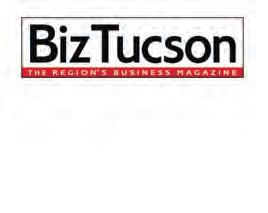
THE REGION’S BUSINESS MAGAZINE SPECIAL REPORTS: Metropolitan Pima Alliance Tucson Airport Authority + Commercial Aviation Sector www.BizTucson.com & SPRING 2023 SPRING 2023 $3.99 DISPLAY UNTIL 06/30/23
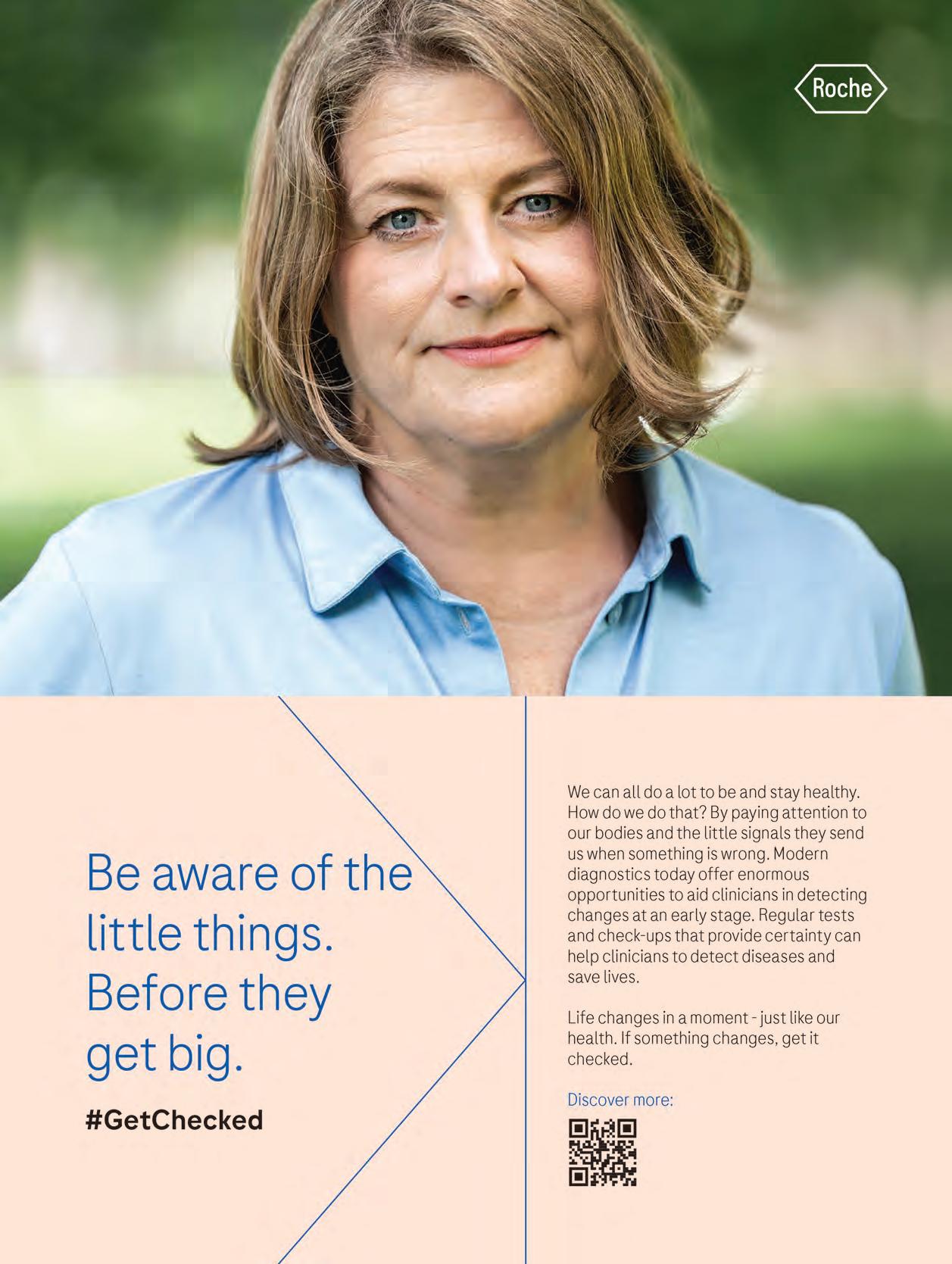



TUCSON AIRPORT AUTHORITY AT 75 REGION’S COMMERCIAL AVIATION SECTOR
The Tucson Airport Authority is truly a community powerhouse. In the 75 years since it borrowed $25,000 to operate the Tucson International Airport, TAA now has an $8.3 billion impact on our region. Not only is the airport, TUS, globally certified for its cleanliness, it is an efficient, easy and proactive airport to navigate and boasts a management team helmed by the daughter of a Top Gun pilot. Freelance journalist Jay Gonzales posts an in-depth report on TAA at 75 and its $1 billion-plus effort to modernize the airport for the future.
Adding to our stellar airport is a commercial aviation sector that is flying high, with numerous private companies on TUS campus and elsewhere throughout the city offering maintenance, repair and overhaul services as well as fixed base operations. The region is working to attract even more with our abundance of airport-adjacent land, sunny skies and Southern Arizona’s commitment to training a skilled workforce. Freelance journalist Dave Perry offers a glimpse of a sector that is taking off.
Metropolitan Pima Alliance celebrates 25 years as this region’s ultimate connector and facilitator. Through its ability to bring together key stakeholders, the organization is a driving force for responsible growth–the result of which includes achievements such as The Chuck Huckelberry Loop, Rio Nuevo and many more. Freelance journalist Romi Carrell Wittman posts an anniversary report on MPA’s legacy.
Though our state recently hosted this year’s Super Bowl, a new report shows that the University of Arizona’s space programs offer this region the same financial windfall with a $560.5 million impact annually. Freelance journalist David Pittman offers up additional insights from the landmark study.
Three decades ago, when Dr. Fayez Ghishan arrived in Tucson, he had a vision for a world-class pediatric research institution and saw promise in Southern Arizona to be its foundation. Freelance journalist Loni Nannini delivers a report on the renowned UArizona Steele Children’s Research Center today that
is a beacon of new discoveries and care for our youngest generations. The center is not only ranked by the National Institutes of Health, it is among the top 20% of all pediatric research institutes at colleges of medicine. We salute Dr. Ghishan and his team for an incredible 30 years.
Father’s Day Council Tucson has been recognizing fathers who have made an indelible impact on this community for 27 years, with all charitable proceeds from its June 4 gala funding the Father’s Day Council Endowed Chair for Type 1 Diabetes research, at the UArizona Steele Children’s Research Center. The 2023 honorees showcase professional and personal excellence. They are Peter Backus, Shane Clark, Vance Falbaum, Reggie Geary and Dave Heeke. BizTucson is proud to profile these five men and their families in this issue.
Speaking of profiles, we also feature the newest recipients of the Greater Tucson Leadership Community Impact Awards. They are Pima Community College Chancellor Lee Lambert as Tucson Man of the Year; Kathy Prather, superintendent of Pima Joint Technical Education District as Tucson Woman of the Year; Founders Award Honoree Jeannette Maré, founder of Ben’s Bells and Diana Charbonneau, development coordinator for IMPACT of Southern Arizona and this year’s Alumni Excellence Award winner.
As always, we are grateful for our loyal readers, our advertisers and our committed editorial team.
Steven E. Rosenberg
Publisher & Owner
BizTucson
Spring 2023 Volume 15 No. 1
Publisher & Owner Steven E. Rosenberg

Creative Director Brent G. Mathis
Contributing Editors Donna Kreutz
Tara Kirkpatrick
Jay Gonzales Romi Carrell Wittman
Contributing Technology Director Mike Serres
Contributing Project Coordinator Maricela Robles
Contributing Writers
April Bourie
Rodney Campbell
Jay Gonzales
Eva Halvax
Tara Kirkpatrick
Christy Krueger
Thomas Leyde
Loni Nannini
Dave Perry
David Pittman
Steve Rivera
Romi Carrell Wittman
Contributing Photographers Brent G. Mathis
Erin McMillon
Chris Mooney
BizTucson News Update (Email Newsletter) Brent G. Mathis
Tara Kirkpatrick
Member:
American Advertising Federation Tucson DM-50
Southern Arizona Leadership Council Sun Corridor Inc.
Tucson Metro Chamber Visit Tucson
BizTucson Magazine Issue 4 (ISSN 1947-5047 print, ISSN 2833-6739 online) is published quarterly for $16 per year by Rosenberg Media, LLC., 4729 E. Sunrise Dr., PMB 505, Tucson, AZ 85718-4534. Periodicals postage pending at Phoenix, AZ, and additional mailing offices.
POSTMASTER: Send address changes to: BizTucson Magazine, 4729 East Sunrise Dr., PMB 505, Tucson, AZ 85718-4534

© 2023 All rights reserved. Reproduction in whole or in part without written permission is prohibited. Opinions expressed in columns or articles do not necessarily reflect the views of the publisher.
BizTucson
Phone: 520.299.1005
Subscription Information: BizTucson.com
subscriptions@BizTucson.com
Advertising information: Steve Rosenberg 520.299.1005 or 520.907.1012
Biz
steve@BizTucson.com
www.BizTucson.com 4 BizTucson < < < Spring 2023
BizLETTER
PHOTO BY STEVEN MECKLER













163 Distinguished



Biz
164 Commercial
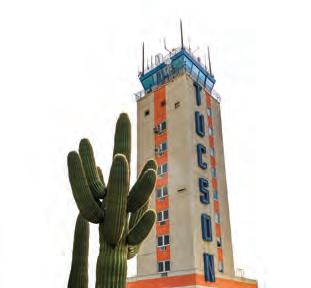
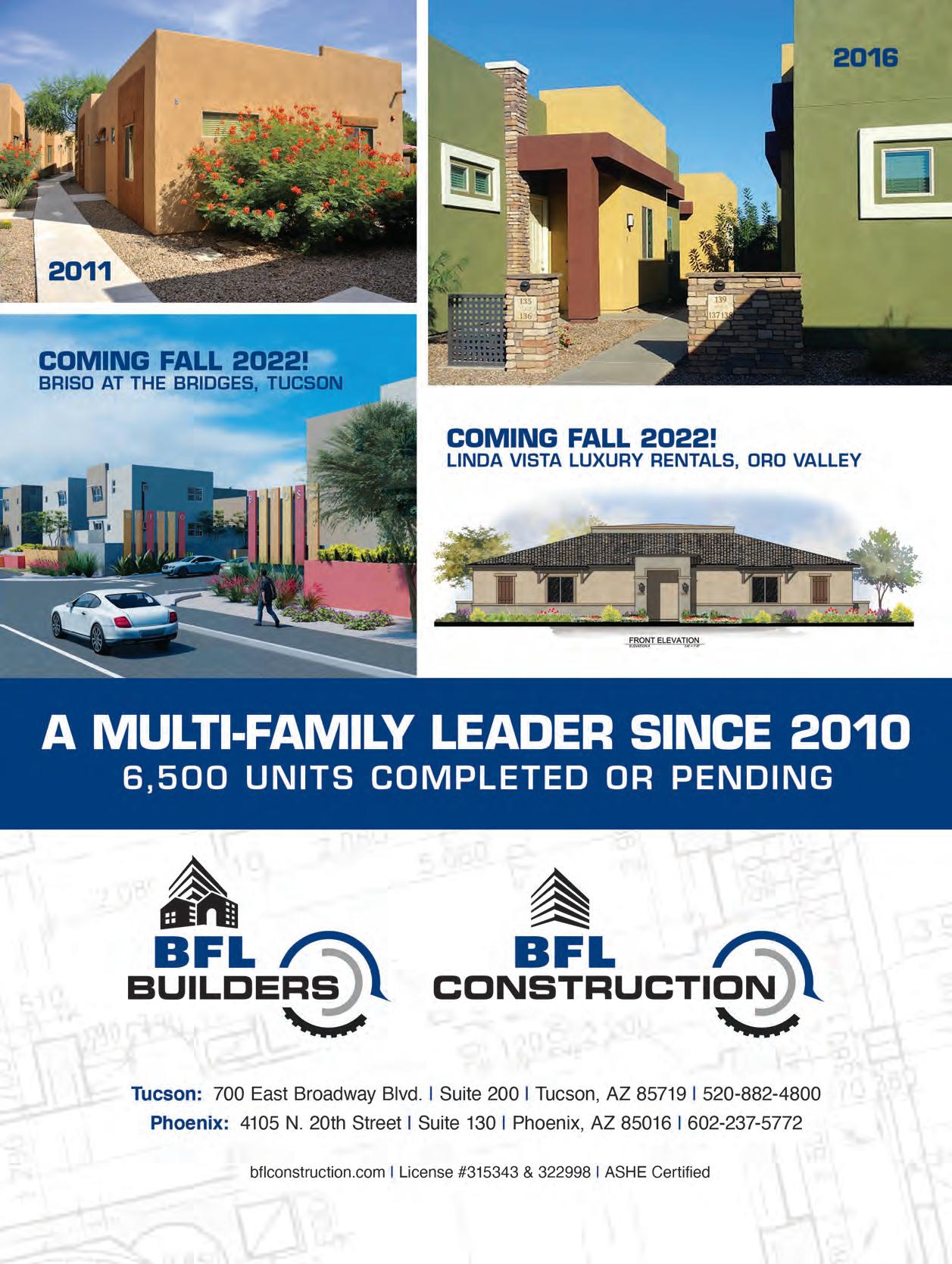















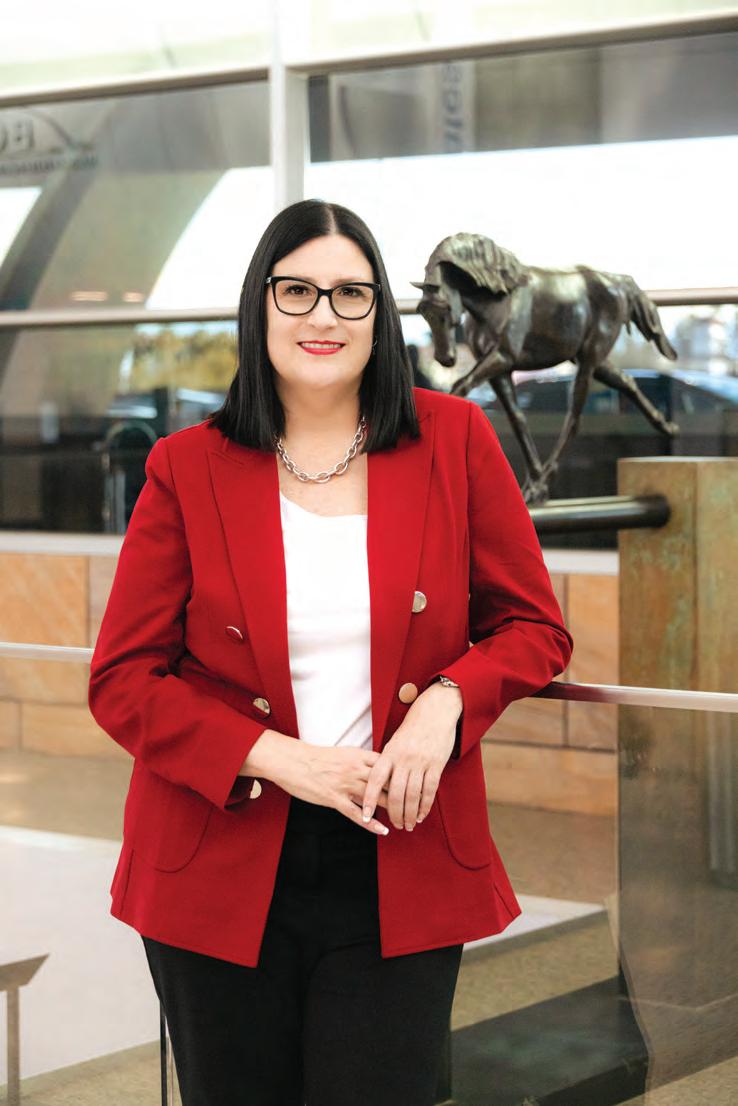



www.BizTucson.com 12 Spring 2023 BizCONTENTS DEPARTMENTS BizLETTER 4 From the Publisher BizSPACE 31 UArizona Programs Generate $560.5 Million Annually BizCHARITY 36 New Gootter-Jensen Foundation Boosts Cardiac Awareness BizMILESTONE 40 UArizona Steele Children’s Research Center at 30 Years 46 The Future of Steele: Advances on Pediatric Cancer, Disease 48 Research Center’s Top Supporters BizHONORS Father of The Year Award Honorees: 52 Peter Backus 54 Shane Clark 56 Vance Falbaum 58 Reggie Geary 60 Dave Heeke BizPRESERVATION 62 Mission San Xavier del Bac BizHONORS Greater Tucson Leadership Community Impact Awards 104 Man of the Year: Lee Lambert 106 Woman of the Year: Kathy Prather 108 Founders Award: Jeannette Maré 110 GTL Alumni Excellence Award: Diana Charbonneau BizAVIATION 114 Commercial Aviation Sector Climbs in Altitude BizTALENT 120 Sun Corridor Inc. Ramps Talent Attraction BizCONSTRUCTION 157 New To Market: Projects in the Region BizHONORS 161 Good Scout Awards Lifetime Achievement Award: Fred Knapp 162 Good Scout Award: Barbi Reuter
Citizen
Lee
Award: Christie
REALESTATE
Real Estate Forecast (CCIM)
WILDLIFE
Wildlife Center
TRIBUTE 170 Don Luria SPRING 2023 VOLUME 15 NO. 1 106 104 FEATURES COVER STORY: 65 TUCSON AIRPORT AUTHORITY’S $8.3 BILLION ECONOMIC IMPACT ABOUT THE COVER Tucson Airport Authority’s $8.3 Billion Economic Impact Creative Design by Brent G. Mathis 65 121 Tucson Airport Authority at 75 Years Metropolitan Pima Alliance at 25 Years SPECIAL REPORT 2023 THE REGION’S BUSINESS MAGAZINE CONNECTING TUCSON FOR 25 YEARS METROPOLITAN PIMA ALLIANCE SPECIAL REPORT 2023 THE REGION’S BUSINESS MAGAZINE SPECIAL REPORTS 65 62
Biz
168 Tucson
Biz





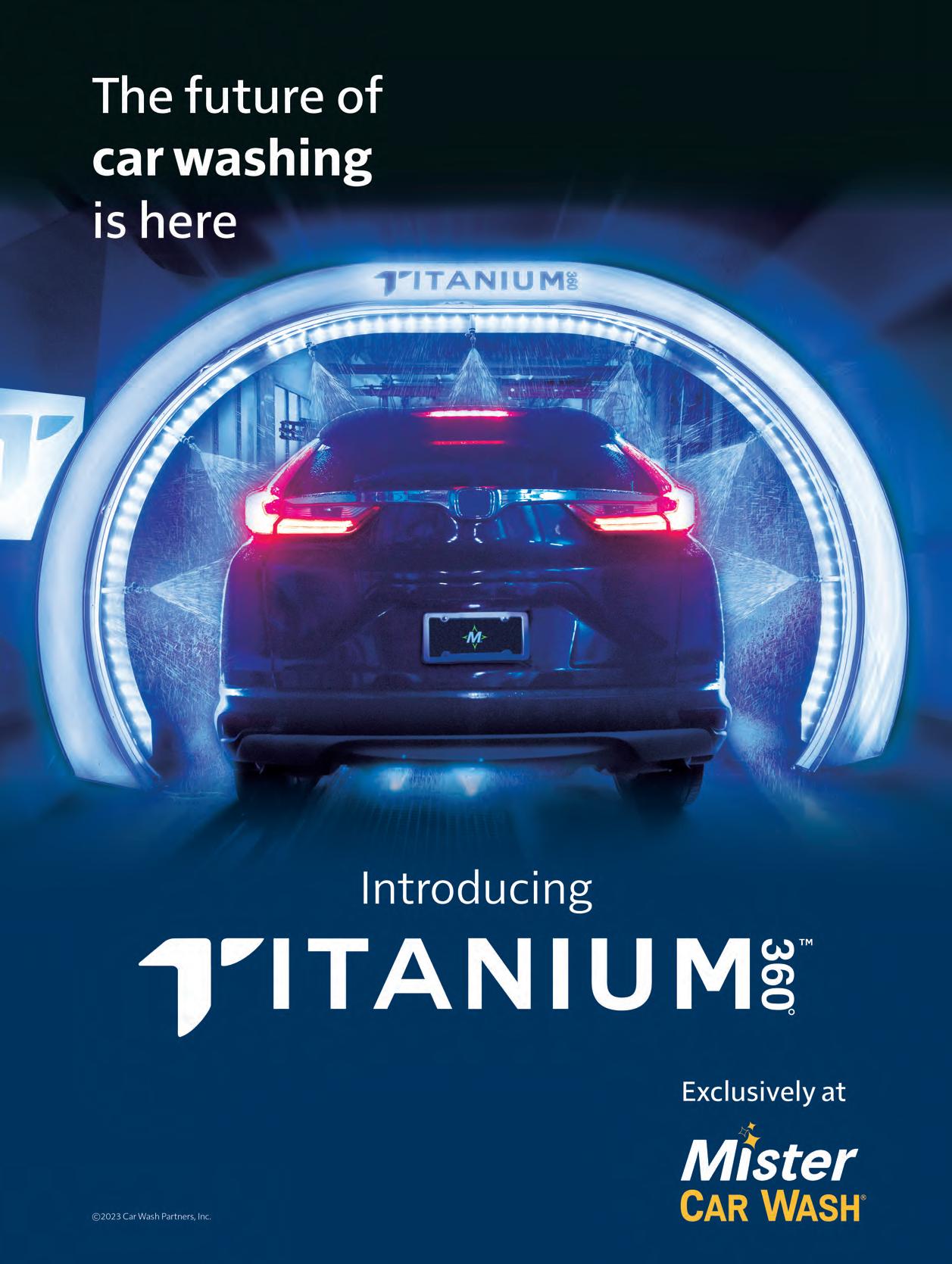










an endowment supporting the nationally recognized cardiovascular center at the hospital. The initiative, totaling $5,000,000, will provide a consistent source of funding to support the center’s life-changing work.
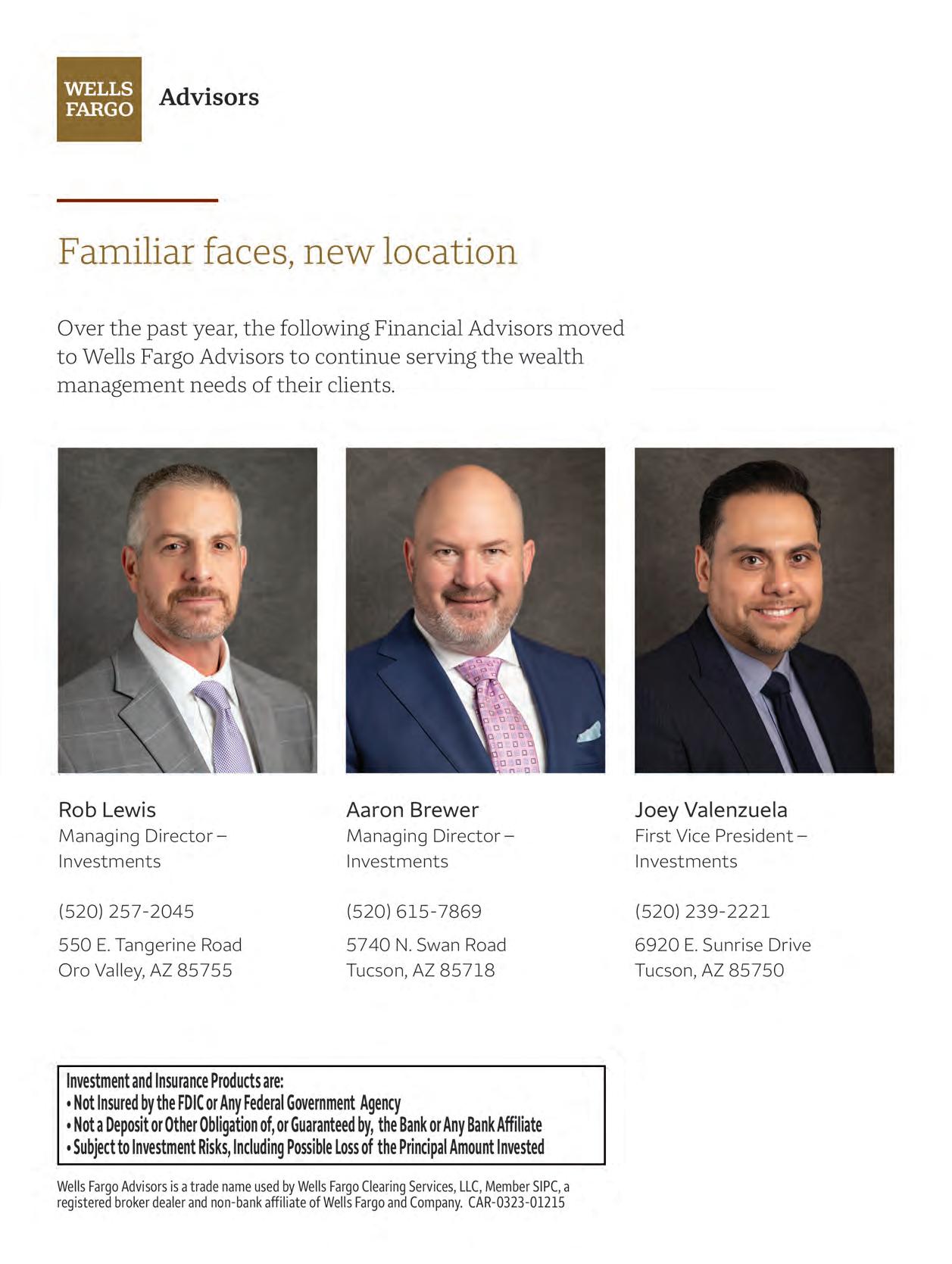
The TMC CardioVascular Center is recognized nationally for innovation and excellence, and this generous gift from the Lopez family reflects the value that the community places on investing in this program. The donation includes a $1 million match, ensuring the long-term sustainability of the center’s important work.
As part of the gift agreement, the program will be renamed the Iliana Maria Lopez CardioVascular Center at Tucson Medical Center. This naming honors the Lopez family’s commitment to the people of Southern Arizona as well as the legacy of cardiac services at TMC and recognizes the outcomes of the work being done by the dedicated physicians and staff every day.


“We are incredibly proud of the work that the TMC CardioVascular Center team does every day to change lives and deliver exceptional care with compassion,” said TMC CEO Mimi Coomler. “This generous gift from the Lopez family will help ensure that we can continue to provide the best cardiovascular care in Southern Arizona and beyond for years to come.”
“My family, like those of many Southern Arizonans, has been touched by cardiovascular illness,” said Humberto. “Contributing to the long-term success of this alreadyprominent program was a simple decision, especially understanding how many people in this community benefit from their lifesaving, cutting-edge treatments.”
22 BizTucson < < < Spring 2023 www.BizTucson.com Biz

Allen Kinnison joined the Southern Arizona Leadership Council as VP, where he will be responsible for infrastructure-related efforts and advocacy. Prior to SALC, he was director of airside operations for Tucson Airport Authority, where he was deeply involved in the $400 million Airport Safety Enhancement project. He also boasts a 29-year career in the U.S. Air Force, including 19 years at Morris Air National Guard Base.


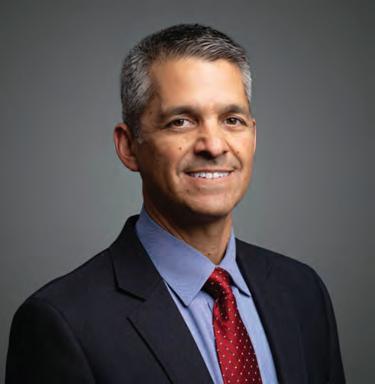
Southern Arizona Leadership Council has named Paula Toomey as its new communications and membership coordinator. She previously served as the communications and membership coordinator for the Arizona Hydrological Society. Before moving here in 2019, she was the communications manager for the Berks County Bar Association in Reading, Pa. and was graphic designer, art director and production supervisor at the National Association of Colleges and Employers in Bethlehem, Pa.

24 BizTucson < < < Spring 2023 www.BizTucson.com BizPEOPLE
Paula Toomey




26 BizTucson < < < Spring 2023 www.BizTucson.com






Space Science is Our Super Bowl UArizona
Programs Generate $560.5 Million Each Year
By David Pittman
When it comes to outer space, the University of Arizona is out of this world.

A new economic impact report by Rounds Consulting Group said UArizona’s astronomy and space sciences operations generate as much money for the local economy every year as a Super Bowl.
The Tempe, Ariz. firm was contracted by UArizona to estimate the economic effects of the university’s astronomy and space sciences operations.
The company’s report, released Dec. 22, estimates the total yearly economic output of the university’s space sciences operations at roughly $560.5 million, as well as roughly $21.1 million in state, county and municipal taxes every year.
“Operational activity in the UArizona Space Sciences drives a significant amount of economic activity and produces a five-to-one return from the $20 million in state funding that brings in over $100 million in grants, philanthropic donations and contracts,” ac-
cording to the study, entitled The Economic Impact of UArizona Astronomy and Space Sciences Operations.
In all, the report noted the $560.5 million impact includes the activity generated by the departments’ day-today operations and its vendors, grant awards, individuals visiting observatories, and employees spending their incomes throughout the local economy.
UArizona and University of Arizona Space Institute have been highly ranked
continued on page 32 >>>
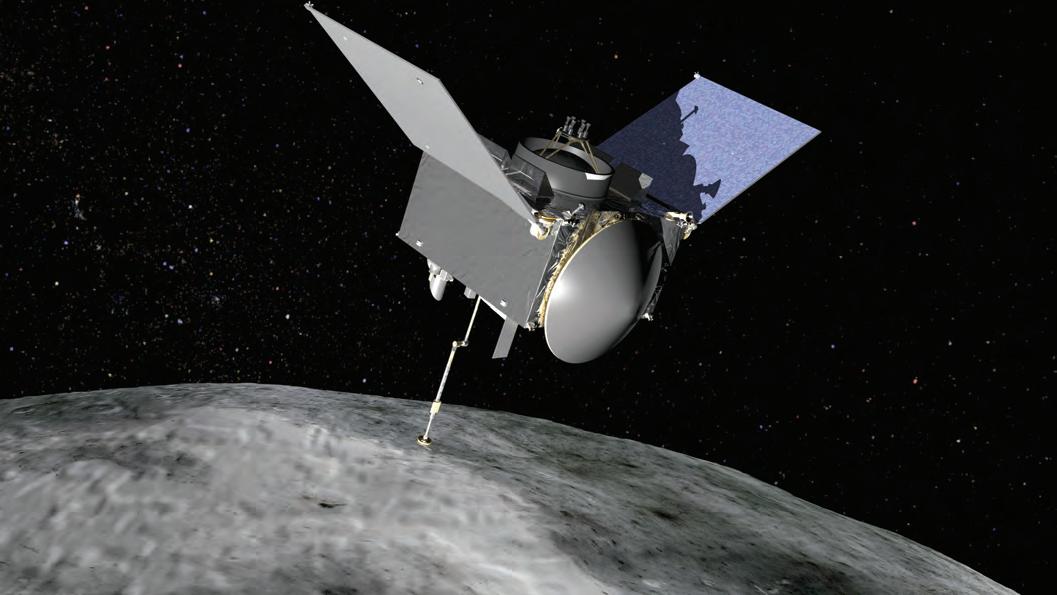
Spring 2023 > > > BizTucson 31 www.BizTucson.com
BizSPACE
OSIRIS-REx
continued from page 31
leaders in space education and research year after year. In fact, according to an annual National Science Foundation Higher Education Research and Development survey, UArizona has spent more annual money on space research than any other U.S. university for more than three consecutive decades.
Tim Swindle, UASI director and a professor emeritus, said the university has an unparalleled space science record among U.S. colleges and universities. UASI’s vision is to be “a driving force in advancing the UArizona role as the world’s leading university for space science, human and robotic exploration, astrobiology/exoplanets research, space situational awareness research, and planetary defense.”
Swindle said with the successful deployment of NIRCam aboard the James Webb Space Telescope, the university has now built instruments for each of NASA’s three great observatories; and the OSIRIS-REx mission, which is due to return a sample of asteroid Bennu to Earth in September. It’s the second deep space mission that UArizona has led.

“No other university has built more than one instrument for the great observatories or led more than one deep space mission,” he said.

Other remarkable space discoveries from UArizona include assisting in the first photography of a black hole and the creation of revolutionary technologies, such as mirrors for the Giant Magellan Telescope.
Key findings of the economic impact study are categorized in terms of job creation, employee-earned wages and benefits, economic output (similar to Gross Domestic Product), and tax revenue.
A summary of those impacts conclude that:
– UArizona Sciences departments, observatories, planetariums and laboratories employ more than 900 fulland part-time persons. However, total operations support more than 3,300 full-time equivalent direct, indirect and induced employees. All those workers produced nearly $194 million in earned wages and benefits last year.
– Taxes produced from employee wages, employee-owned property, spending on everyday items, visitor spending, and operations of UArizona Space Sciences generate more than $21 million in tax revenues each year to state, county and municipal governments annually.
Swindle said the study will not only help draw quality staff and students interested in space exploration and research to the university, but also bolster regional awareness about the programs’ economic importance.
“Operations of the UArizona Astronomy and Space Sciences departments are significant economic drivers in the state and specifically in the Tucson metro area,” the report said.
“Advanced fields such as aeronautics, engineering and space sciences, among others, are of high concentration in the Tucson area due to UArizona’s efforts and the tens of millions in federal grants, state resources and donations the UArizona Space Sciences bring in leading the state in development of new technologies, research, creation of high-paying jobs and exploring new frontiers.” Biz

32 BizTucson < < < Spring 2023 www.BizTucson.com
James Webb Space Telescope
Giant Magellan Telescope
“No other university has built more than one instrument for the great observatories or led more than one deep space mission.”
– Tim Swindle Director University of Arizona Space Institute
BizSPACE


Spring 2023 > > > BizTucson 33 www.BizTucson.com



34 BizTucson < < < Spring 2023 www.BizTucson.com

ing research and distributing automated external defibrillators, or AEDs.
Its main fundraiser is an annual gala and tennis exhibition at Westin La Paloma Country Club that features prominent former professional tennis players. Between sets, they demonstrate chest

“So much of my life is divine intervention,” said Jensen. “It was an accident that I became a part of Gootter due to Mats Wilander.” Looking back, Jensen believes coming to Tucson was the most important trip he ever made. continued on page 38 >>>
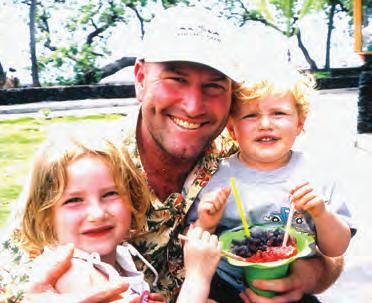
36 BizTucson < < < Spring 2023 www.BizTucson.com
BizCHARITY
Bob Bryan, Murphy Jensen, Mike Bryan and Andrew Messing
Steve Gootter with Sophie & Max

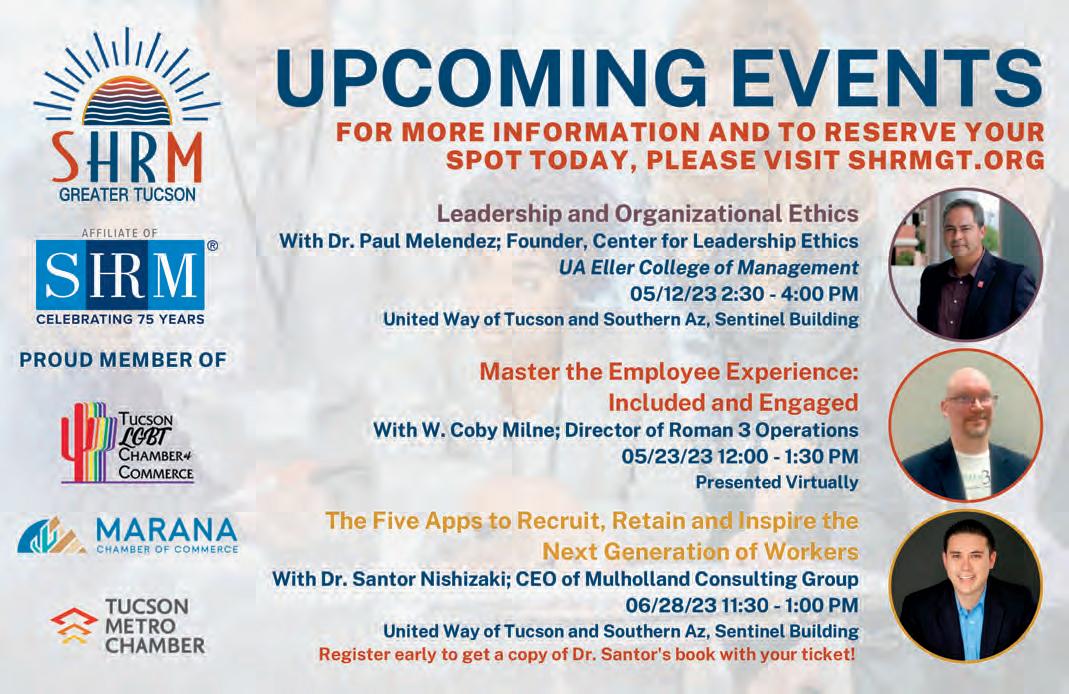
Spring 2023 > > > BizTucson 37 www.BizTucson.com
continued from page 36
Nine years later, Jensen experienced a life-changing event. While playing an exhibition tennis match with his brother in Colorado, his heart failed. Fortunately, the facility had an AED. Once he reached the hospital, doctors induced a coma due to a serious head injury he suffered when he fell to the court. Nobody knew if he’d survive and if he did, what kind of abilities he would regain. Today, he is fully recovered and playing tennis again.
“Murphy has a new lease on life,” Messing said. “He came very close to not making it. He was down 18 minutes and had six shocks before being brought back to life. He’s a very lucky guy and he’s very grateful he’s alive. He wants to make a difference.”
Jensen stressed his thankfulness. “I never should have lived. I’m so full of gratitude and love that I’m here. I never imagined I’d be saved by the techniques I learned and demonstrated at the Gootter event. The time is now and the life we live is a gift.”
After surviving cardiac arrest and being presented the Gootter Philanthropy Award in 2022, Jensen wanted to do more. He talked to Messing about starting his own foundation, but Messing had other plans.
“I told him our missions are very much aligned. He wanted to use his relationships to help Gootter on a national and international level,” Messing said. They agreed to form an official partnership and change the name to Gootter-Jensen Foundation. Although the annual event will continue in Tucson, Messing and Jensen want to add similar events in other Western cities.
“I’m humbled to have a bigger role, and my story can help others. One place I can make an impact is in the tennis world and my partnership with the American Heart Association,” Jensen said. He also wants to make it mandatory for cities to have AEDs in police cars. “If it means standing in front of Congress to get a bill passed – I’ll go all the way until I’m on my last leg.”
“Murphy and I have a wonderful working relationship,” Messing said. “When I spend time with him, I think of Steve Gootter – they are kindred spirits. When they walk into a room, it lights up. Steve passed so others can live, and Murphy survived to help others survive.”
La Paloma Country Club
Saturday, April 15
4:00 PM Wheelchair, UA Tennis Team, and Pickleball Exhibition
5:00 PM Celebrity Pro Exhibition
6:00 PM Gootter Grand Slam
Gala Dinner & Auction
Tickets $300/pp
Sponsorships available at: www.gootter.org

38 BizTucson < < < Spring 2023 www.BizTucson.com
Biz
BizCHARITY
2023 GOOTTER GRAND SLAM
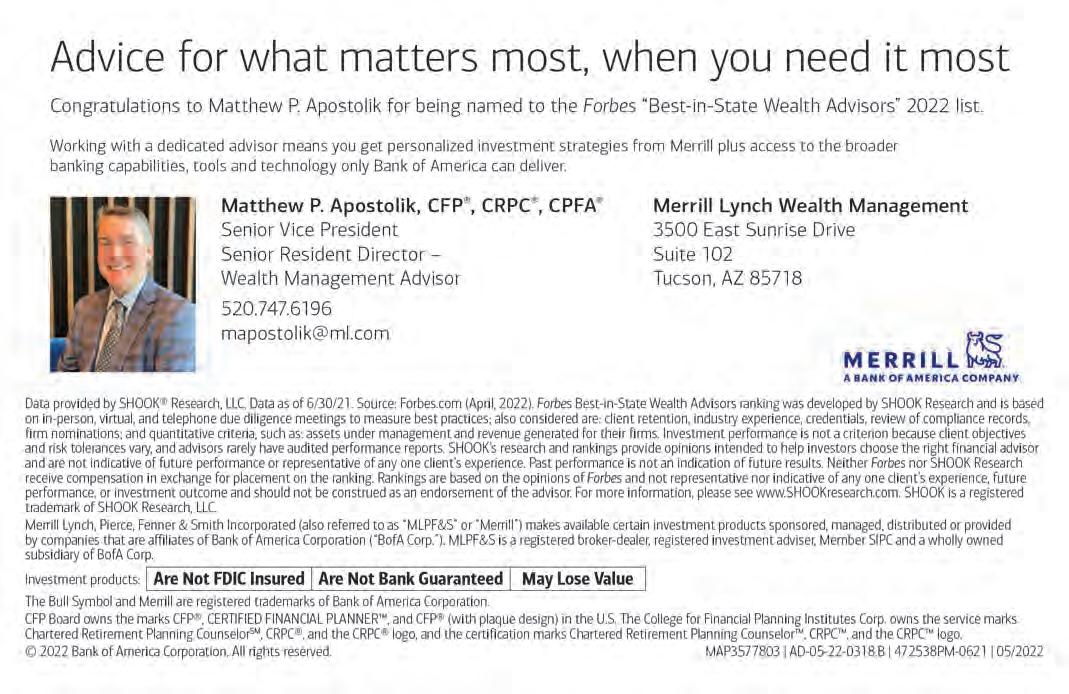

Spring 2023 > > > BizTucson 39 www.BizTucson.com
Director,

www.BizTucson.com 40 BizTucson < < < Spring 2023
PHOTO BY BRENT G. MATHIS
Dr. Fayez K. Ghishan
Steele Children’s Research Center
A Beacon for Pediatric Care
UArizona Steele Children’s Research Center Celebrates 30 Years
By Loni Nannini
Vision and passion converge with scientific innovation at the University of Arizona Steele Children’s Research Center as it celebrates three decades of groundbreaking pediatric research and health care in the region.
“I have been a doctor every day for 56 years. I have a vision to improve the lives of kids, but at the end of the day, it takes vision coupled with passion to save children’s lives,” said Dr. Fayez K. Ghishan, PANDA endowed director of the Steele Children’s Research Center.
Ghishan, also a UArizona College of Medicine-Tucson professor of pediatric gastroenterology and nutrition and Physician-in-Chief of Banner Children’sDiamond Children’s Medical Center, holds two other endowed positions: The Horace W. Steele Endowed Chair in Pediatric Research and the Alan and Janice Levin Family Endowed Professor of Pediatrics. He is also medical director of UArizona Clinical and Translational Sciences Research Center.
Ghishan has manifested his vision for exceptional research, education and treatment when he took the helm of a burgeoning Steele Center that was seeded with $2 million by the late Daniel Cracchiolo and the Steele Foundation. A renowned expert in pediatric gastrointestinal diseases, Ghishan has grown the center into a world-class institution dedicated to advancements in research and therapies for more than 60 childhood diseases.
“When I came to Steele 28 years ago, I promised to make it successful,” Ghishan said. “Now we are ranked by the National Institutes of Health as a
Center of Excellence and are in the top 20% of all pediatric research institutes at colleges of medicine.”
That ranking has attracted more than 80 faculty members and grant support in excess of $150 million from the NIH and other federal institutions.
ter of Excellence dedicated to basic and translational research for pediatrics for 7.5 million people in the state of Arizona,” said Ghishan.
Integral to this role is the partnership with Banner Children’s-Diamond Children’s Medical Center, which serves as the clinical arm of Steele Center. Spearheaded by Joan and Don Diamond, the facility boasts 80 private rooms, a 36bed NICU, state-of-the-art inpatient and outpatient pediatric cancer clinics, two dedicated pediatric neurosurgeons, a fetal medicine surgeon, and the only haploidentical bone transplant program in Southern Arizona.
Steele’s affiliation with UArizona offers another major advantage, according to Ghishan. Collaborations between the medical school and professors and researchers within numerous university departments and colleges propel research in cardiology, critical care, endocrinology, gastroenterology, hepatology and nutrition, genetics and developmental pediatrics, hematology/ oncology/HCTT, neonatology; pulmonology, and allergy and immunology.
Steele has expanded to 28 labs with 32,000 square feet dedicated to benchto-bedside pediatric research and treatment that impacts 35,000 children and their families annually. Steele-affiliated laboratories have published 600 peerreviewed scientific journals, many of which have earned global recognition.

“The Steele Center is the only Cen-
“The Steele Children’s Research Center is a vital part of the University of Arizona’s service to our great state. It has 30 years of incredible impact in the lives of the children and families of Arizona. Our expert faculty and researchers are world-renowned leaders in pediatric care, and I am very proud of the work they are doing to tackle the biggest challenges in treating and understanding childhood diseases. I know the Steele Center will build on its
continued on page 42 >>>
Spring 2023 > > > BizTucson 41 BizMILESTONE
“When I came to Steele 28 years ago, I promised to make it successful. Now we are ranked by the National Institutes of Health as a Center of Excellence and are in the top 20% of all pediatric research institutes at colleges of medicine.
”
– Dr. Fayez K. Ghishan Director, Steele Children’s Research Center
30-year foundation of excellence and I am excited for its future,” said UArizona -
sion as a land grant university is to serve community,” he said. “We want patients to get the best start in life. We want all children with cancer and other diseases to be able to stay in Southern Arizona for treatment and clinical trials. In fact, our survival rate is among the highest in the nation, which we should all be proud of.”
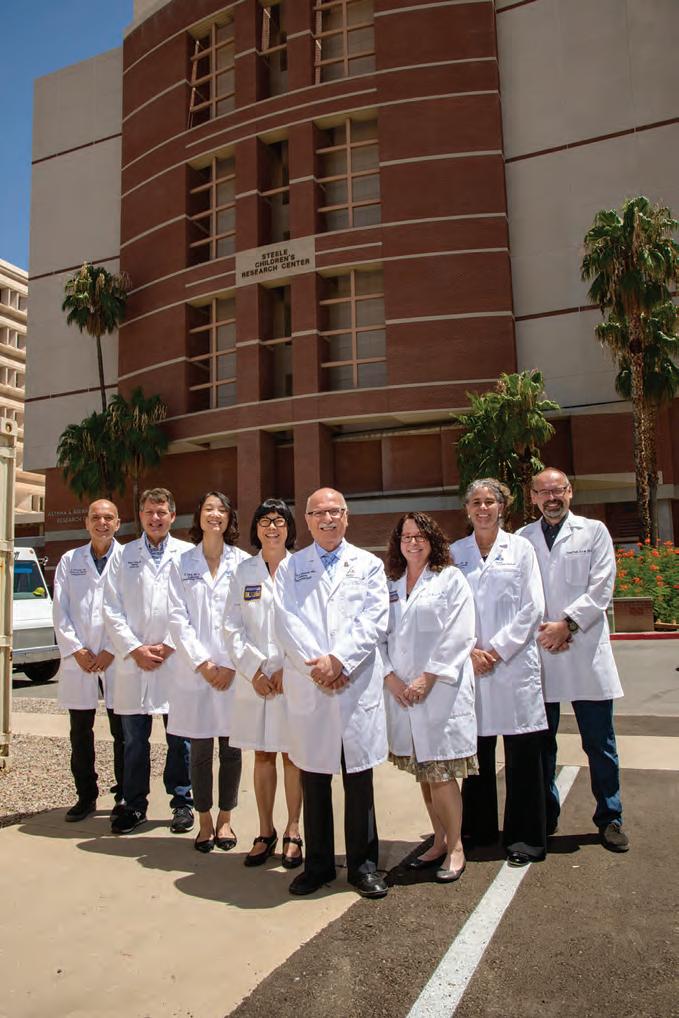
Partnerships Promote Teaching, Healing and Discovery
Another key component of Steele’s success is the private and public partnerships that Ghishan and his colleagues have nurtured regionally, statewide and nationally with academic institutions,

invaluable community network.
That support is complemented by $5
(People Acting Now Discover Answers)
“These are the engine that drives the Steele Center,” Ghishan said. “Without them, our work would not be possible. My colleagues and I use the money they raise to help generate solid preliminary data we need to submit grants to the NIH and other institutions.”
Steele puts those grants to work treating sick children and providing pediatric well-checks, training future clinicians and stocking labs with top equipment.






“Our task is to teach medical students and residents, to heal by seeing clinical patients and to make new discoveries,” he said. “Every day, science is moving and changing and the Steele Center is at the forefront of all major advances in children’s health.”
continued on page 44
42 BizTucson < < < Spring 2023
>>>
BizMILESTONE
2017 PANDA Event
From left Dr. Emmanuel Katsanis, Dr. Michael Daines, Dr. Yi Zeng, Hua Xu, Dr. Fayez K. Ghishan, Melissa Halpern, Dr. Sydney Rice, Pawel Kiela
Hua Xu and Dr. Fayez K. Ghishan
Danny, April & Ed
20TH ANNIVERSARY: FATHER OF THE YEAR AWARDS SPECIAL REPORT: COMMERCIAL REAL ESTATE, CONSTRUCTION & DEVELOPMENT Dr. Fayez K. Ghishan (center) leads team of world-class researchers and physicians at The University of Arizona Steele Children’s Research Center
Stella & Laurel
Scientists of Steele featured on the Spring 2014 cover of BizTucson
COVER PHOTO BY STEVEN MECKLER




Spring 2023 > > > BizTucson 43 www.BizTucson.com
continued from page 42
Emerging Disciplines for Future Success
Steele seeks to stay on the leading edge with a three-fold emphasis on the emerging fields of pediatric autoimmune diseases, genomic medicine and developmental behavioral pediatrics.
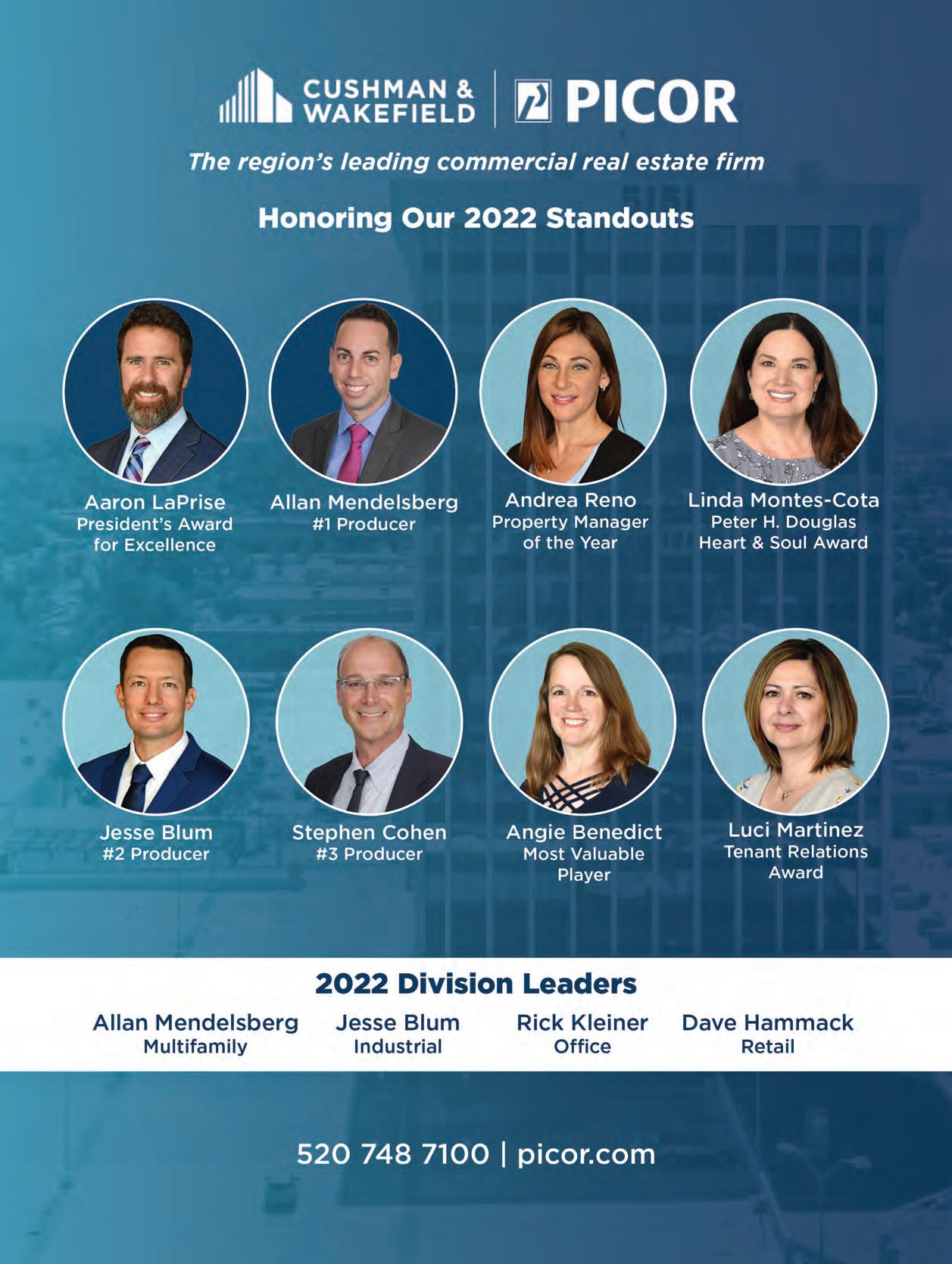
This focus on autoimmunity was fueled by a recent $10 million private donation to establish the Daniel Cracchiolo Institute for Pediatric Autoimmune Disease Research at Steele Center. The gift will provide financial support for graduate students, postdoctoral researchers and faculty members to study autoimmune diseases such as Type 1 diabetes, juvenile arthritis, lupus, inflammatory bowel disease and celiac disease. The new endeavor will be affiliated with the planned UArizona Health Sciences Center for Advanced Molecular and Immunological Therapies.
The implications are far-reaching: Autoimmune diseases afflict 40 million Americans and new cases are increasing disproportionately among women and children.
“More than 100 autoimmune diseases are currently known and every day a new autoimmune disease is being discovered. If you have one autoimmune disease, your risk of having others is exceedingly high. That is why we are concentrating on understanding them,” said Ghishan.
Autoimmune research dovetails with the study of genomic medicine and Steele is on the front lines with state-of-the art equipment and tools such as the NovaSeq 6000–a gift from PANDA that sequences the human genome in less that 40 hours. The tool has numerous applications.
“When we don’t know the cause of a patient’s illness, we can do whole genome sequencing and discover the answers in more than 55% of cases so we can treat patients right away,” said Ghishan.
Genomic medicine is also integral to the development of precision nutrition and precision medicine, which are revolutionizing the field of developmental behavioral pediatrics
“Precision nutrition and precision medicine is data-driven based on our genomes. We can check your genome and tell you what foods you need to eat or what medications you need to take. This is the medicine of the future,” said Ghishan.

Data also drives Steele’s designation as a Children’s Postinfectious Autoimmune Encephalopathy Center of Excellence and establishment of a new Pediatric Developmental Behavioral Fellowship to address the nationwide shortage of such pediatricians.
These endeavors are synonymous with the cutting-edge fusion of basic and clinical medicine and research for which Steele Center has become renowned in Arizona and beyond.
“The goal of medicine is to save people’s lives. If I see a patient in the clinic, I might treat him and make him better and that is great. And if I spend the day in the lab, I may discover something that will save 1,000 kids. That is what I hope for,” Ghishan said.
44 BizTucson < < < Spring 2023 www.BizTucson.com
Biz BizMILESTONE

The Future Researchers Advance on
By Loni Nannini
At Steele Children’s Research Center, a cadre of talented researchers, physicians and community partners are paving the road to reinvent—and revitalize—the wheels of research.
“We have numerous scientific collaborations between faculty from different divisions, departments and colleges within the University of Arizona and with other universities across the country and in Europe,” said Pawel Kiela, associate director for basic science research at Steele Children’s Research Center.
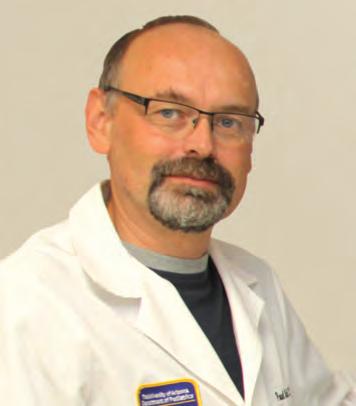
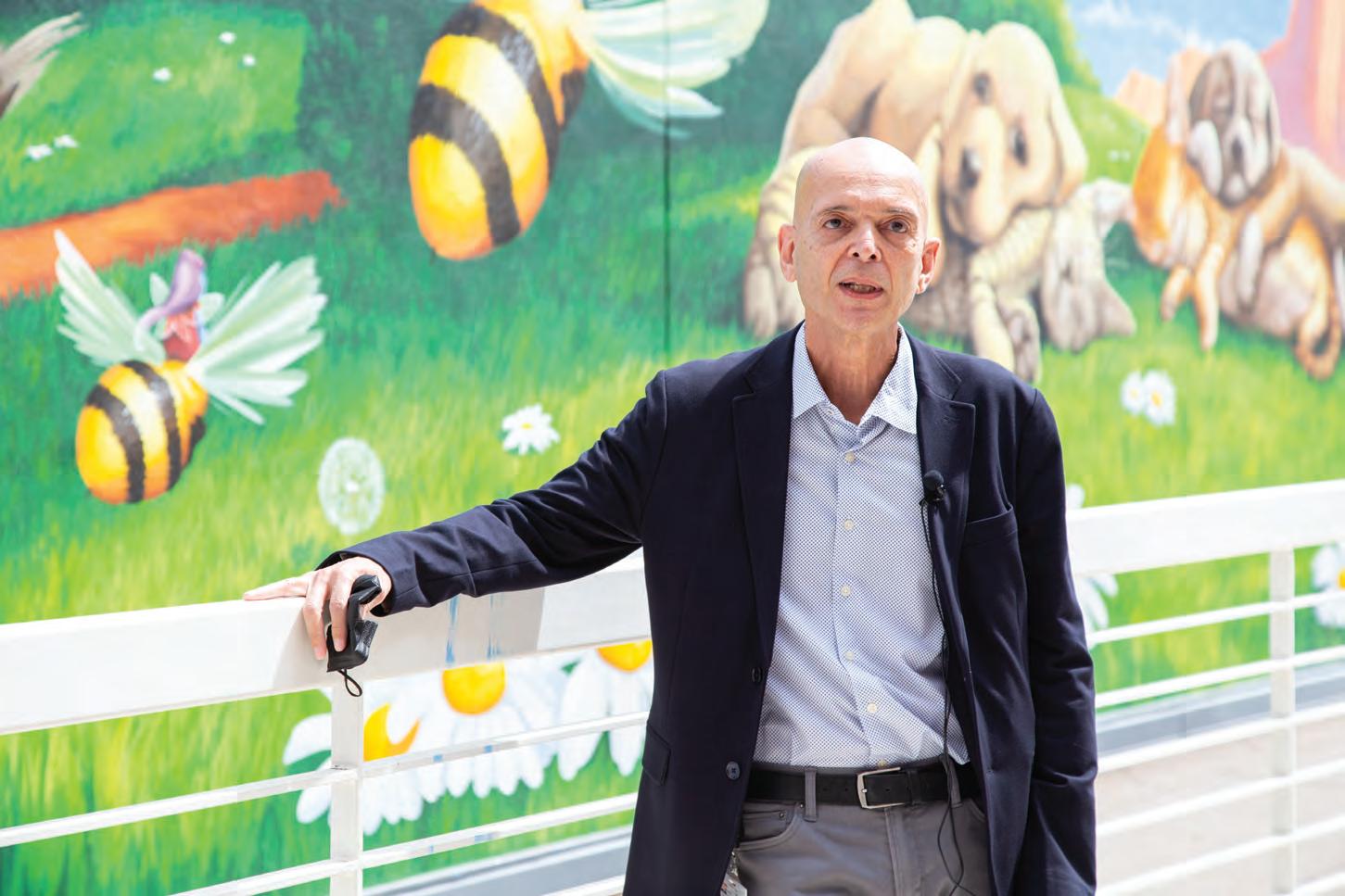
“Collaborations within the community are also essential to us: The philanthropic support we have received over the years from organizations, businesses and individuals has enabled us to build a research infrastructure with the spaces, equipment and tools that scientists and clinicians need to succeed. These form the spokes of the wheel now and in the future.”
Kiela, also a PANDA Endowed Professor in Autoimmune Disease Research at Steele. is among the emerging lead-
ers devoted to framing research in the context of human disease.
“To use a common colloquialism, we strive to ‘see the forest through the trees,’—i.e., to apply advanced molecular techniques to foster our knowledge of the disease,” said Kiela.
A Multi-Systems Approach
Steele scientists often start from the top down, working from the clinical bedside to the bench in hopes of eventually returning research results and diagnostics to the bedside.
Ultimately, Kiela and his colleagues strive to understand not only the basic fundamentals of individual processes of diseases, but also the integration of multiple organs in those processes.
This multi-systems approach is effective in every area of research, including autoimmune diseases and autoinflammatory diseases—and the evolving definitions of both. This focus area plays a key role in the post-pandemic world and in the future of Steele.
“We used to think that in developed
countries, fewer infectious diseases correlated with increased rates of autoimmune disorders,” he said. “The pandemic upended this notion in some respect. We increasingly understand that with some infectious diseases often come dysregulated immune responses that target one’s own tissues in a nondiscriminatory way. Even an infection such as coronavirus can have an autoinflammatory component and there is emerging evidence that some autoimmune diseases may arise as complication to infection.”
Kiela is doing his part to investigate: His latest research explores the role of the gut microbiota in regulating the immune responses that can adversely affect the brain in children with post-infectious autoimmune encephalopathy. His other work continues to revolve around aspects of chronic intestinal inflammation, including inflammatory bowel disease and IBD-associated changes in the gut-bone axis in relation to osteopenia and osteoporosis in children and adults.
46 BizTucson < < < Spring 2023 www.BizTucson.com
Dr. Emmanuel Katsanis
Pawel Kiela
of Steele
Pediatric Cancer, Disease
Cutting-Edge Cancer Research, Therapies
Additional groundbreaking research is in the works by Dr. Emmanuel Katsanis, chief of the Tucson-Phoenix Integrated Division of Pediatric Hematology/Oncology and director of the Banner University Medical Center / UArizona Cancer Center Hematopoietic Cellular Therapy and Transplant Program.
Katsanis has garnered a national reputation for the pediatric haploidentical—or “half-matched” bone marrow transplantation program at Banner. With survival rates greater than 80% and equivalent to those of matched sibling transplants, Katsanis and his team put Steele on the map for research in haplo-BMTs. His research group had previously pioneered the development of a cancer cell vaccine.
Most recently, Katsanis and Steele researcher Richard Simpson were awarded a $3 million-plus grant by the National Institutes of Health for their work on the effect of exercise on hema-

tologic cancers, primarily leukemias in children.
“We are studying the effects of exercise on the human immune system, which includes different lymphocyte subsets such as NK and T-cells which can kill leukemia after bone marrow transplantation. We are trying to understand what exercise does to make these cells more effective against human leukemia,” said Katsanis.
Looking ahead, he is optimistic that continued recruitment will further expand research and development of therapies for pediatric cancer at Steele.
“With more researchers to collaborate, we can move science forward to better the lives of kids,” said Katsanis.
A Pipeline for Future Pediatricians, Researchers
Recruitment is also a priority for Dr. Sydney Rice, a professor in UArizona’s Department of Pediatrics.

Rice, one of three developmental behavioral pediatricians at Steele, is building a pipeline from high schools,
colleges, medical schools and residency programs to a Pediatric Developmental Behavioral Fellowship. Steele also boasts three developmental behavioral nurse practitioners.
Training of future professionals in this field is key to identification and intervention for autism and other behavioral disorders, developmental disabilities and mental health issues.
Rice described developmental behavioral pediatricians as “interpreters of how children are thinking.” They can utilize genetic testing, cognitive testing and behavioral assessments to help families and children understand and manage these conditions.
“Almost every biological condition that children are treated for at Steele has a developmental behavioral pediatric component to it,” she said. “There is a great need for more of us and that need will continue to grow in the future.”
Spring 2023 > > > BizTucson 47 www.BizTucson.com BizMILESTONE
Dr. Sydney Rice
Biz
Richard Simpson
Strength for Steele
UArizona Steele Children’s Research Center’s Top Supporters
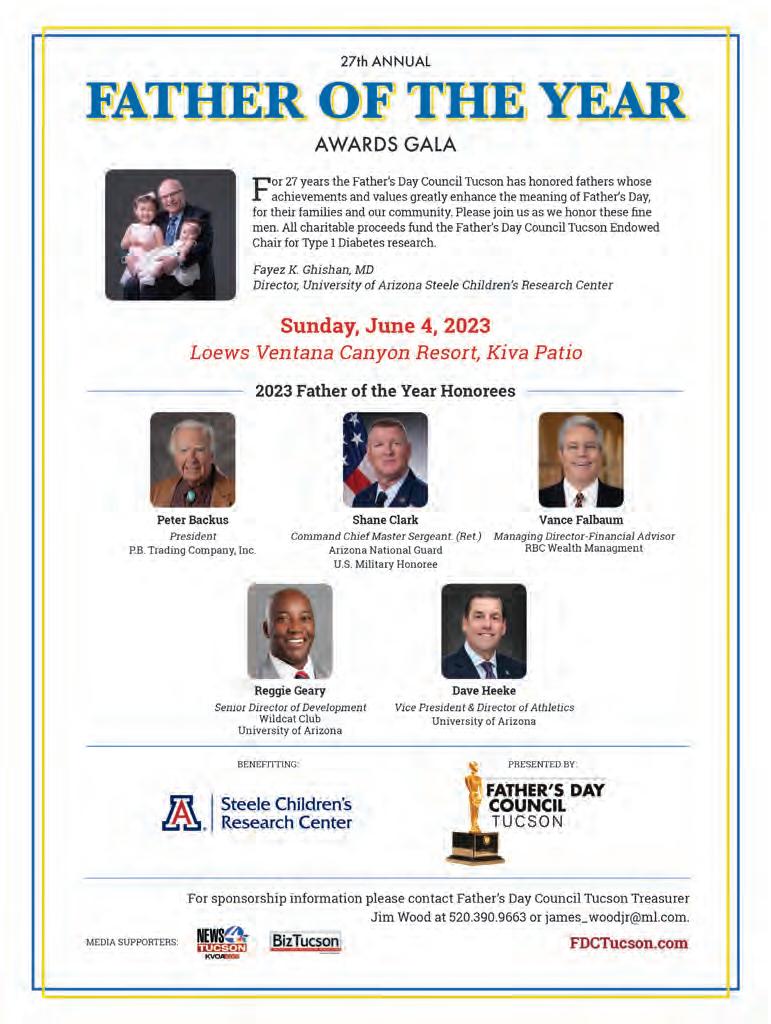
 By Loni Nannini
By Loni Nannini
Angel Charity for Children

Angel Charity for Children, Inc. announced in March that it selected the Steele Children’s Research Center as the recipient for its 2023 major fundraising campaign. Angel Charity will launch fundraising efforts to raise $800,000 this year to fund the renovation of five labo ratories and one research office space for genetic research, in order to provide state-of-the-art genomic testing for chil dren in Pima County.
Since 1983, Angel Charity has raised over $31 million to fund more than 129 different local children’s organizations. These dollars have been used to con struct new buildings, renovate and ex pand old ones, fund scientific research, retire mortgages and support muchneeded programs.
children have benefited from the ser vices that Angel Charity and its donors have funded over the years.
AngelCharity.org

Arizona Elks Major Projects
Like Steele Children’s Research Cen ter, the Arizona Elks are an institution.
They are also visionaries who have supported Steele Center with $12 mil lion in funding and multi-year pledges since its inception.
On clinical, research and education
fronts, these dollars have translated into the Arizona Elks Pediatric Clinic, the Arizona Elks Laboratories for Translation Research, and the Marvin Lewis Teaching Center, a medical education
would fight pediatric cancer, and so Tee Up For Tots, Inc. was born. The group’s signature event is the Tee Up For Tots Golf Tournament held every August. The nonprofit changed its name ney’s Courage in 2016, and have raised approximately $600,000 for pediatric cancer reseach at the Steele Children’s Research Center.
Father’s Day Council Tucson
Founded in 1994, the Father’s Day Council Tucson has annually paid tribxemplary fathers who are successful in their chosen fields and serve role models in the community. In the process, it has raised more than $4.5 million to support Type 1 diabetes research, since its inception. In 2008, ather’s Day Council Tucson Endowed Chair in Type 1 Diabetes Rewas established to ensure the inued impact of their efforts to fund research and new treatments in Type 1 diabetes at the Steele Children’s Research Center. The group also funds a llowship in pediatric endocrinology to train future clinicians.
continued on page 50 >>>

48 BizTucson www.BizTucson.com
BizMILESTONE

continued from page 48
Kids of Steele
Kids of Steele are superheroes in their own right.
The auxiliary organization of children, families and friends that support Steele Children’s Research Center has raised more than $1 million to fund research and education at the center. Support services also include the Kids of Steele Rock Garden along with snacks, crafts, gift bags and other projects for patients and siblings. Fundraisers have also provided funds for pilot projects that can be leveraged into larger grants from the National Institutes of Health and other organizations.

“Kids of Steele provides an educational platform for parents to teach their children about hands on service, about the importance of health through personal interactions with patients and about giving back to the community to make it stronger,” said Michelle Rooney, 2022 president of Kids of Steele.
KidsOfSteele.org
PANDA (People Acting Now Discover Answers)
PANDA is more than a warm and fuzzy acronym: It is a call to action by the Phoenix Women’s Board of the Steele Children’s Research Center. Since 1999, the auxiliary support group has raised more than $26 million for Steele. PANDA’s signature fundraiser, the Children Helping Children Fashion Show in Phoenix, and other activities have become synonymous with determined, successful women who support top research.

Recent initiatives include the PANDA Genome Sequencing Project facilitated by purchase of the NovaSeq 6000 System, a state-of-the-art machine that can sequence the genomes of 48 children in as little as 40 hours. Key information about changes in DNA and RNA can facilitate diagnosis and treatment of cancer, diabetes, epilepsy, and other pediatric chronic illnesses. Another effort, PANDA’s First 1,000 Days Pediatric Project, supports translational research into pediatric nutrition and to advance technology in treating congenital heart disease.
AzPanda.org
50 BizTucson < < < Spring 2023 www.BizTucson.com
Biz BizMILESTONE


52 BizTucson < < < Spring 2023
2023 FATHER OF THE YEAR HONOREE
From left: Chris, Peyton, Cameron, Jack and Jamee Emens (daughter), Peter and Debbie Backus, Rylee, Brody, Jenny and Ted Liles.
PHOTO BY ERIN MCMILLON
Peter Backus
Loving Father, Grandfather and Big Brother
By Rodney Campbell
One of this year’s Fathers of the Year has also been a good Big Brother.
Peter Backus, president of P.B. Trading Company, has three kids in a blended family with his wife of 25 years, Debbie. From their previous marriages, Peter has a daughter, Jamee, and Debbie has two sons, Ted and Trevor.

Beyond helping his own children, Peter has been involved with the Big Brothers Big Sisters of Southern Arizona since the late 1970s. A 1963 University of Arizona graduate, he moved back to Tucson in 1978 after more than a decade away.
“I saw a sign for Big Brothers Big Sisters and went in for an interview,” Peter said. “They asked if I wanted to visit one of the children and I said yes. It clicked immediately.”
The boy he met was 9-year-old David Roberts, who lost his father in a mining accident seven years earlier. David, now a software instructor for Simpleview, needed a positive male role model.
“It was a critical time in my life,” David said. “I was happy and doing well, but there was a void.”
An avid outdoorsman, Peter took the young David camping, fishing, hunting and horseback riding. he accompanied Peter on camping trips with Jamee and other kids. Jamee and David also have birthdays within a week of each other.
“I used to do father-son, fatherdaughter trips,” Peter said. “I would organize them for my good friends. It was great to see Jamee and David get along so well.”
A good high school student, David had a rough transition to UArizona. Thankfully, Peter was there with words of advice and, after transferring, David graduated from Northern Arizona University with a sociology degree–the first from his mother’s side of the family to graduate college.
“He was incredibly helpful during that first year,” he said. “He helped me decide to chart a new course. I sometimes wonder if I would have dropped out of college and not finished without Peter.”
Peter’s influence was more personal several years ago when a family medical issue began his involvement with the Steele Children’s Research Center. His daughter’s triplets started experiencing medical problems when they were 3. By chance, he met the renowned Dr. Fayez K. Ghishan, Steele’s director, around that time and told him about the kids.
“I told him my grandchildren were having problems and he gave me his phone number and said to have Jamee call him,” Peter said.
Physicians were able to treat the children and control their medical issues. Now teens, the three kids have better lives thanks to the physicians, scientists and research done at Steele. Peter soon became a Steele board member and board chair, while Jamee is a member of the Phoenix Women’s Board for Steele – PANDA“Peter has a long history of leadership on nonprofit boards in Tucson,” Ghishan said. “It is an exciting time for Steele, and we know
that Peter has the experience to help us move to the next level.”
The Backus family has been supportive of Steele’s mission for many years. For more than 20 years, Debbie ran an annual fundraiser that supported Steele and Big Brothers Big Sisters.
“We raised a ton of money and had a lot of fun,” Debbie said.
It’s no surprise that the event she organized, called the Coyote Creek Ride and Fiesta, involved horses. She and Peter raised their grandkids to enjoy the outdoors at a home on 10 acres where they used to live part-time in Idaho.
“He loves to put his grandkids on horses,” Debbie said. “He interacts with them fabulously.”
Peter has stayed committed to Big Brothers Big Sisters, where he has served as the local board chair, worked on the national board, raised money for the organization and currently is on the local group’s advisory council.
“It was something I always enjoyed,” he said. “I was hook, line and sinker with the program.”
David is now married with an adult son and daughter. When he met his wife, he told her about the important role Peter played in his life. Years later, they remain very close.
“I consider him to be part of my family,” David said.
Spring 2023 > > > BizTucson 53
Peter Backus President & Owner P.B. Trading Company
BizHONOR Biz
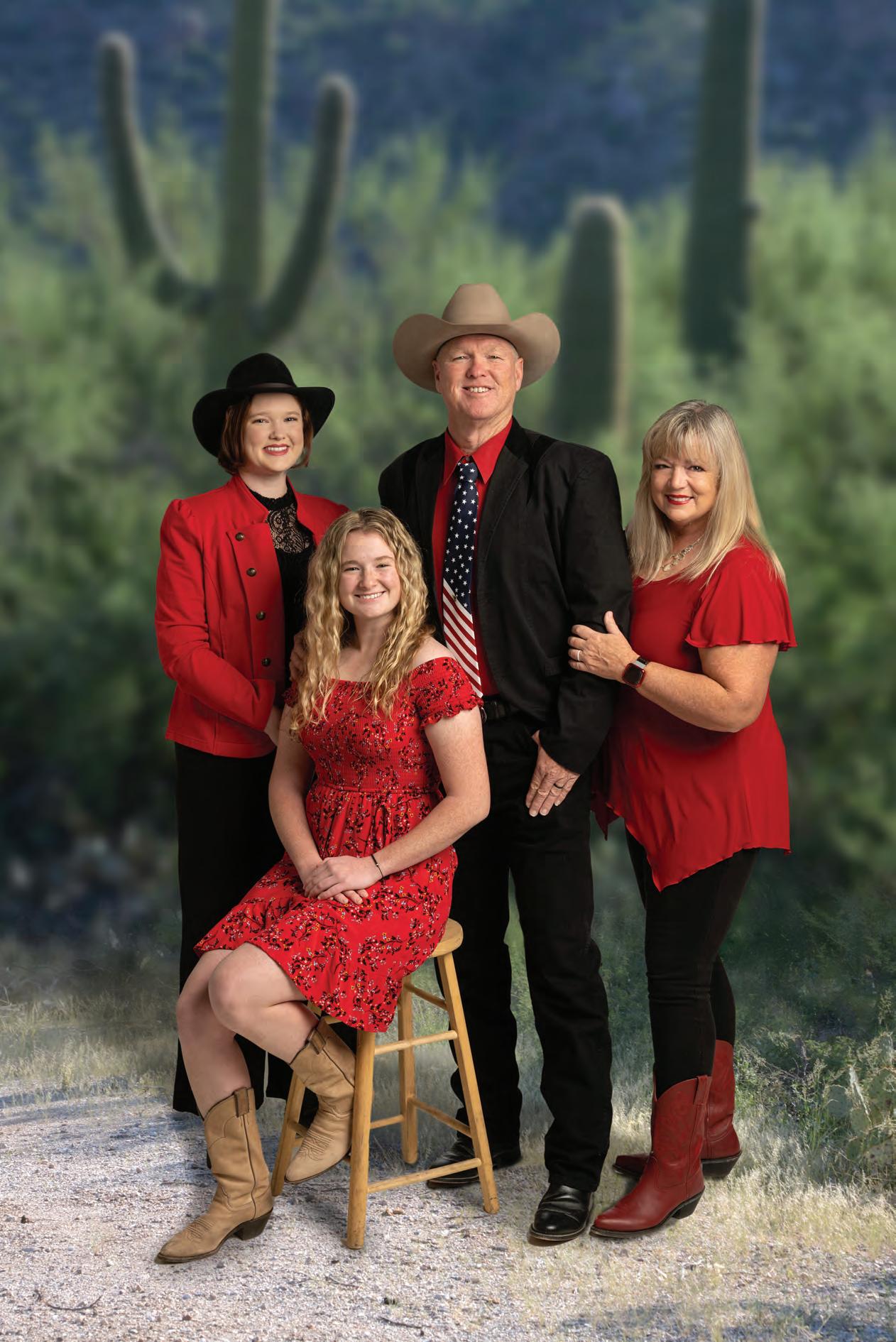
54 BizTucson < < < Spring 2023 2023 FATHER OF THE YEAR HONOREE
Sierra, Kendall, Shane & Lori
PHOTO BY CHRIS MOONEY
U.S. Military Honoree

Shane Clark
Dedicated to Family, Service
By Rodney Campbell
Lessons from more than 30 years of military service remain important in Shane Clark’s life. The retired Command Chief Master Sergeant for the Arizona National Guard relies on that hard-earned education in his professional and personal lives.
The results are clear: He has the responsibility of serving as the director of the Pima County Office of Emergency Management and is the military recipient of this year’s Father of the Year award.
“Shane supports all those who serve and always displays how to be a professional,” said Southern Arizona Leadership Council President and CEO Ted Maxwell, who served with Clark in the National Guard. “Shane balanced all the challenges and difficulties of his commitment to service and family as well as anyone I know. Throughout all his roles and the challenges of balancing all he was asked to do, Shane never put his family second.”
Clark and his wife, Lori, will celebrate their 22nd wedding anniversary in May. They have two daughters, Sierra, 21, and Kendall, 19. Both are living on their own but their dad’s influence is still there.
“My role as a father when my kids were under my household was to love them and prepare them with the tools to live in the greatest country in the world,” said Clark, who also has been a firefighter and paramedic. “I taught
them to love someone and enjoy a long life with that person but, at the same time, to be independent and know they could conquer the world on their own if needed.”
Maxwell said Clark and his wife, a retired firefighter, set fine examples for their daughters. Clark always participated in a wide variety of activities with his children.
“It seemed like every time I turned around, Shane was doing something with his kids,” Maxwell said. “Coaching everything from basketball, volleyball and golf to acting and singing with them in shows at church. When Shane starts talking about people in is life, he lights up. He is a true combination of a gentleman, cowboy and airman.
“He’s dedicated to his country and his family.”
Clark leads a life of personal responsibility, a trait he honed during his time in the service. He may be busy but he never loses sight of his priorities.
“I do best when my faith is No. 1 and my family is No. 1a,” Clark said. “From honoring the friendships and relationships to my ability to be at peak performance serving my country in military service to now my community of Pima County, balance has been the key and when that balance is not there, something suffers. I don’t want that to be my obligation to being a man of faith, a husband and father.”
Clark learned a lot from his dad, who
instilled in him and his brother a love of sports, hunting, camping and teamwork. Clark’s father was a blue-collar man who never shied away from hard work.
“I learned to have a strong work ethic from my dad,” he said. “We didn’t have as much as many and more than some, but we always had all we needed.”
Working hard is part of Clark’s job. He and his team must be ready for the next emergency in a region of more than one million residents.
“I was a servant leader in my military life and I am a servant leader in my current role in county emergency management,” he said. “We plan and train for emergencies our community has or will face and will take care of the needs of our community to the very best of our ability when the next emergency occurs.”
Clark didn’t see his Father of the Year honor coming. This time, he was caught by surprise.
“I was and still am shocked and humbled,” he said. “I am blessed there are those that think of me of being a father worth recognizing. I feel there are so many other fathers who have been there for me along the way that are more deserving of this recognition, those who I have modeled being a father, that I learned from and have been a part of my journey being a dad. I feel that I will be representing them.”
Spring 2023 > > > BizTucson 55 www.BizTucson.com
Shane Clark Command Chief Master Sergeant (ret.) Arizona National Guard
BizHONOR Biz


56 BizTucson < < < Spring 2023
Tammy Caillet-Falbaum and Vance Falbaum
2023 FATHER OF THE YEAR HONOREE
Below from left – Ryan Caillet (27), Mason Falbaum (28), Tammy, Vance, Barrett Falbaum (26) Tyler Caillet (27)
PHOTO BY CHRIS MOONEY
Vance Falbaum Managing Director & Financial Advisor RBC Wealth Management
Vance Falbaum
Fierce Dedication to Family
By Tara Kirkpatrick
When Vance Falbaum and Tammy Caillet-Falbaum married and blended their families, they brought together four young boys. Through epic pillow and blanket forts, multiple sports, musical instruments and video games, they would become a loving band of brothers under the couple’s care.

Sure, there might have been a dartthrowing incident with a fog machine and possibly a little brotherly butt-kicking from time to time.
Yet, now working in different cities, all four young men are eager to return to Tucson to see Vance celebrated by the Father’s Day Council as one of the 2023 Father of the Year honorees at its June 4 gala. “I feel very honored to be selected to be sure,” said Vance. “I certainly appreciate the acknowledgement and the purpose of the whole program.”
“I’m incredibly proud of him and 100% believe that this is very well-deserved because he’s been an absolutely wonderful dad,” said son Barrett Falbaum. “He has always put family first.”
Indeed, Barrett and his brother Mason, along with Tammy’s twins Ryan and Tyler Caillet are all on Vance’s speed dial in the mornings when he drives to work as a managing director and financial advisor at RBC Wealth Management. He just goes down the list until one answers.
“I feel very privileged that he is so present in my life,” said Barrett.
The twins praise Vance as a man they embraced from the start. “With our new family, he didn’t show any favoritism toward one person,” said Ryan. “He worked so hard all the time. He was kind of the glue of the family.”
“He’s raised me and Ryan since we were 7,” added Tyler. “Vance took on that role without even being asked. He made it to all of our lacrosse and baseball games. He made it no matter what.”
Both Tammy and Vance were very involved in the boys’ active sports lives and relied greatly on a massive, colorcoded calendar as they were growing up. They would spend long hours at Udall Park and later, Salpointe Catholic High School going to games, working the snack bars and supporting their sons. Tammy chaired the high school’s foundation gala in 2014.

“He was so actively involved in their lives,” said Tammy, who co-owns and manages T & R Investments and serves on the Tucson Medical Center Foundation Board. “He coached their soccer teams, he went to every single game. No matter where it was, Vance was always there.”
She also credits him for his patience. “He’s very even-keeled and the boys really benefitted from that.”
Having grown up on the East Coast, Vance moved to Tucson in the 1960s for his father’s job in federal law enforcement. After graduating from Vir-
ginia Tech, he completed post-graduate studies at The Wharton School of the University of Pennsylvania, New York University and Michigan State University. He also earned a master’s degree in legal studies from the University of Arizona’s James E. Rogers College of Law.
Vance returned to Tucson in 1988 for a position in wealth management. Today, he is a Forbes Best-In-State Wealth Advisor (2023) and a member of RBC’s Chairman’s Council, which represents the firm’s top 150 financial advisors out of 2300 nationwide. He’s also very active in the community, serving on the boards of the Tucson Airport Authority, Goodwill Industries of Southern Arizona and Boys and Girls Clubs of Tucson. Vance is also a member of DM-50 and Salpointe’s investment committee.
Now that their boys are grown and flown, Vance and Tammy still relish time with them on family trips and love how close they remain. Mason and Barrett visit each other often and Ryan and Tyler live on the same street. The boys stay connected online as well, gaming together frequently.
“As they have pursued their own paths and have accomplished meaningful things to them, I am proud of the men they have become,” Vance said. “They even call me and ask for advice from time to time. It is nice to still be involved in their lives, even if from a distance.”
Spring 2023 > > > BizTucson 57 www.BizTucson.com
BizHONOR Biz
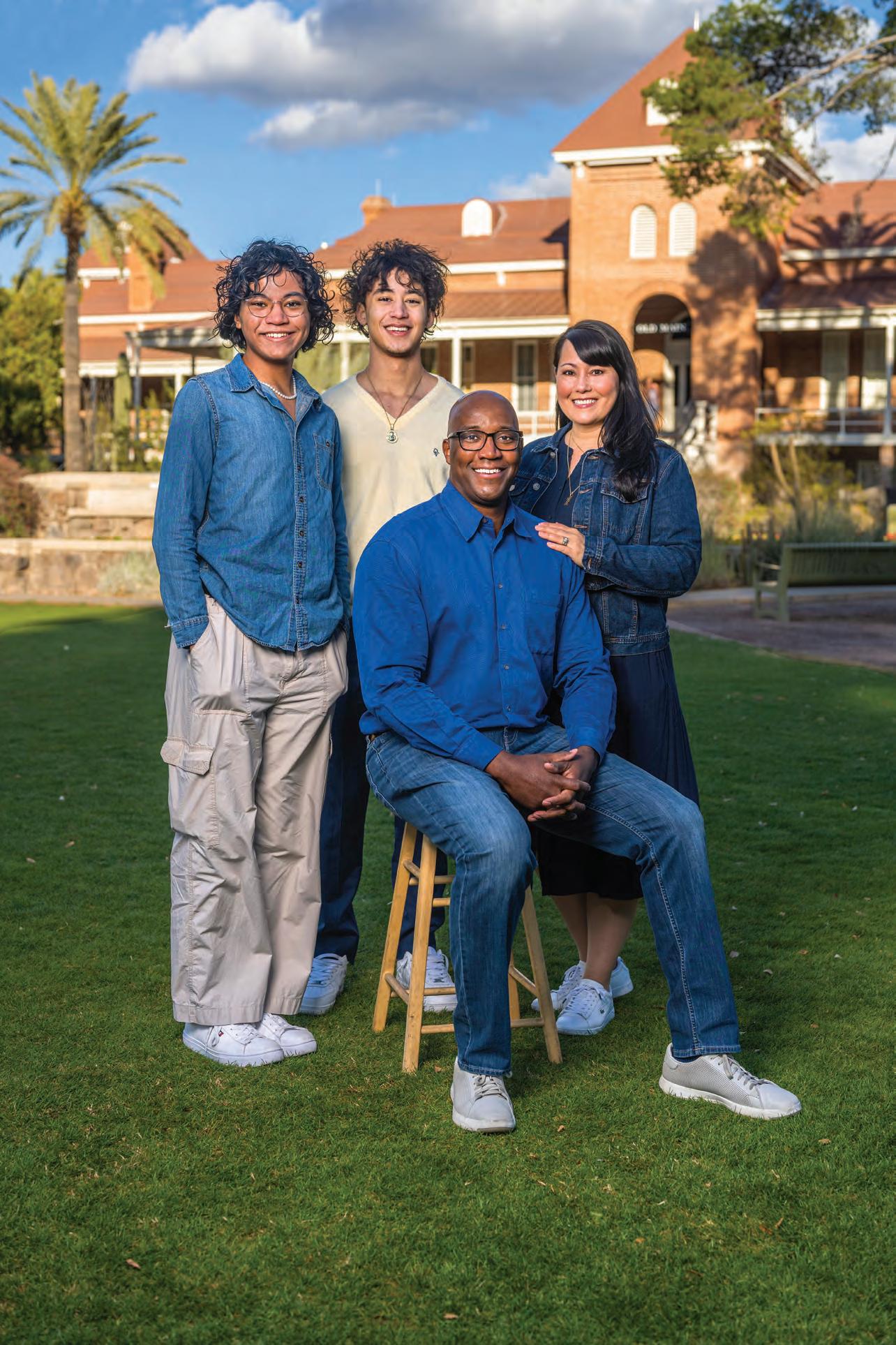
58 BizTucson < < < Spring 2023
2023 FATHER OF THE YEAR HONOREE
From left – Wesley, Quincy, Reggie and Candace
PHOTO BY CHRIS MOONEY
Reggie Geary Senior Director of Development UArizona Wildcat Club
Reggie Geary
An all-star on the court and at home
By Steve Rivera
Nothing Reggie Geary has done – help lead the Arizona Wildcats to a Final Four, play in the NBA, coach at various levels or raise funds for UArizona – can match what he has been doing for nearly 20 years: Being a dad.
He loves the work – if that’s what you want to call it. He’s one of five fathers who will be honored this summer as a Father’s Day Council Tucson Father of the Year.
“It’s the most rewarding and the most challenging job in the world,” said Geary, a standout Wildcat basketball player in the mid-1990s. He’s now senior director of development for the Wildcat Club and visible in the community and Arizona athletic events.
“From the time our first born came, life changed,” he said. “And with that I wanted to be a great father.

“I’ve tried to do that – although I’ve probably failed more than I would like,” he said with a laugh. “But my intentions are always around love and support in wanting to be a great father.”
“Reggie is a best dad because of who Reggie is,” said Candace, who will celebrate her 25th wedding anniversary with Reggie this summer. Their sons, Quincy and Wesley, are 19 and 15, respectively. “He has sacrificed everything for his kids. He wants only the best for the kids − always.”
If Reggie and Candace aren’t at their son’s activities, it’s a shock. Quincy is the one-time standout high school basketball player, now a UArizona freshman who hoping to get into law school. You might see Quincy working at the Arizona Sands Club at Arizona Stadi-

um now and then. He’s also a practice player for the UArizona women’s basketball team. Wesley is the impressive young singer/actor.
“We’re like every other family with active children,” Reggie said. “One is into athletics and the other into arts. When they were younger it was getting them to practice, violin lessons or swimming lessons or rehearsals. Our life was centered on where they needed to be. And mine was trying to do that and go to sporting events, while being a good father.”
Good kids equal a good dad and, of course, a good mom.
Reggie saw that in his basketball coach at Arizona, Hall of Famer Lute Olson and his wife, Bobbi. Lute was a Father’s Day Council Father of the Year in 1995.
“Bobbi and Coach O were such a great couple. They were the perfect example of how Candace and I wanted to raise our family,” Reggie said. “I always loved that Coach Olson was such a family man and would openly display his affection for his family.”
Reggie does the same when he talks about his sons.
“I’m just so proud of the young men they’ve become,” Reggie said. “Both of our sons are very independent and talented. They’re really developing a vision for their futures. And they’re working hard towards those visions. As parents, that’s all you can ask for when they leave the home or when they need your house, you just hope they make good decisions. You support them and guide them as much as you can.”
Call it a good assist in raising kids to be proud of. But Reggie knows all about that given he had 560 assists as a UA player from 1993-1996. He helped lead the Wildcats to a Final Four in 1994 and a Sweet 16 in 1996. He ventured off to the NBA – at Cleveland and San Antonio − for a couple of years before finding coaching stints at various levels, including Japan and back at Arizona.
Now, Tucson is home and has been for more than two decades. Reggie is frequently asked to do radio color commentary alongside Brian Jeffries on Wildcats Sports 1290 and still work his business-like magic for the Wildcat Club.
“What I love so much about Reggie is: I love his personality, he is fun, he makes me laugh, his confidence, he can adapt to any room and be comfortable,” said Candace, who has known Reggie for nearly 34 years. “He’s good with people, he loves learning and being in new cultures and environments. He’s a natural leader, he has a good spirit, he’s an amazing and handsome human being.”
More importantly, she said, “He’s a great dad. You knew him as a player and how hard he worked. Well, that’s who he is. He wants to do everything for his kids. He wants them to succeed. He wants them to enjoy the activities they’re doing. He puts everything into taking care of his family.”
“It’s a very humbling experience,” Reggie said of the honor. “Obviously it’s nice to be recognized by your friends and by people that see something in you. I feel good about it.”
Biz
Spring 2023 > > > BizTucson 59 www.BizTucson.com
BizHONOR
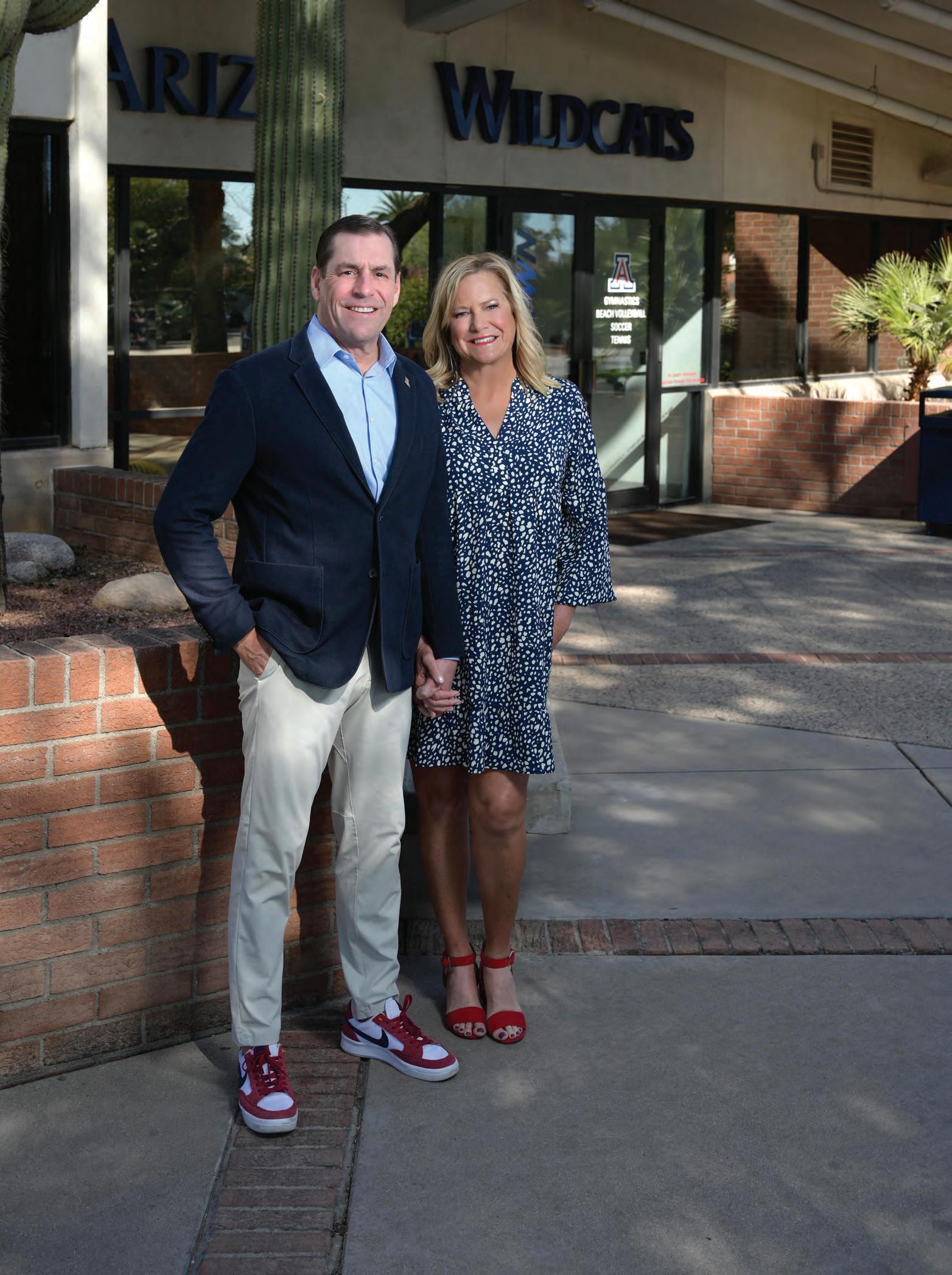


60 BizTucson < < < Spring 2023
Dave and Liz Heeke
2023 FATHER OF THE YEAR HONOREE
Below from left – Max (middle), Zach (youngest), Dave, Liz, Ryan (oldest) and Merisa (Ryan’s wife and mother of Van David)
PHOTO: BY CHRIS MOONEY
Dave with grandson Van
Dave Heeke VP & Director of Athletics University of Arizona
Dave Heeke
‘All in’ as athletics family
By Dave Perry
A career in college athletics can consume all of a family’s time, energy, focus…life.
Dave and Liz Heeke haven’t let it do that to their family. Rather, they brought their sons Ryan, Max and Zach along for the value-setting, experiential journey of their young lives.

They’ve helped place pompoms on empty football stadium seats before big games. They’ve seen every sport, played many of them, watched the struggles and triumphs of student-athletes. And they’ve spent many Christmases at college football bowl games.
“If you’re not at a bowl game at Christmas, no one’s happy,” Liz said. “The kids grew up with Christmas in a hotel room.”
Every Christmas, no matter what city they were in, Dave made sure there was a live Christmas tree in the hotel room. The boys wrote notes to Santa, sharing their itinerary for late gift deliveries back home. Dave also ensured every coach’s family had a special Christmas, too.
The career “becomes all-encompassing,” said Dave, VP and director of athletics at the University of Arizona since 2017. He is a 2023 Father’s Day Council Father of the Year honoree. “Our environment dictates our calendar, to a degree. It can break you down. But you can embrace it and allow your entire family to be part of it.”
“My dad cared about making our childhood special, and it was,” said
Zach, 25, a personal financial adviser.
Yes, Dave was gone for long hours. “Yet the experiences we got inspired us to be what we are today,” said Ryan, 29, a banker and father. “It’s an experience not every kid gets.”
“I loved every bit of it,” said Zach, who like Ryan played baseball at Central Michigan University where Dave was athletic director for 11 years. “My parents shaped me, but also learning through those experiences shaped me.”
“They always put the three of us first,” said son, Max, 26, who is following in his dad’s footsteps as director of budget and finance for CMU athletics. “I got to see my dad do incredible things, whether it was being a leader, being an amazing hard worker, and setting a strong example for all three of us.”
The young men all agree that a strong example encompasses honesty, respect, humility, hard work, faith and preparation. Be an active listener and strong communicator. Believe in people. Do your best. Be determined. Zach said he learned to “put your head down and keep working hard and see what happens.”
“He’s seen as this very intelligent, hard-working guy, very, very professional,” Zach said. “He’s also one of the most caring guys, and one of the most loving. Yes, he is very serious and straightforward, but he has the biggest heart.”
“The amount he does for us as a fam-
ily, people don’t know, but we know,” Max said.
Dave wanted to be a coach, but knew it was “a really, really demanding profession.” Tenuous, too. So, he turned to athletics administration. “We thought that would be better for everything, and better for us,” he said.
After a long run at the University of Oregon, Dave became athletic director at Central Michigan in Mount Pleasant. He and Liz decided they would not move from there in the midst of their sons’ high school years.

“The kids made sacrifices, so that was our sacrifice for the kids,” Liz said.
“My mom and dad put us three kids above everything else,” Zach said. “He let us build a great life in a small town.”
“It was the right thing to do for our boys and our family,” Dave said. “Invest in family, and good things will happen, and they did.”
“I couldn’t be more proud of them,” he said of his sons. “They’re great young men. I’m very proud of how they handle themselves.”
If balance is the challenge, partnership is the answer, Dave said.
“I couldn’t have done what I’ve done without Liz, and we really rely on each other,” he said. “She has sacrificed for all four of us, stepped out of her career as a highly successful hotel executive, and made the choice to be an incredible mother and leader of our family.”
It’s been great fun for Liz, too. “We’re all in,” she said.
Spring 2023 > > > BizTucson 61
BizHONOR
Biz
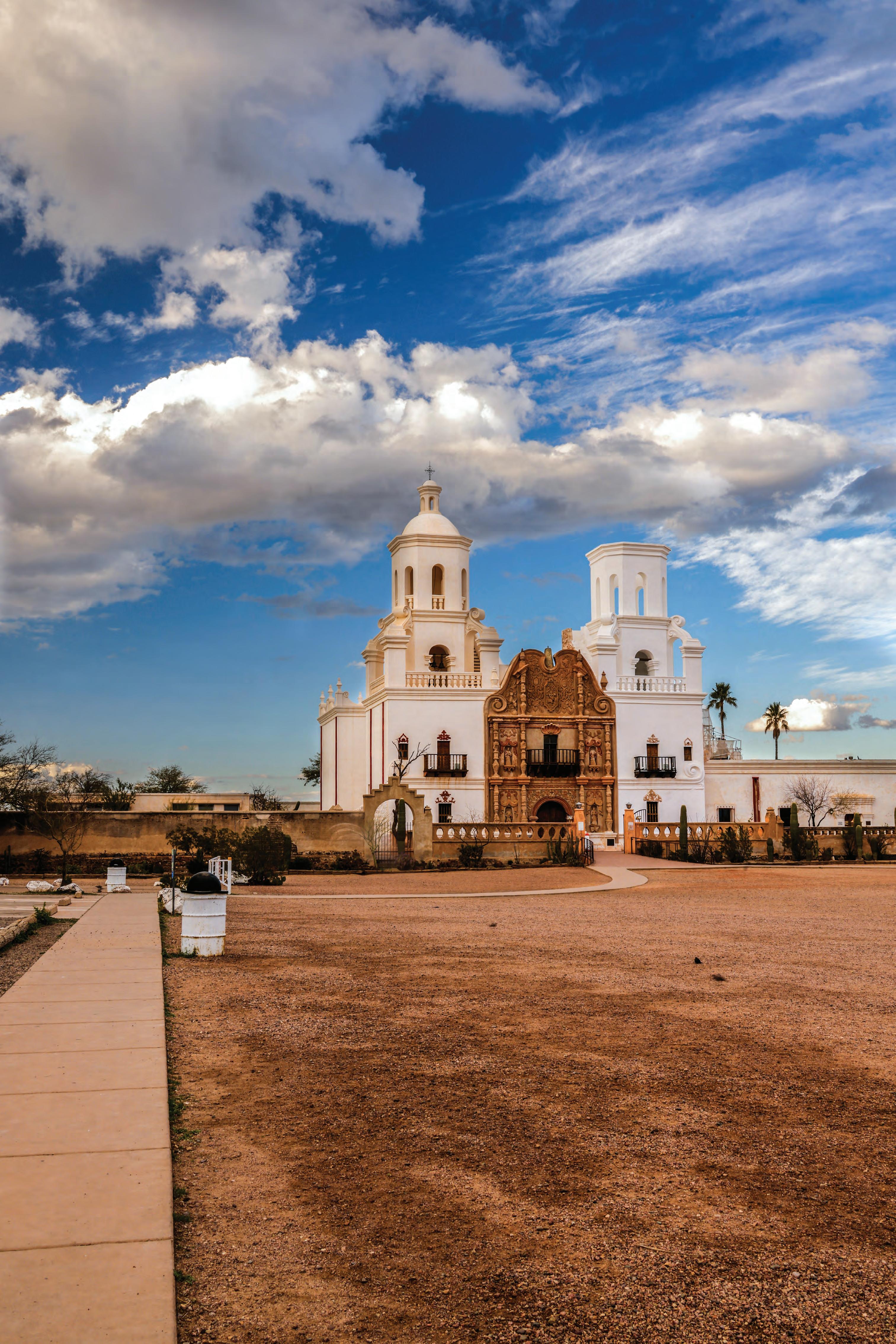
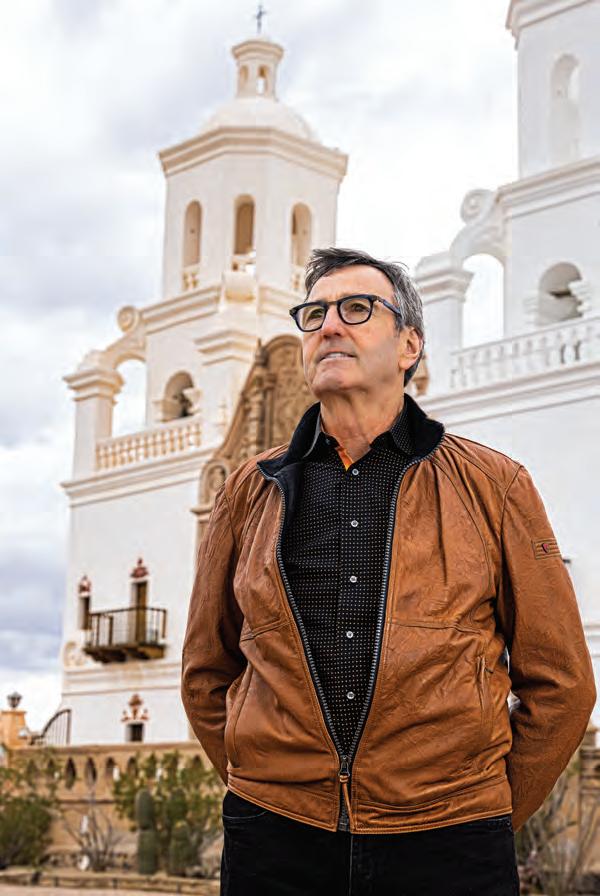


www.BizTucson.com 62 BizTucson < < < Spring 2023
Miles Green
Executive Director
Patronato San Xavier
A Mission for the Mission Preservation of
Desert Icon Needs Revenue Streams
By Christy Krueger
One of the greatest attributes of the Mission San Xavier del Bac is how much love it attracts. If that wasn’t the case, it’s not likely the 226-year-old National Historic Landmark would be standing in the same glory it is today.

The support system behind the mission’s fundraising and preservation efforts is the nonprofit organization, Patronato San Xavier, established in 1978 by a group of concerned Southern Arizona citizens. They had a right to be worried. The mission had been deteriorating for years and the only way to prevent further damage from age and the elements was intervention.
Before Patronato, conservation projects had been completed, but in some cases the “repair” work made the weakening building worse. In the 1950s, Portland cement-based plaster was used to replace the traditional lime based plasters. Cement retains moisture, and the process caused further decay.
The last section of the 18th-century church to be addressed is the iconic façade. “We want to remove (the cement) and replace with lime plaster made the traditional way,” said Miles Green, executive director of Patronato San Xavier. “It will be an important project, to start in about a year. We’re now in the research phase.” The preservation of the facade will include repairing the façade’s brick, stabilizing and consolidating the original plaster and refinishing with traditional lime plaster.
Other San Xavier projects in the past 20 years have included preservation of the West tower, (2003-2008), and the East tower, (2020-2022). Additionally, conservators are two-thirds finished with a second round of conservation of the interior artwork. This work consists of stabilizing the interior plasters and reattaching paint fragments. Completed for the first time in the 1990s, it needs to be revisited at least every seven years.
Even the smallest repairs on a building the size and age of San Xavier are costly, and Patronato’s leaders are continuously searching for revenue streams to keep the iconic beauty alive for centuries to come.
The East tower work was supposed to have started immediately after the West tower was completed. “We were trying to raise
continued on page 64 >>>
Spring 2023 > > > BizTucson 63 BizPRESERVATION
PHOTOS BY BRENT G. MATHIS
money and hit a series of roadblocks,” Green noted. “We were depending on money from the State Heritage Fund. Due to the recession, that source was taken away.”
Green is grateful for regular support from local organizations such as the Silver & Turquoise Board of Hostesses, which has given roughly $825,000 to Patronato over the past 30 years. The 70-year-old organization hosts an annual ball at the Arizona Inn.
“Every year, proceeds from the Silver & Turquoise Ball support the preservation of Tucson’s historical traditions and diverse cultural heritage,” said Lori Carroll, chair of the 71st annual Silver & Turquoise Ball, to be held May 6. “This year, as in many years past, our beneficiary will be Patronato, supporting their effort to preserve Mission San Xavier del Bac. S & T Board of Hostesses is one of the primary contributors to the ongoing conservation and preservation of this gorgeous national landmark and local treasure.
“I am inspired by the community of exceptional women who have graciously dedicated their time, talents and efforts to keeping this tradition alive...” Carroll added.
Green also credits additional donors—the list of which is growing. “We are getting funding from almost every state,” he said. “Since 2011, our docent project has offered free tours. As part of these tours, the docents talk about the importance of the work to preserve San Xavier. People are inspired by our work and become supporters of that work.”
He named the National Fund for Sacred Places, State Heritage Fund and National Trust for Historic Preservation as important support sources over the years.
“One thing that’s a concern of mine, considering how iconic the mission is, and, how it functions as an economic driver for Southern Arizona– it’s the #2 tourist attraction here – is that almost all the local donations are from individuals, not businesses. We’re trying to develop business partners to get across the finish line of preservation projects in the next seven to eight years and need to raise a further $7 million.”
Such partnerships, depending on the level of financial commitment will allow businesses to be listed on Patronato’s website and in its newsletter; tour guest passes; and sponsorships opportunities and invitations for events such as the beloved annual “Patronato’s Christmas at San Xavier. This holiday concert at the candle-lit mission, is considered by many to be the official start of the holiday season here.
The preservation work has uncovered some fascinating historic details. There are six original wood doors in the mission, and it was thought they were mesquite. Closer examination found that not to be the case. “Dendrochronology studies show they are pine and we’re fairly confident Mount Lemmon is where the pine was sourced,” Green said.
And of course, there is the long-standing legend of the Cat and the Mouse–cement creatures on elegant swirls on each side of the façade. “There is a legend,” Green said, “that if the cat catches the mouse, it’ll be the end of the world.” The two figures will be left alone during the work on the façade.
continued from page 63 Biz
No sense in tempting fate.

64 BizTucson < < < Spring 2023 www.BizTucson.com
BizPRESERVATION


SPECIAL REPORT 2023 THE REGION’S BUSINESS MAGAZINE









70 BizTucson < < < Spring 2023 www.BizTucson.com
TucsonAuthorityAirport at75
$8.3
Billion Annual Economic Impact
Tucson Airport Authority (TAA) has come a long way in the 75 years since it borrowed $25,000 to begin operation of Tucson International Airport.

Today, it has an $8.3 billion annual economic impact.
TAA President and CEO Danette Bewley calls it an “evolution,” and it’s continuing at an ever-increasing pace.
As TAA marks its 75th anniversary, it’s poised to spend more than $1 billion over the next decade or so to continue to upgrade, expand and modernize the Tucson International Air-
port – or TUS (it’s federal aviation designator) − in response to the growing community, to federal safety requirements, to businesses who want to move to the region, and to travelers who want and need more from their airports.
“I think what you see at airports is evolution,” said Bewley, only the fifth person to lead TAA since it was formed in 1948. She arrived as part of the management team in 2012 to continue a long career in aviation and was appointed to head TAA in 2019.
By Jay Gonzales continued on page 73 >>>
PHOTO COURTESY TUCSON AIRPORT AUTHORITY
BizMILESTONE Spring 2023 > > > BizTucson 71


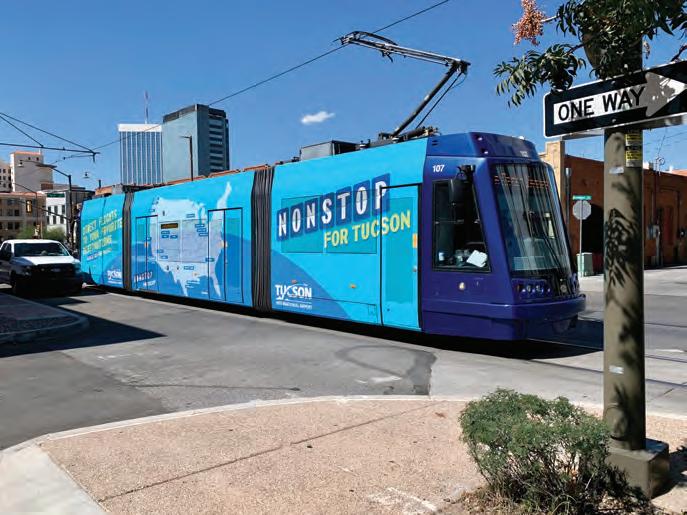


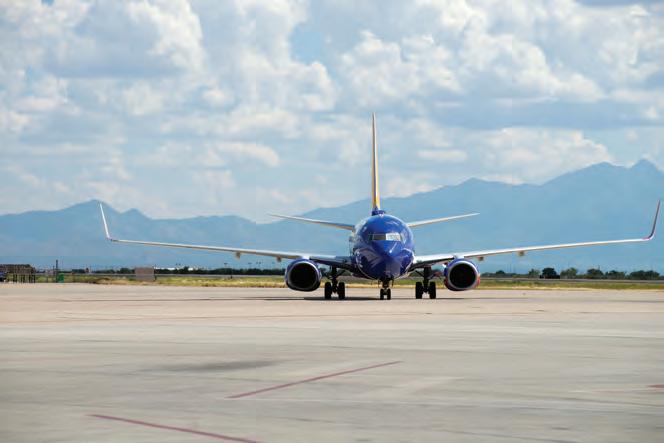
72 BizTucson < < < Spring 2023 www.BizTucson.com
From left – Christopher Schmaltz, VP & General Counsel; Twyla Salaiz, VP & Chief People Officer; Austin Wright, Chief Communications Officer; Danette Bewley, President & CEO; John Voorhees, VP & Chief Revenue Officer; Bruce Goetz, Executive VP & Chief Operations Officer; Anthony Casella, Chief Technology Officer Not pictured: Kim Allison, VP & Chief Financial Officer and Ken Nichols, VP of Planning and Engineering.
continued from page 71
“We’re in the same situation that many other airports are in where you are finding outdated infrastructure and a growing community and you have got to make some changes to accommodate the airlines, the community and the desires of the traveling public. You have got to adjust.”

That’s exactly what TAA is doing.
In 2018, the Terminal Optimization Program completed a revamp of the terminal within its footprint, to reconfigure the security checkpoints and other space for easier access for travelers, to provide modern amenities and to relieve some of the cramped quarters around the terminal.




The airport is in the third year of a $400+ million Airport Safety Enhancement project to meet new Federal Aviation Administration (FAA) safety standards on the airfield. In the next several years, a new, relocated parallel runway will be completed along with the accompanying improvements to improve safety and airfield access for aircraft users. The airport will ultimately have two parallel commercial runways, and a crosswind runway, that will accommodate all users, including the airlines, military and general aviation.
continued on page 74 >>>
“Our goal is to develop the land for the airport authority that happens to have a byproduct that develops business.”
– Danette Bewley President & CEO Tucson Airport Authority
Spring 2023 > > > BizTucson 73 www.BizTucson.com BizMILESTONE
PHOTO: BRENT G. MATHIS
PHOTO COURTESY TUCSON AIRPORT AUTHORITY
BizMILESTONE

AIRPORT SAFETY ENHANCEMENT PROGRAM
continued from page 74
In all, about $1.5 billion is expected to be spent on these two airport projects – assuming grant funding is available through the federal government.
“You have to figure out if you can get it federally funded to the maximum level and if not, how do you want to pay for it,” Bewley said. “As good stewards, those are questions we have to ask ourselves.”
There are billions of dollars at stake.
In 2021, the Arizona Department of
Transportation produced the Arizona Aviation Impact Study that put TUS’ economic impact at $8.3 billion. The airport supports more than 45,000 jobs that result in about $2.5 billion in earnings. Ryan Airfield (RYN) has added $35 million in economic impact with another 216 jobs supported.
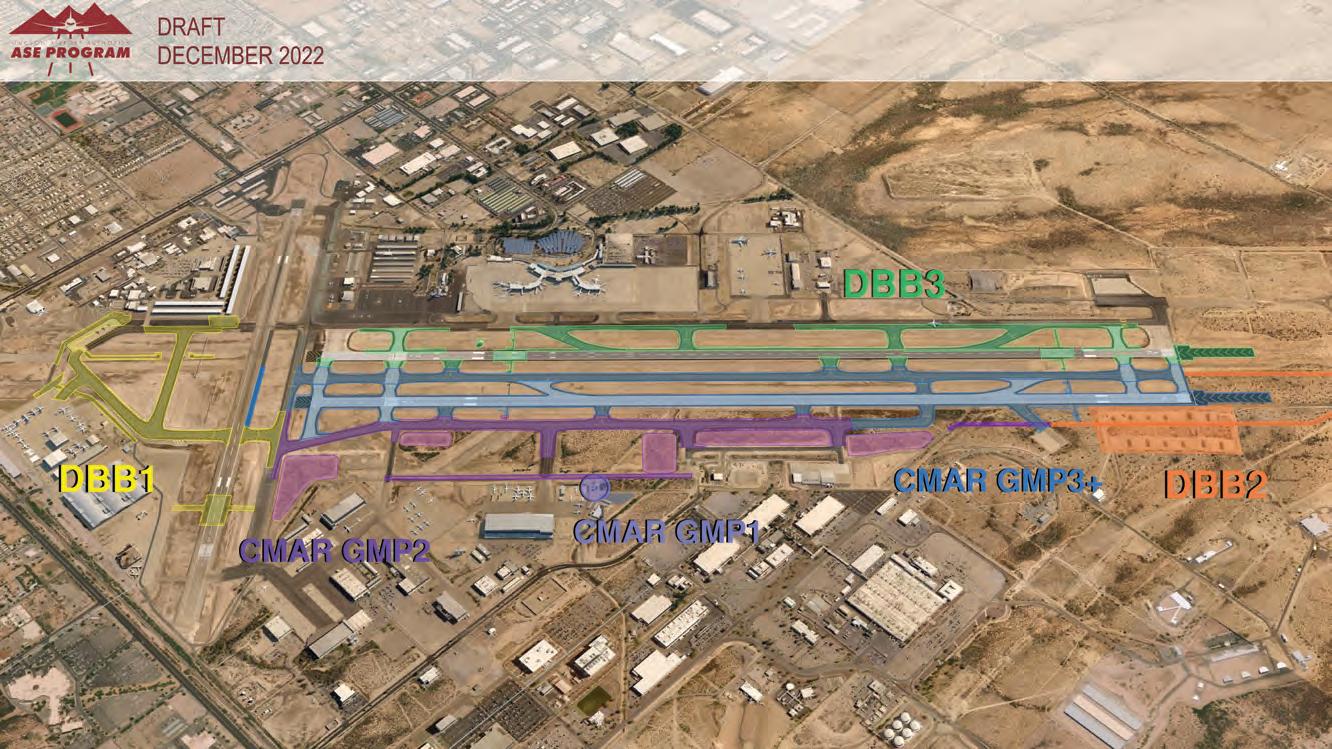

About 3.4 million passengers passed through TUS last year, the TAA said in its 2022 Year in Review report. TAA is the landlord for 80 tenants at TUS and another 25 at RYN.
One of the airport’s focus areas is diversifying revenue streams. The TAA has a portfolio of aeronautical (airlines, etc.) and non-aeronautical (non-aviation buildings, land, etc.) endeavors. Revenue from aeronautical activities is

about 65%, with the remaining 35% coming from non-aeronautical activities.
Typically, airports purchase land to protect the airport from encroachment and/or minimize noise impacts to the surrounding areas, when possible. The TAA has amassed a lot of land over the years for these purposes. With more than 5,000 of developable land around the airport, another 1,000 on the airport property for aeronautical tenants, and 2,000 more around RYN, there is room to develop some of the land holdings to expand the revenue portfolio.
COURTESY TUCSON AIRPORT AUTHORITY
PHOTOS
continued on page 76 >>> 74 BizTucson < < < Spring 2023 www.BizTucson.com
RYAN AIRFIELD
And now, there are conceptual drawings for a long-term expansion plan for the terminal which will solve existing challenges and meet future needs with an increase in the number of the gates to accommodate expected growth.
However, airports are unique and there are processes, limitations and restrictions that must be followed as land



continued from page 74
is readied for market. Before any land can be developed, the FAA must conduct a comprehensive analysis and review, which includes an evaluation of the planned or intended use (aeronautical or non-aeronautical), ensure proper environmental studies are completed, and identify the original source of funds used to purchase the land (FAA grants, etc.). In some cases, the FAA may require an airport pay it back at fair market value. Airports must be strategic in how they approach land development; it is not uncommon for this process to take several years.
The TAA does not always go it alone. Sun Corridor Inc., the region’s economic development arm, provides expertise and assistance as well as business leads. Working together, the TAA and Sun Corridor discuss issues and challenges, and the best approach to use in different scenarios to achieve the best outcome. There is a lot of work to do, which is exciting.
“What we’ve seen over the last few years is a lot of companies coming into
the airport employment area,” said Joe Snell, president and CEO of Sun Corridor. “We’re working with some on air port land, but it’s really the airport that’s influencing all of this.”
It’s an opportunity for the region to continue developing the area as a business corridor with nearby transportation access. If it’s on airport land it has to have a connection to TUS. But the airport’s influence in the area goes beyond the land it owns.

“We’re seeing a lot of movement in this whole airport employment area. It is the key economic development area right now for Southern Arizona.”
Bewley is careful to point out that any development on land the airport owns must have a direct benefit to TUS because it is regulated by the FAA. At the same time, any business the land generates is good for Southern Arizona.
“Our goal is to develop the land for the airport authority that happens to have a byproduct that develops business,” Bewley said. “We keep that straight because the FAA looks at us very carefully as to how we spend air-
port money. It always has to benefit the air port system.”
History of TUS
It all started in 1948 with a $25,000 loan when the local chamber of commerce put together a group of 15 business leaders to run the airport which was operating on land purchased by the City of Tucson.
A couple of small airfields and later, Davis-Monthan Air Force Base had served as the region’s airport from the early 1900s until after World War II when city government purchased the land where TAA now sits in 1941. The city didn’t have the resources to run the airport, so the chamber stepped in.
It formed the TAA as a nonprofit corporation in 1948 and hired Robert W.F. Schmidt as the first general manager.
Around that time, Ryan Airfield had been built west of town to train World War II pilots, and after the war it became a commercial airfield. The TAA took over operation of that in 1951 and still operates it.
76 BizTucson < < < Spring 2023 www.BizTucson.com
Over time, all the major airlines, some that are still around and some that are not, made their way to TUS – TWA, Pan Am, American, United, Delta, Continental. Today, through consolidation of many of the larger airlines, the four largest − American, United, Delta and Southwest − still serve TUS. Alaska, Flair and Sun Country bring the number of airlines serving the Tucson community to seven.
Planning for Growth and Commerce
TUS is now in the middle of, arguably, its biggest construction effort in its history to meet safety standards, hence the Airport Safety Enhancement Program.
“We’re taking a long-term view –20, 30 years into the future,” said Ken Nichols, TAA VP of planning and engineering, pointing to current planning to expand the terminal from 22 gates to as many as 35 gates, and to improve aging infrastructure and modernize technology.
“We have been planning with con-
sultants for about a year and a half now,” Nichols said. “They have crawled all over the terminal, and looked at our baggage systems, check-in counters and gate holdroom circulation spaces, concessions spaces, our Federal Inspection Services area, curb frontage and parking, to name a few areas.
“They have evaluated alternatives for how the airport could effectively grow in the future and also enhance passenger experience and flow throughout the air port.”
Austin Wright, chief communications officer at TAA, said the airport recognizes its role.
“I think that we try to share the good work that we’re doing with the whole community and that we are more than just a port for an airplane to come into town, load up passengers and leave,” Wright said. “We have a lot of businesses that thrive on the land that we own. We are an economic engine for Southern Arizona and there are many people that rely on this airport for their livelihood.”

Bewley said the airport is still recov-
ering from COVID-19 to continue being a positive influence in the region.
“Working with the airlines, we have restored about 90% of the flights as compared to the pre-COVID levels of 2019. We still have a gap to fill,” Bewley said. “Of course, we are not going to be satisfied until we get back to where we were in 2019 and beyond.”
“It’s really important that we diversify our revenue stream,” she said. “The real reason airports do what we are doing is to have a different revenue stream so if an airline decides to reduce their flights or cut service altogether, we are not left going, ‘Oh no. What are we going to do?’
“We have another revenue stream coming in and that is very important. Not every airport has the same land holdings that we do. But I can promise you, if you talk to any CEO of an air port, they are going to tell you how important diversification of revenue streams is because COVID was a perfect example to test an airport’s resolve.”
Spring 2023 > > > BizTucson 77 www.BizTucson.com
Biz
BizMILESTONE



78 BizTucson < < < Spring 2023 www.BizTucson.com BizMILESTONE

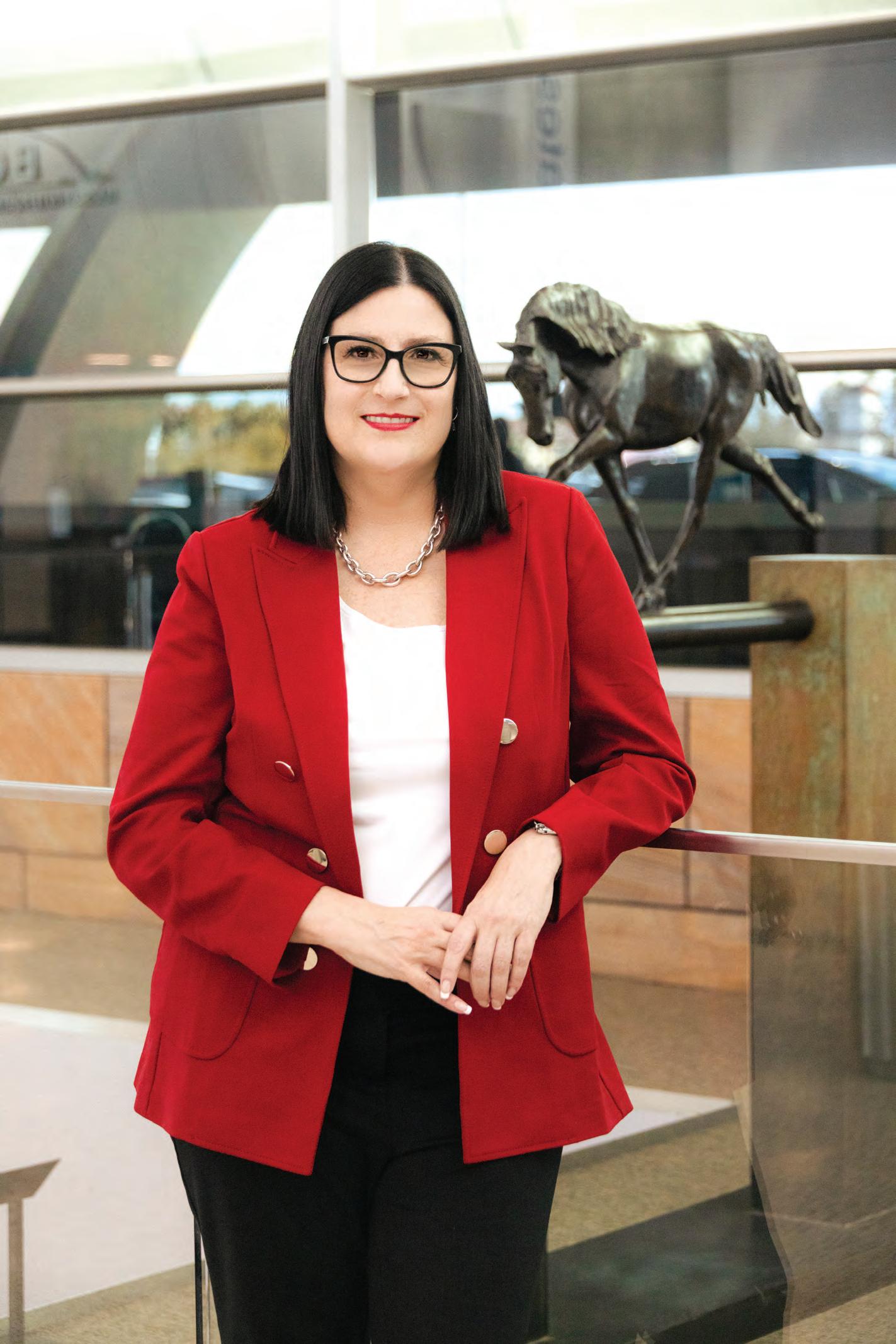
80 BizTucson < < < Spring 2023 www.BizTucson.com
PHOTO: BRENT G. MATHIS
From Top Gun to Tucson Airport Authority
Q&A with Danette Bewley
By Jay Gonzales
There was never a doubt in Danette Bewley’s mind that she would have a career in aviation.
The only question was whether it would be in the air or on the ground.
Bewley grew up in San Diego and, spent a lot of time at the Naval Air Station Miramar – the same Miramar where the U.S. Navy Fighter Weapons School, also known at Top Gun, was based. She was the daughter of a Top Gun pilot. Her uncle, U.S. Navy Capt. Dan Pedersen, now retired, is credited with creating the training program that’s reached legend status through the motion pictures “Top Gun” and “Top Gun: Maverick” starring Tom Cruise.
“I never, ever contemplated any career outside of aviation. It didn’t even exist in my mind,” said Bewley. “As I’ve grown older, I’ve thought maybe I should have been a doctor or lawyer. Those are professions that never occurred to me, not even once.”
As the daughter of an elite fighter and combat tested pilot, Bewley said her first interest was also to be a pilot.
“I really did want to follow in my father’s footsteps,” she said. “Things were a little bit different for women in aviation at that time. So, I went to school, and I got a bachelor’s degree in business administration with an emphasis in aviation, closely followed by a Master in Manage-
ment, and years later a Master of Public Administration.”
Bewley is in her fourth year as president and CEO of Tucson Airport Authority, which operates Tucson International Airport. She joined TAA in 2012 and was the VP of operations and COO for the five years before she was named president and CEO at the end of 2019. She has been in the aviation business for 34 years having held management positions in her hometown at the Port of San Diego/San Diego County Regional Airport Authority, with the Reno-Tahoe Airport Authority, and with the Jacksonville Aviation Authority.
continued on page 82 >>>

Spring 2023 > > > BizTucson 81
BizMILESTONE
continued from page 81
Q: Once you knew that being a fighter pilot was not in the cards for you, where did you direct your career in aviation?
A:My interest in aviation was really focused on becoming a pilot, but what I didn’t understand is how much there is in aviation. It’s not just being a pilot. You can do other things and still be in aviation. You just have to find what fits you best. Because of my bachelor’s degree program, I got picked by the FAA to go learn to be an air traffic controller. I did not like that. I went through the first phase of training, and it really wasn’t for me, so I decided to focus on airport management.
Q: What attracted you to Tucson?
A:Being from San Diego, I wanted to be closer to what I considered home. I really liked the climate in the area. That was one thing I looked at, but really it was the airport. The airport really needed some help to get from where it was to where we are now. You really have to invest in the projects, the programs, the initiatives, the people to build the airport to where it is. I wanted to be a part of that. I just thought that Tucson was a community that was really growing, and the airport needed to grow with it in different ways, not just in its size, but how it operates. I really wanted to help be a catalyst for that.
Tucson is a lot more like the town I grew up in in San Diego. I grew up in a
to your airline? Is our signage in the airport helpful to you? Are our volunteers helpful? Are the TSA friendly when you go through the checkpoint? Just getting through checkpoints has got to be one of life’s major stressors. Then, you get through and you recompose yourself and head up to your gate. We want people to be able to get a glass of water or a cup of coffee or a sandwich and not feel the stress. I can sit down and relax by my gate. Maybe I have time to plug in my laptop and do some work. Really, what I want is a stress-free experience. But at the core of everything, it’s always safety, security, and customer service every day, all the time. If I can get all three of those and just feel like, “Okay, great. I’m here. I can get on my plane, and I go.” That’s what I want. I want it to be seamless.
Q: At what point did you start to think you wanted to run an airport or believe you had that in your future?
A:I always knew I wanted to. I’m not sure I always believed I would. There are only so many airports in the United States. I honestly never thought I would leave San Diego. When an opportunity came up, I was talking to my CEO and I remember this comment because it’s been very meaningful for me and my career. She said, “Sometimes you need to leave in order to succeed.” That really made a lot of sense to me. I wanted to continue to grow and learn so I knew I had to leave (San Diego) and gather the experience somewhere else, so that is what I did. I kept building my career and making strategic moves. I’ve really been fortunate in my career to have had great mentors.
suburb called La Mesa, kind of a small town in a big city. That’s what I like about Tucson. Even though it is a big city, it still has a small-town feel. People are kind. People are helpful to one another. People support one another. There’s a lot of collaboration and that is what I enjoy. Although I’m born and raised in San Diego, I actually consider Tucson my home.
Q: Put yourself in the mindset of an occasional traveler through Tucson International Airport, what do you want the airport to have and what do you want it to be in the next five or 10 years?

A:I want the journey to be pleasant, and I want to remove as much stress from the experience as possible. We think a lot about that. How do you park your car or are you dropped off by a relative or an Uber? How do you get
Q: You have accomplished a lot. What is next for you?
A:What I have learned about myself is that I am never satisfied with the status quo. I often wonder if this is fighter pilot genetics running through my blood stream. I want to challenge myself and my team to be the best we can be as people and as airport management professionals. I want the choices I make, and ask my board to support, to be forward-thinking yet systematic with great, tangible benefit for the future of this fantastic airport system and community - programs, projects and initiatives and the philosophy of safety, security, and customer service at the core. I want the things we are doing at the TAA for TUS and RYN to be the airport model for other airport leaders to follow. Last, I want our community to know deep down that we are ‘Nonstop for Tucson.’
82 BizTucson < < < Spring 2023 www.BizTucson.com Biz BizMILESTONE
“...at the core of everything, it’s always safety, security and customer service every day all the time. That’s what I want.”
– Danette Bewley, President & CEO, Tucson Airport Authority

In Plane
Tucson Airport Authority Board Champions Diverse Perspectives
By Jay Gonzales
Keri Silvyn thinks there’s a passion needed to be a Tucson Airport Authority board member.
It could be a passion for aviation, economic development, business or community. Overseeing Tucson International Airport and Ryan Airfield
entails all of those, which is why Silvyn said she’s a member of the TAA board and the chair for 2023-24.
“I have a deep love of Tucson and a deep desire to see it succeed and retain its identity,” said Silvyn, a local attorney whose practice centers on zoning and
land use.
Tucson International Airport – TUS – needs a diversity of community support from a business and economic development standpoint, said Danette Bewley, TAA president and CEO. With 60 members of TAA–11 of whom serve

84 BizTucson < < < Spring 2023 www.BizTucson.com BizMILESTONE
View
on the board–TAA works to reflect the community both in its board and its membership to ensure ideas come from different points of view and experience.
The TAA was formed in 1948, but it wasn’t until 1981 that the board had a female chair, former Pima County

Supervisor Katie Dusenberry. More recently, with a focused effort on diversity by the membership, three of the last four chairs have been female.
“You want your members and board members to reflect the community more closely,” Bewley said. “Collec-
tively, we thought a pivot was needed. One step was to work with the board to modernize the TAA bylaws. Internal to the organization, we looked at industry and public agency best practices to make some meaningful shifts.”
continued on page 86 >>>
Spring 2023 > > > BizTucson 85 www.BizTucson.com
PHOTO: BRENT G. MATHIS
continued from page 85
“We felt diversity was important not only in whether you are male or female, but also your ethnicity and the business that you represent. We really get a lot out of the diversity of experience that our members bring to the position.”
Silvyn said the board must avoid what she calls “groupthink.” If everyone is from the same background, she said, it’s not conducive to generating the creativity needed for an organization that has a massive impact on its community.
As it is, the TAA has to operate within some boundaries that come from being regulated by the Federal Aviation Administration, boundaries that most community boards don’t face. Getting creative with new ideas can be a challenge.
“I personally don’t like sitting on boards where everybody’s nodding and it’s groupthink,” she said. “I like sitting on boards where somebody has a conflicting or a different way of approaching a problem and getting to know and understand it. You’ve got to bring some of those backgrounds into the room in order to get that.”
The focus on diversity has enabled the board to handle the tremendous challenges the TAA (TUS and RYN) are facing now and will face in the coming years with more than $1.5 billion in improvement and safety projects, a constantly fluctuating air travel market, and the array of regulatory requirements.
It’s been the board room where ideas like having local food vendors in the terminal and having local artwork throughout were either born or approved.
“I love the fact we have local vendors in the airport, the art display that’s in the gallery,” Silvyn said. “All of those were discussions that we had as a board.
“A lot of what we’ve been working on the last few years has been expanding into more community partnerships, working with the city, with the county, with Sun Corridor and making sure that we’re making decisions that really help the airport and the community.”


It’s the connection to the community that matters most, Bewley said.
Tucson Airport Authority Board of Directors

“It’s important because our community is diverse, and the airport membership and leadership ought to mirror that diversity,” said Bruce Dusenberry, who served two years as TAA chair before Silvyn and whose mother, Katie, busted the glass ceiling for TAA chairs. “What should matter is the quality of the board members as well as the diversity. We’ve got a very diverse community and the board and chairs have begun to reflect that.”
“I think what people generally are looking for (in TAA members) is people that really want to support the mission of the airport,” Bewley said. “These are men and women and business leaders who have full-time jobs and have made time for the airport authority, which is really special. It has been a very rewarding experience for me seeing the level of interest and involvement that that we have with our board and our members.”
86 BizTucson < < < Spring 2023 www.BizTucson.com Biz BizMILESTONE
“I like sitting on boards where somebody has a conflicting or a different way of approaching a problem and getting to know and understand it.”
– Keri Silvyn Chair
PHOTO COURTESY TUCSON AIRPORT AUTHORITY

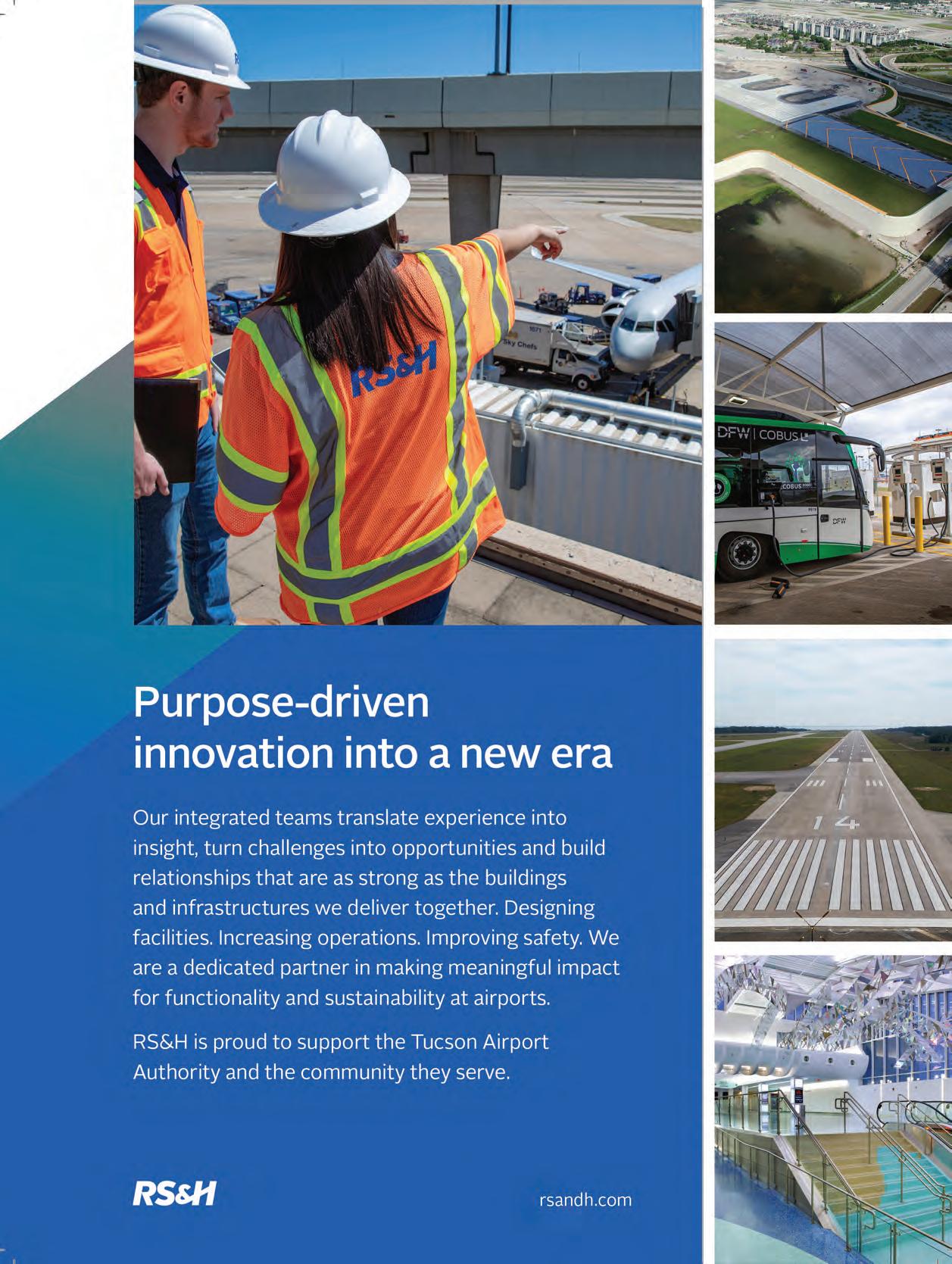


88 BizTucson < < < Spring 2023 www.BizTucson.com BizMILESTONE

Billion Investment in An Airport
$1.5
If you have a window seat flying in or out of Tucson International Airport over the next few years, you should peek outside to see the future.
Over the next decade, the airport –TUS – will likely undergo a major expansion and overhaul with a runway project already underway and the start of a major terminal expansion. In all,
 By Jay Gonzales
By Jay Gonzales
it’s a roughly $1.5 billion investment in the airport for these two projects.
“We started a study about a year ago and we wanted to see what the design would be for our projections,” said Danette Bewley, president and CEO of Tucson Airport Authority, now in its 75th year operating TUS. “What will it look like in 10 years? What will it look
like in 20, 30 and 40 years? Our plan is scalable based on demand and the growth of the region.
“We are already finding that we have some constraints at the airport in the concourses,” she said. “Airlines are on top of each other. The hold rooms are on top of each other. The concession spaces are not adequate for the level of
90 BizTucson < < < Spring 2023 www.BizTucson.com BizMILESTONE
PROPOSED RENDERING
Future for the
TUS Over Next Decade
volume we have. There are other infrastructure issues that are really going to impede our ability to function within the next five to 10 years if we don’t do something about it.”
Rather than wait, the work and planning is underway.
The runway project – or Airfield Safety Enhancement program – is in its
third year with a projected price tag of $400+ million. A runway used only by general aviation operators, which runs parallel to the main commercial runway, will be demolished, relocated, and rebuilt to the size and scale of the main commercial runway along with accompanying taxiways, access, and a modernized airfield geometry that meets the

updated safety standards by the Federal Aviation Administration – not to say the current airfield geometry is unsafe.

“This project will enhance the safety and efficiency of the airfield, and it allows for more capacity as well,” said Ken Nichols, TAA VP of planning and engineering.
continued on page 93 >>>
Spring 2023 > > > BizTucson 91 www.BizTucson.com
TOTAL GATE COUNT – 35 IMAGE COURTESY TUCSON AIRPORT AUTHORITY


92 BizTucson < < < Spring 2023 www.BizTucson.com
continued from page 91
Unlike road or freeway construction that can paralyze traffic for years – and often does – the runway project will keep traffic moving with some detours and adjustments that shouldn’t impede traffic as various phases of construction get underway.
Presuming the necessary grant funding comes in from the FAA, the airfield project should be completed in the next four to six years.
“It’s the largest and most complex project in the history of the airport,” said Bruce Goetz, TAA executive VP and COO. “The FAA is funding the majority of the project to ensure the airport infrastructure meets current standards.

“With regard to federal funding, the FAA must consider the entire National Airspace System (NAS) in their decision making. The TUS project rates very highly for federal funding because it is a safety and standards project.”
To accommodate future demand and growth, the TAA is working closely with airline partners on a scalable terminal expansion concept. The concept involves replacing outdated and aging infrastructure, adding new gates as determined by operational need, and including space and customer service amenities that today’s travelers expect.
The FAA grant process has started. However, it will take several years to go through initial design and conduct the necessary environmental analysis
and finalize concepts. When it does get going, it will be constructed in phases based on demand and growth projections, developed using several different factors, Nichols said. Today, the aim is to complete the terminal expansion in about 10 years, increasing the number of gates and adding circulation space, concessions, other amenities, and technology.
“We’ve got some good metrics,” Nichols said. “Airport planners have been analyzing ways to predict the future for a long time now. We are confident in the projections.”
These projects demonstrate the TAA’s commitment to the Southern Arizona community.
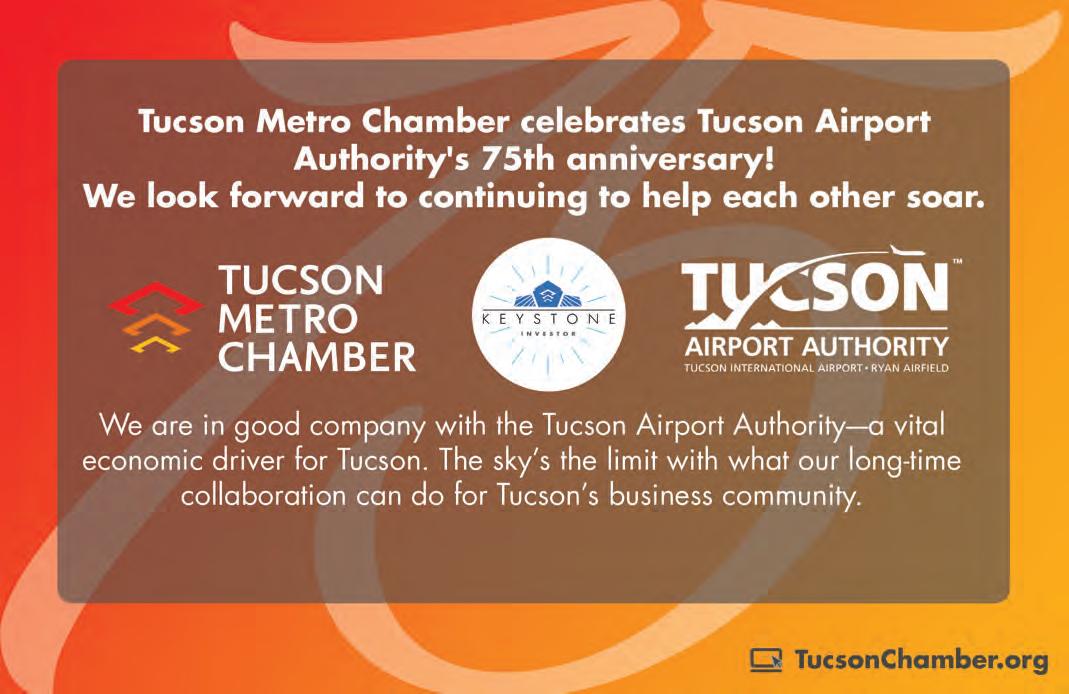
Spring 2023 > > > BizTucson 93 www.BizTucson.com BizMILESTONE Biz
“It’s the largest and most complex project in the history of the airport.”
– Bruce Goetz, Executive VP and COO, Tucson Airport Authority

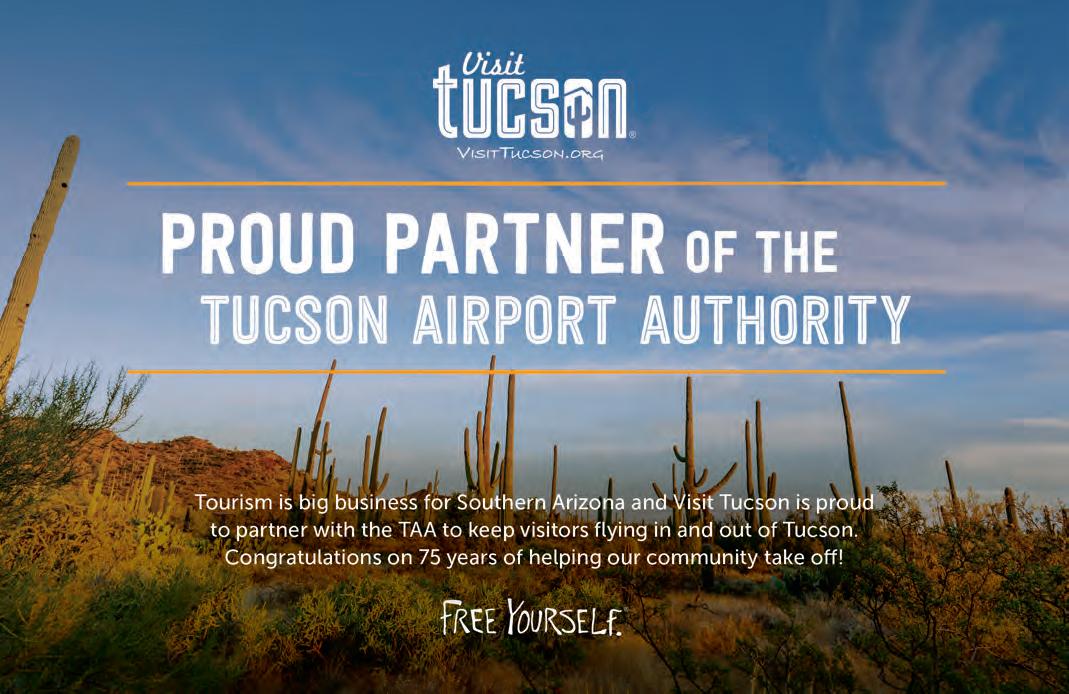

94 BizTucson < < < Spring 2023 www.BizTucson.com BizMILESTONE







96 BizTucson < < < Spring 2023 www.BizTucson.com
From left
TAA Police Chief Scott Bader
TAA Fire Chief Tom Tucker
PHOTO: BRENT G. MATHIS
PHOTO: NATALIE MOE
From Curb to Gate
Tucson International Airport Offers Top Safety, Sense of Place
By Jay Gonzales
With 3.4 million passengers passing through Tucson International Airport in 2022, that was a lot of heartbeats, stomachs to feed and hands that needed washing for the Tucson Airport Authority staff whose focus is on the customer experience.


TAA Fire Chief Tom Tucker has a simple approach when he’s asked how it feels to put his head on his pillow at night knowing the tremendous responsibility the TAA has to ensure a safe, secure customer experience for so many.
“Heavy is the head that wears the crown, right?” Tucker said. “It’s one of those things where you must be engaged all the time. You have to focus and be proactive and look down the road.”
He makes it sound so simple, but it’s not.
By Federal Aviation Administration regulations, the full-scale fire department, including special training and apparatus for aircraft firefighting at the airport, or TUS, is there to serve over 138,000 aircraft operations and nearly 3.4 million passengers that come and go each year.
“What we are here for is to provide a service to those aircraft. In the event of an aircraft fire, incident, or accident, we have statutory and regulatory requirements to provide that service and that’s our singular focus,” Tucker said. “Luckily, the airport has adopted a model where they want to take an all-hazards approach. They want that overarching response to anything, and they’ve funded it, they’ve supported it, and that’s why we’re successful.”
Likewise, the TAA police department has a dual approach to its duties. It is responsible for law enforcement and the security of the airport and every imaginable situation that can arise. Yet they try to fulfill duties with a customer service approach, said TAA Police Chief Scott Bader.
It’s a “welcome wagon” with tight security starting at the front of the airport and working back through the secure areas.
“I look at qualified individuals who have some sort of hospitality or customer service background,” Bader said of the department’s hiring practices. “I think it’s imperative in our job. The
continued on page 98 >>>

Spring 2023 > > > BizTucson 97 www.BizTucson.com
BizMILESTONE
PHOTOS COURTESY TUCSON AIRPORT AUTHORITY
continued from page 97
public is our customer, and we need to understand that we need to treat everybody with the same level of service. I tell my team that they need to treat everybody, regardless of who they are, like they would treat their own mother.”
Along the way, everyone at TUS with a customer service responsibility must be ready for anything, even a global pandemic that continues to impact how the airport operates, with increased efforts to ensure passengers feel safe.
TAA also continues to maintain its highly regarded Global Biorisk Advisory Council STAR Accreditation for sanitizing protocols and cleaning practices. Adam Kretschmer, TAA director of maintenance and custodial services, said the effort to make travelers feel safe and sanitary, and more importantly BE safe and sanitary, is never ending.
Kretschmer said TUS was one of the first airports in the world to get the Global Biorisk Advisory Council STAR Accreditation after the COVID-19 pandemic hit in 2020.
“It’s an annual certification that we
have to go through that says that we have a staff, we have the equipment, we have the training programs, to make sure that when a customer comes into our airport that they know that it is disinfected, that it is clean,” Kretschmer said. “And that’s no small feat.”
And in the end, it gives travelers the peace of mind they’re in a safe and secure environment and allows them to enjoy the fun stuff the airport offers–the art displays, the food, the shops and amenities.
“I think one of the things that the TAA prides itself on is the curb-to-gate experience,” said Jessie Allen, director of marketing and strategic communications.

TUS made it a point to engage local artists and food vendors at the airport to create a “sense of place” for those who live here and for those arriving from points abroad.
“I think it’s ingrained in us, this sense of place, that we want people to know they’re in Tucson,” Allen said. “We’re such a diverse community with open arms. It’s all about a sense of Tucson and being one big family.”

98 BizTucson < < < Spring 2023 www.BizTucson.com BizMILESTONE
“I think it’s ingrained in us, this sense of place, that we want people to know they’re in Tucson. We’re such a diverse community with open arms. It’s all about a sense of Tucson and being one big family.”
– Jessie Allen Director of Marketing and Strategic Communications Tucson Airport Authority
Biz


Spring 2023 > > > BizTucson 99 www.BizTucson.com

DEPARTMENTS
BizLETTER 4 From the Publisher BizSPACE 31 UArizona Programs Generate $560.5 Million Annually BizCHARITY 36 New Gootter-Jensen Foundation Boosts Cardiac Awareness BizMILESTONE 40 UArizona Steele Children’s Research Center at 30 Years 46 The Future of Steele: Advances on Pediatric Cancer, Disease 48 Research Center’s Top Supporters BizHONORS Father of The Year Award Honorees: 52 Peter Backus 54 Shane Clark 56 Vance Falbaum 58 Reggie Geary 60 Dave Heeke BizPRESERVATION 62 Mission San Xavier del Bac BizHONORS Greater Tucson Leadership Community Impact Awards 104 Man of the Year: Lee Lambert 106 Woman of the Year: Kathy Prather
www.BizTucson.com





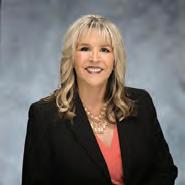
WATCH OUR IN-DEPTH COVERAGE IN APRIL & MAY


Tune in to KVOA - News 4 Tucson this Spring as our news team once again partners with BizTucson Magazine and gives you in-depth coverage of Tucson Airport Authority’s $8.3 Billion Economic Impact on our region. This is a success story, 75 Years in the making, that has definitely flown under the radar.







Other stories include the $1.5 Billion investment for the future of the Tucson Airport Authority, upgrades to the infrastructure, the national awards and insights from TAA President & CEO Danette Bewley. With the success of the TAA, the Commercial Aviation Sector is one of the region’s industries poised to climb in altitude, with overall job growth and high-demand, among the leaders in the nation. Pima Community College’s new Aviation Center will meet the workforce development demands of this industry sector, which means more high-wage jobs for Tucson.

MONICA GARCIA KVOA – NEWS 4 TUCSON ANCHOR SPECIAL REPORTS: Metropolitan Pima Alliance Tucson Airport Authority + Commercial Aviation Sector www.BizTucson.com



The globally acclaimed University of Arizona Steele Children’s Research Center, led by the visionary Dr. Fayez Ghishan celebrates 30 years. We provide an in-depth report on the researchers and physicians serving the children of Southern Arizona and discoveries that are changing the world of pediatric healthcare.
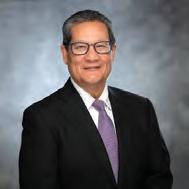

Assisting with the Steele Children’s Research Center’s fundraising efforts, the all-volunteer Father’s Day Council Tucson is gearing up for the 27th Annual Father of the Year Awards. We will provide inspirational profiles of the honorees and their families. All proceeds fund the Father’s Day Council Endowed Chair for Type 1 Diabetes Research.
We are honored to collaborate with BizTucson Magazine to bring you these stories.



12 Spring 2023
108 Founders Award: Jeannette Maré 110 GTL Alumni Excellence Award: Diana Charbonneau BizAVIATION 114 Commercial Aviation Sector Climbs in Altitude BizTALENT 120 Sun Corridor Inc. Ramps Up Talent Attraction BizCONSTRUCTION 157 New To Market: Projects in the Region BizHONORS 161 Good Scout Awards Lifetime Achievement Award: Fred Knapp 162 Good Scout Award: Barbi Reuter 163 Distinguished Citizen Award: Christie Lee BizREALESTATE 164 Commercial Real Estate Forecast (CCIM) BizWILDLIFE 168 Tucson Wildlife Center BizTRIBUTE170 Don Luria SPRING 2023 VOLUME 15 NO. 1 106 104 FEATURES COVER 65 TUCSON AIRPORT AUTHORITY’S $8.3 ECONOMICBILLION IMPACT ABOUT THE COVER Tucson Airport Authority’s $8.3 Billion Economic Impact Creative Design by Brent G. Mathis 65 121 Tucson Airport Authority at 75 Years Metropolitan Pima Alliance at 25 Years CONNECTINGYEARSTUCSON METROPOLITAN PIMA ALLIANCE SPECIAL REPORTS 65 62
ANGELIQUE
KVOA – NEWS 4 TUCSON ANCHOR SEAN MOONEY KVOA – NEWS 4 TUCSON ANCHOR
For more information, visit our website at KVOA.com
LIZARDE THE REGION’S
LUPITA MURILLO KVOA – NEWS 4 TUCSON REPORTER &
ZOE ZALDANA KVOA – NEWS 4 TUCSON ANCHOR SPRING 2023
ROBBIE REYNOLD KVOA – NEWS 4 TUCSON ANCHOR
BUSINESS MAGAZINE
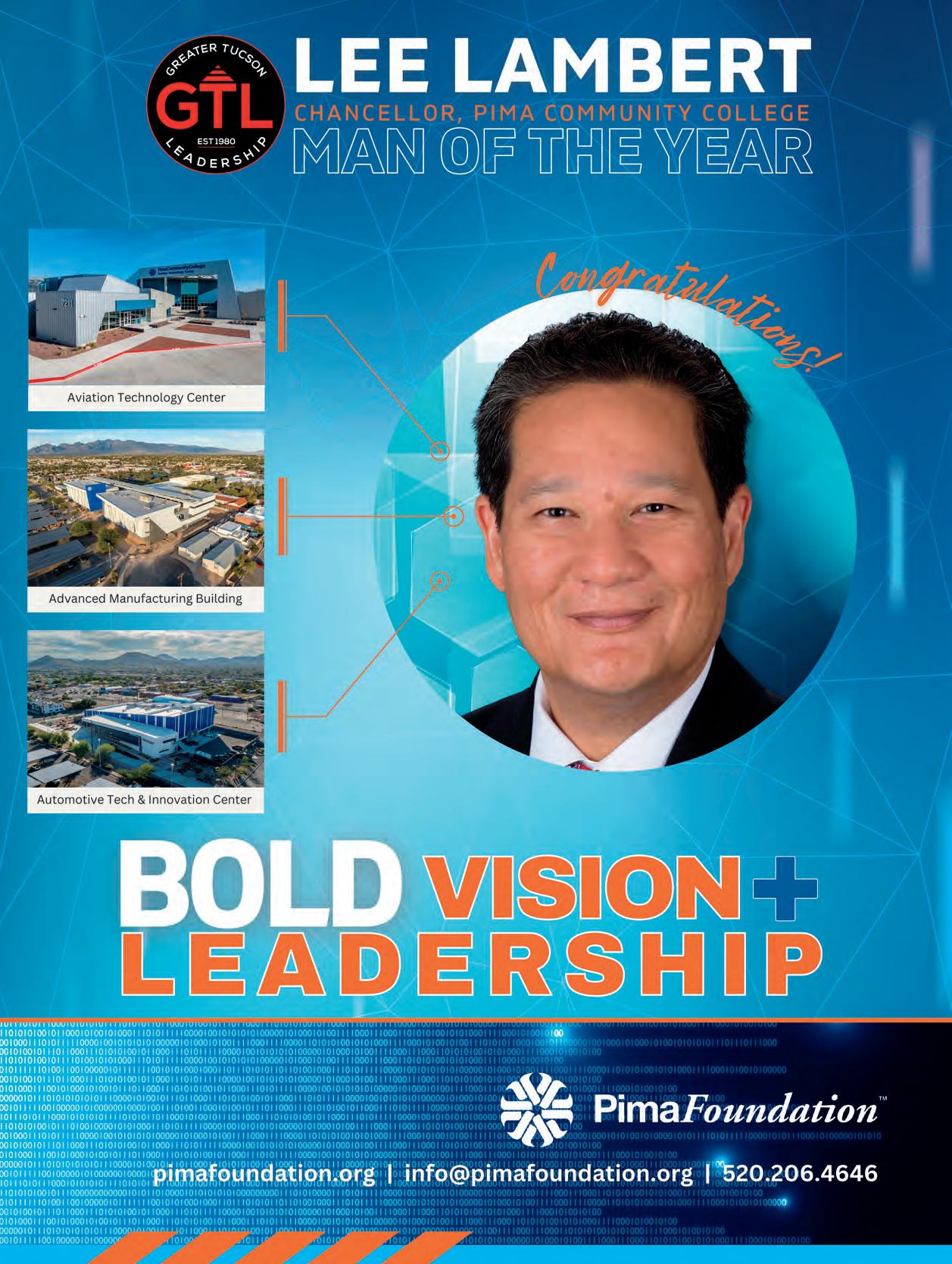
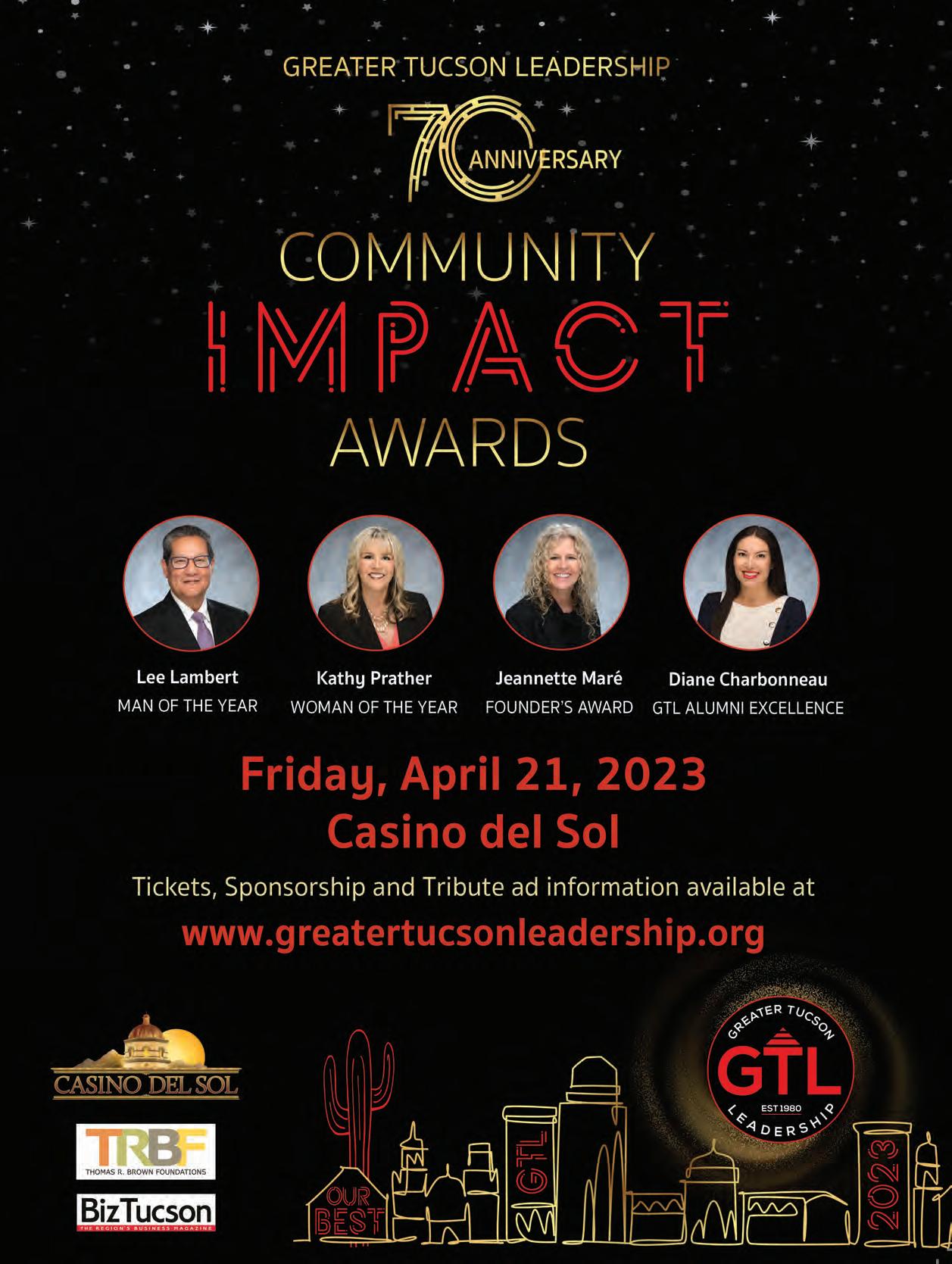



104 BizTucson < < < Spring 2023
PHOTO: CHRIS MOONEY
2022 Greater Tucson Leadership Tucson Man of the Year Lee Lambert
By Tara Kirkpatrick
His assistant was adamant.
Pima Community College Chancellor Lee Lambert was finishing a meeting that had gone late when his assistant, Gabriela De Echavarri, knocked his door and told him his next ap-
All of a sudden I see these balloons and all these people walk into the room and I was just blown away,” Lambert recalled of the day he was announced as Greater Tucson Leadership’s Man of the Year. “I was completely taken off guard, but in a good way! I’m just so
On the decade anniversary of his leadership at PCC, Lambert will be honored April 21 at GTL’s 70th annual Community Impact Awards for distinguishing himself in active support of unity projects at personal sacrifice, for aiding those less fortunate and or living in a manner which inspires affection, respect and admiration.
n Lambert was named PCC chancellor in 2013, the U.S. veteran and former president of Washington-based Shoreline Community College took the helm of a school that was facing fallout from the previous administration and was placed on probation by its accreditor, the Higher Learning Commission.
rt helped reverse those fortunes and has led PCC’s renaissance as a critical driver of workforce development and education. In 2017, he was d Chief Executive Officer of the Year by the Association of Community College Trustees — the highest honor for a community college CEO.
“Chancellor Lambert started his work at Pima Community College at a pivotal time in its history,” said

GTL CEO Justin Lukasewicz. “He has helped transform our community college into an innovative organization that is meeting the needs of the workforce and educational development in our community.”
Lambert is committed to bringing everyone to the finish line.
“In our community, there are just shy of 200,000 individuals who have low income and low wage jobs,” Lambert said. “That’s what keeps me up at night. We have to get those people into family sustainable wages.” The region’s expanding high-tech sector needs workers with advanced capabilities. “The people who can’t do that will miss out on those opportunities,” Lambert said.
During Lambert’s tenure, PCC has built a new, state-of-the-art Automotive Technology and Innovation Center, completed a $21 million expansion of its Aviation Technology Center and, later this year, will open a $35 million Advanced Manufacturing Building just three facets of the school’s Centers of Excellence in Applied Technology, Aviation Technology, Health Professions, Information Technology/Cybersecurity, Public Safety and Security, Hospitality, and Arts and Humanities.
“We went out to the community and found out what was needed,” Lambert said. “Out of that came this focus on the Centers of Excellence. We called people into group meetings and we pressure-tested this. Did we get this right? The answer was yes.”
“The key is you’re never done because things are always evolving,” he said.
Also key to PCC’s 21st century strategy, under Lambert’s leadership, has
been a focus on precision learning and micro-pathways to success in which students can seek short-term, non-degree skills which are flexibly offered and can be completed within less than a year. These can then build upon each other to increase top employment potential. It’s a concept Lambert likens to creating a playlist or building a city out of Legos.
“All the pieces are able to be connected to one another,” he said. “As a learner, I can know where my gap is and what skill I need to work on.”
Sarah Smallhouse, president of the Thomas R. Brown Foundations, which gifted a historic $2.5 million to the PCC Foundation in 2020, said the region is blessed to have Lambert as a leader.
“Workforce development is clearly one of the most pressing needs in Southern Arizona, and Pima Community College is at the heart of addressing it,” said Smallhouse. “Any group or institution engaged in workforce development in our region is collaborating with PCC. We are so fortunate to have a strategic and effective collaborator at the helm.”
“What Lee Lambert has accomplished at PCC sets it apart as a national exemplar of excellence and provides our community members pathways to 21st century productivity,” she said.
Joe Snell, president and CEO of Sun Corridor Inc., the region’s economic engine, added, “PCC, through Lee’s leadership, is joined at the hip with us through every client project. Clients considering relocation or expansion in Southern Arizona can’t say enough good things about Lee and his team. We’re thrilled he is being recognized.”
Spring 2023 > > > BizTucson 105
Biz BizHONORS
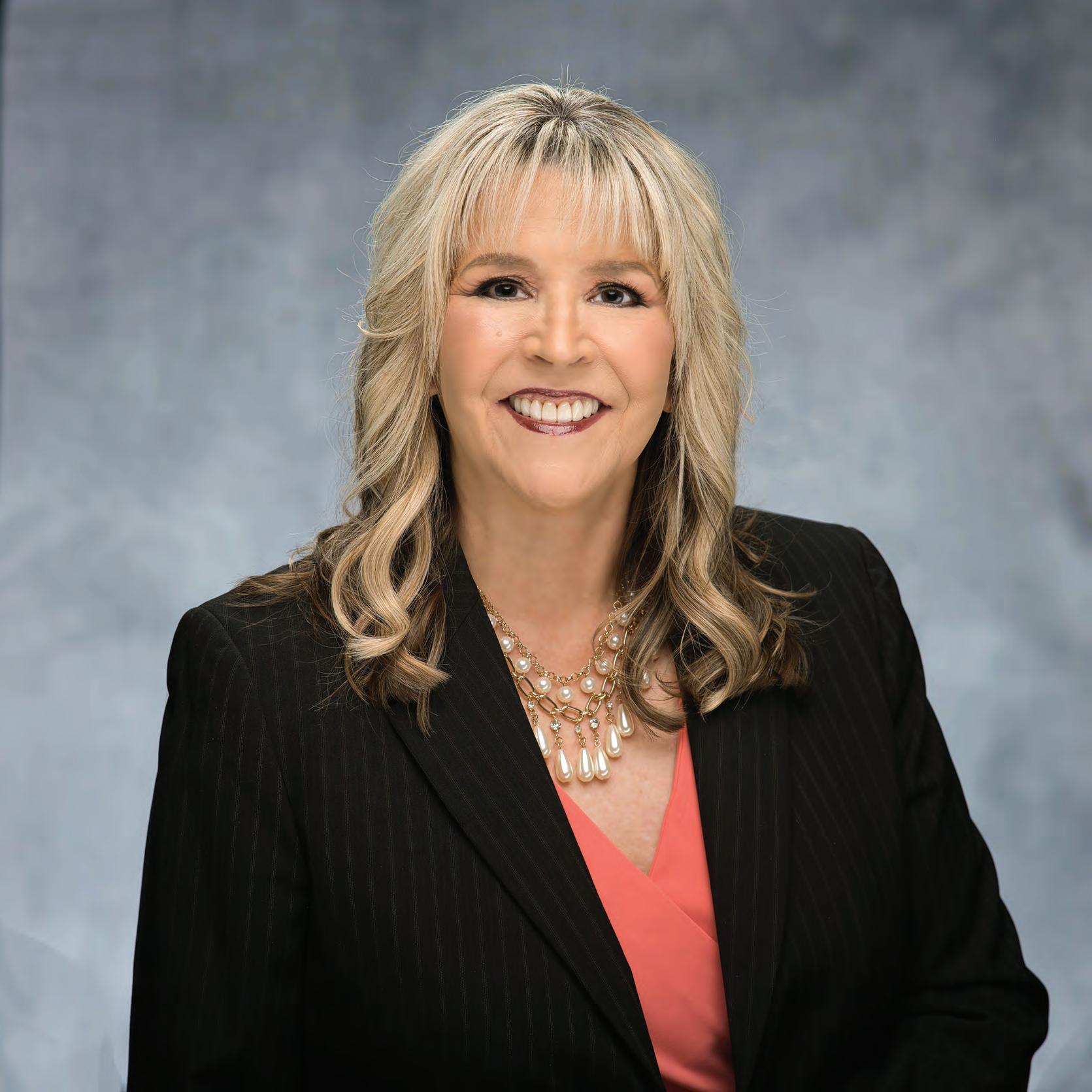
106 BizTucson < < < Spring 2023
PHOTO: CHRIS MOONEY
2022 Greater Tucson Leadership Tucson Woman of the Year Kathy Prather
By April Bourie
Kathy Prather, superintendent and CEO of Pima Joint Technical Education District is humble when asked what means for her to be the Greater Tucson Leadership Woman of the Year.

As much as I’m told the award is about my leadership, to me it is really about an appreciation of the value of Pima JTED in the eyes of the community,” said Prather. “It means Pima JTED has reached a level of community awareness and validation for the ork we’re doing.”
That may be, but according to GTL CEO Justin Lukasewicz, Prather’s leadership has made all the difference. “We’re going to have a shortage of people in the trades, and the gap is only going to get bigger,” he said. “Pima JTED is a way to connect kids to these jobs that pay well. Kathy has really helped spearhead this district over the years, and we were most impressed with how she’s taken it from a small idea to a fullfledged concept.”
Prather was involved with Pima JTED even before it was officially formed. As the Tucson Unified School District director of career and technical education, she was a big supporter of Proposition 400, which provided funds from the state and from county property taxes to form the district in 2006.
he worked to educate the community’s school boards and local businesses on the importance of creating Pima JTED and its positive potential.
Proposition 400 passed, and today, the formation of the district allows schools across the area’s districts to col-
laborate and bolster their technical and vocational education offerings, many of which are funded through Pima JTED. Students can also take advantage of the classes that are offered separately at Pima JTED’s 11 locations at no charge.
Since Prather took over as the superintendent and CEO in 2018, Pima JTED has experienced major growth. In addition to taking high-school CTE courses directly from the district, students are able to take courses through Pima Community College in a variety of industries, including aviation, automotive, construction, energy and welding technologies.
Pima JTED covers all tuition, books and fees, and the students get college credit and experience for these classes. “We have also been talking with the University of Arizona about building a health and medical careers high school so that we can have the same focus and experience of medical and health careers that we have on the other industries at PCC,” said Prather. “We’re hoping to break ground this spring.”
The district also recently collaborated with TUSD to form Innovation Tech High School, a TUSD school that opened in August 2020 and operates out of Pima JTED at the Bridges, at Park Avenue and I-10. TUSD hires the teachers and delivers the traditional academic curriculum, but the CTE offerings are provided by Pima JTED. It’s a seamless experience for the students because all classes are held in one building.
“Innovation Tech students’ ACT scores on English Language Arts ranked second only to University High students,” Prather said. “In their composite score, they were third in the city behind University and Sabino High schools.”
Pima JTED also runs Project SEARCH, which helps those with significant developmental disabilities transition from school to work successfully. The program started with 12 students a few years ago and has grown to include 25 to 30 students today. Students work at Banner South Hospital, and at other locations like the UArizona’s Highland Market, Recreation Center and BookStores to gain valuable work experience.
They also have a daily class to talk about their experiences and learn how to better perform in their positions through improved professional and life skills. “It is life-changing for these young people to be in the professional work environment and learn to be independent adults,” said Prather.
“I would like to say that the success of an organization gets back to the team and the people doing the work every day…our teachers, administrators, students, communities, parents, families and the JTED governing board,” she said. “I am grateful also to our member districts because they were the ones that came together and formed Pima JTED as a collective group.”
Spring 2023 > > > BizTucson 107 www.BizTucson.com
Biz BizHONORS
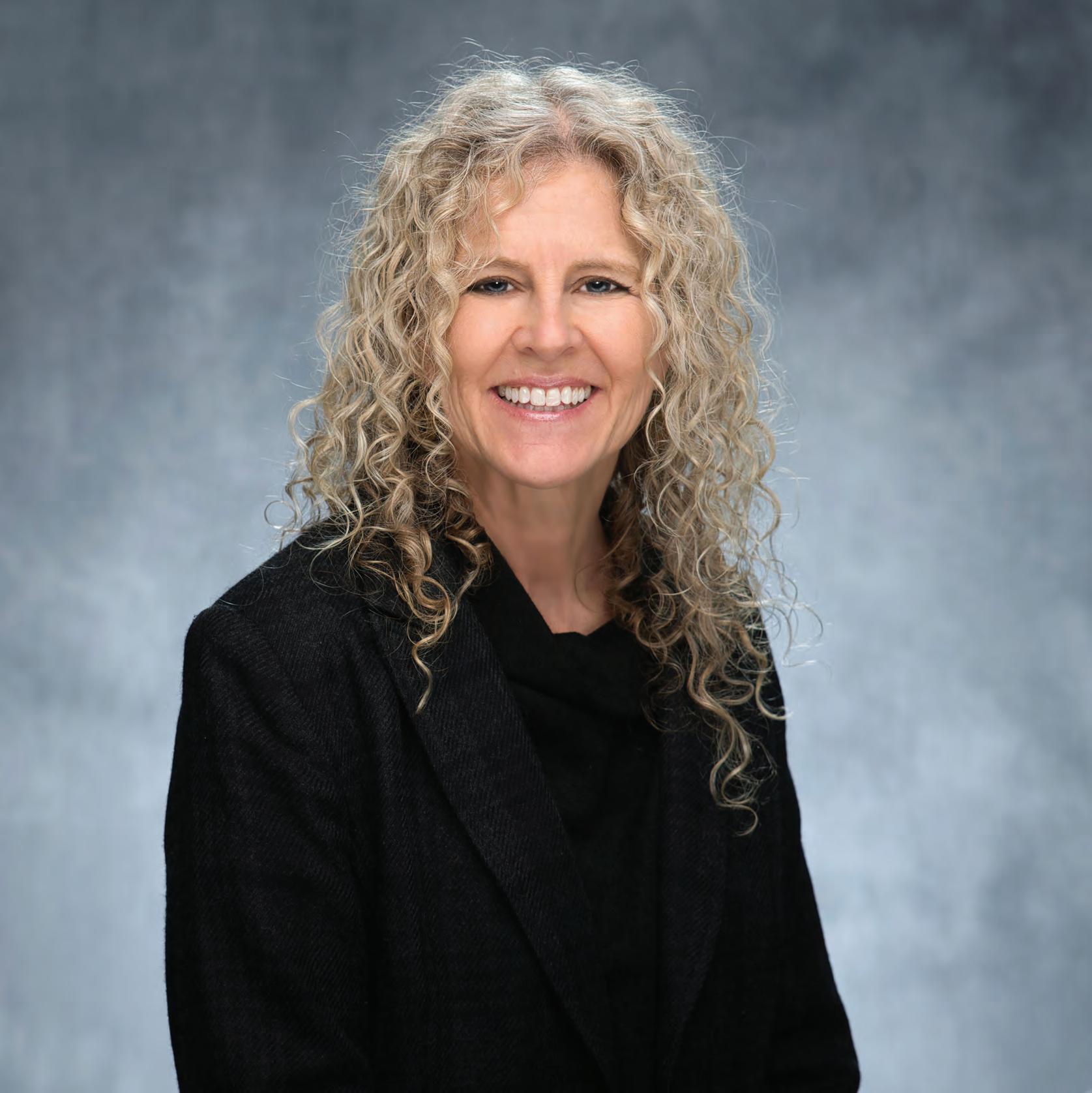
108 BizTucson < < < Spring 2023
PHOTO: CHRIS MOONEY
2022 Greater Tucson Leadership Tucson Founders Award Jeannette Maré
By April Bourie
“Ben’s Bells is ubiquitous,” said Greater Tucson Leadership CEO Jusn people think about Tucson, six to eight out of 10 of them would mention Ben’s Bells and its mantra to be kind,” he said. “Jeannette Maré is on the top of the list for people who have shaped our community.”
For her creation of Ben’s Bells and her continued impact on the Tucson community, Maré is being honored with GTL’s Founders Award.
Maré began making ceramic wind chimes in her backyard studio with friends and family to start the healing process when her son died of croup in 2002, just before his third birthday. Working with clay toward a common goal was therapeutic for her family and
At the same time, she began to notice even the smallest acts of kindness others did for her, whether from friends, rangers. “When you lose a child, you feel like you can’t survive it. It’s also scary for those around you. People don’t know what to say or do,”
“People who knew us would bring food or drive my other son to school or just sit and listen. Strangers who had no idea also made an impact on me by just smiling and saying, ‘good morning’ or opening a door or picking up my keys if I had dropped them,” Maré said. “That kindness felt like something holding me together. Collectively, all of those small acts come together to create a community culture that allows each of us to el safe and supported.”
Maré wanted to teach others about the impact of intentional kindness.
That was the beginning of Ben’s Bells, named after her son. On the first anniversary of Ben’s death, she and her friends distributed 400 bells throughout Tucson. People who found the bells shared their own stories of grief, healing and hope. The newspaper published an article, and school districts started calling to see how they could get involved.
Today, Ben’s Bells’ iconic flower with the words “Be Kind” can be found at almost every Tucson school. In addition, the nonprofit offers kindness education programming in schools and in businesses. “People need to have some skills and awareness to do kindness well,” she said. “I’m a social scientist, and I’ve learned that both the receiver and giver of kindness benefit. The more of these interactions we have, the healthier we are as a community.”
Kind Stitches is another program that Ben’s Bells offers in collaboration with the Tucson Unified School District’s Community Transition Programs. Kind Stitches provides young adults with disabilities the opportunity to learn professional embroidery skills using an industrial machine to apply the Ben’s Bells logo on apparel, bags and other materials.
The program’s students are also responsible for selling the logoed materials at local farmers markets and events. “The students are wonderful ambassadors for the work that we do,” said Maré. “The program is also beneficial for the students because they learn important life skills and aren’t isolated. They get to be members of our community with a voice. It integrates us all together.”
The founding of Ben’s Bells and Mare’s experiences in spreading kindness have led her to pursue a doctorate in kindness research. In fact, she is no longer in charge of Ben’s Bells, but she’s excited about the community’s future in the field of kindness and the founding of The Kind Communities Initiative at UArizona.

“Francene Orrok gave the monetary gift to create this initiative to support kindness research in memory of her husband Tim,” she said. “This will be a community-based participatory research program where graduate students survey community members to get an understanding of what behaviors people feel are kind. The discoveries made through this program will guide programming offered by Ben’s Bells and other community organizations and will help us do kindness better together.”
When she finishes her degree, Maré plans to work with The Kind Communities Initiative and on Banner-University Medical Center’s Patient and Family Advisory Council, helping to make the healthcare system kinder and better for employees, patients and families. “My son died at Banner, and I was treated with incredible kindness at that time. Everyone deserves to be treated that way.”
Maré feels incredibly honored to receive the Founders Award. “I was nominated by Helen Gomez and other staff at Ben’s Bells. I love these people who nominated me. I love this work and this community.”
Spring 2023 > > > BizTucson 109 www.BizTucson.com
Biz BizHONORS

110 BizTucson < < < Spring 2023
PHOTO: CHRIS MOONEY
2022 Greater Tucson Leadership Alumni Excellence Award Diana Charbonneau
By Eva Halvax
Diana Charbonneau is driven by a crucial truth: If everyone does a little, it becomes a lot.
She gives with no expectations of getting anything in return. For her, it’s all about finding a way to do your part. As a local Tucsonan, Charbonneau is devoted to serving the community she not only knows, but truly understands. Led by an unwavering commitment to address poverty, Charbonneau’s work as the development coordinator at IMPACT of Southern Arizona has earned her the 2022 Greater Tucson Leadership Alumni Excellence Award.
“I want to make Tucson a better place for my daughter,” Charbonneau said. “She’s three now, but what will Tucson look like in 15 years? That’s what I’m working toward.”
Established in 2017, the Alumni Excellence Award honors GTL alumni ho excel in implementing leadership skills in order to create long-lasting contributions to the quality of life in Tucson. Nominated by friends from a mentorship program after returning to Mexico together, Charbonneau was surprised by her nomination. Receiving such warm support from women within her network has been transformative and reminds her that she is seen and heard.
Community building is second nature to Charbonneau. After going to college in Washington D.C. and working as a lobbyist on Capitol Hill, she was struck by the disparities within the nation’s capital. She returned to Tucson to make a difference back home. Prior

to her nonprofit work, Charbonneau always found time for both work and volunteering. After reaching an impasse in her life, she realized it was time to meld the two.
Then, Charbonneau found IMPACT of Southern Arizona, a nonprofit that, through a dedicated network of volunteers, provides those in need with community education, workshops, youth services, and emergency resources along with food and clothing. In her role, Charbonneau is responsible for building integral partnerships with the community, fundraising, presentations and more.
“At IMPACT, we have 11 staff members and over 170 volunteer shifts a week. We rely heavily on our volunteers,” Charbonneau said. Thanks to these volunteers, IMPACT has built a successful web of action. In 2003, the Golden Goose Thrift Shop was established in partnership with SaddleBrooke Community Outreach and provides the bulk of IMPACT funding. IMPACT has been able to reinvest $3 million back annually into the community.
When it comes to generational poverty, Charbonneau said many locals may be unaware of IMPACT Arizona’s services − something that hits close to home for Charbonneau, who grew up in Oracle where the closest grocery store was an hour away.
“I never knew living in Oracle that we were living amongst poverty,” she said. “I didn’t know any better. That’s why generational poverty is such a
struggle and people who have privilege cannot understand it. ‘Well why can’t you go and do something else?’ Because they do not think there is something for them. They have watched this happen. It keeps you very humble.”
These are cycles that may seem impossible to break, and of course without systematic intervention, the issues persist. IMPACT works to connect community members with resources to heed the overall goal − moving people forward.
But the work doesn’t stop there. Charbonneau’s free time is filled by volunteering for other local organizations, specifically ones that empower women, and is president of Gender Equity for Women. She has learned the importance of taking time for herself and having a strong support system.
“I’ll be honest, the people that I work with, we all burn out. We couldn’t do what we do without working at maximum capacity,” she said, adding that she has taken up horseback riding and enjoys dirt bike riding and spending time outdoors.
“Diana is a fixture in the nonprofit community here in Tucson,” said GTL CEO Justin Lukasewicz. “As a young professional, it is amazing to see her reach in the community. The breadth of resources and services that IMPACT of Southern Arizona has in our community connects so many in need. Diana plays an important role in servicing the Tucson community through this organization.”
Spring 2023 > > > BizTucson 111 www.BizTucson.com
Biz BizHONORS
Emerging Strategies to Help Employers Build More Innovative Health Benefit Packages
By Heather Kane
While encouraging a healthier workforce has long been a priority for many employers, several recent trends have sparked a renewed emphasis for some organizations. A competitive labor market, high inflation, and the lingering effects of the COVID-19 pandemic have many employers focusing on offering more innovative benefit packages. The goal is to help attract and retain team members, spur productivity, and reduce the incidence of preventable medical events and costly chronic conditions.
It’s time well spent, according to studies that show a healthier workforce may help improve productivity and bolster a company’s bottom line. In fact, work illness and injury cost U.S. employers $225 billion each year. With medical care ranking as the second largest expense behind salaries, it is vital employers help maximize the value of their health benefits.
During an era marked by remote work and fewer in-person meetings, employers are confronting numerous new challenges when it comes to supporting the health of their employees. At the same time, advances in technology and changes in consumer preferences have paved the way for more personalized programs in connection to health benefit plans.

To help employers in Arizona make better health benefit decisions, here are five emerging strategies to consider:
Reward Employees for Wellness Activities
Most U.S. employers offer well-being programs, and some include financial incentives for meeting certain health targets, such as reaching a daily steps goal or maintaining a healthy body mass index. To make these initiatives more appealing and engaging, some
employers are incentivizing a growing number of healthy activities, including filling out a health survey, selecting a primary care physician, getting a biometric screening, meeting certain movement goals, or tracking sleeping. Plus, instead of virtual coins or rewards that can only be used to help pay for medical care, some programs are starting to enable enrollees to annually earn gift cards worth hundreds of dollars annually — and spend them in any way. Wearable devices and digital fitness apps can also play an important role, providing employees with daily feedback on their activity levels while helping provide access to live or on-demand fitness classes.
Expand Access to New Types of Virtual Care
Nearly 90% of Americans surveyed said they want to continue using vir-
112 BizTucson < < < Spring 2023 www.BizTucson.com BizHEALTHCARE
SPONSORED CONTENT
tual care for non-urgent health needs, while 76% of employers grew their virtual care offerings in response to the pandemic. Virtual care, also called telehealth, has expanded from treat ing urgent care issues, such as allergies, rashes, or seasonal flu, to now provid ing access to other types of care, includ ing primary, specialty and behavioral. Company and human resources lead ers should continue to assess and refine virtual care options currently available to employees through their health plan, local care providers, or other virtual service providers. Leaders can also look to add emerging virtual care resources such as those for physical therapy, dermatology, and women’s health.

Help Address Social Determinants
A recent survey of large employers found nearly 80% already have or plan to take steps to help address social determinants of health, such as access to affordable housing, nutritious food, and reliable transportation. Research shows that social determinants of health –more so than what happens in the doctor’s office – may influence up to 80% of a person’s health. That’s why some employers are using predictive analytics to proactively identify employees who may be dealing with social issues, and then connect them with low- or no-cost community resources, which may help them save on utility and internet bills, childcare costs, and even home repairs. Other strategies being pursued by employers include funding
“lifestyle accounts” to help pay for gas, monthly debit cards or onsite pantries for nutritious foods, and “call a friend” wellness initiatives to help address social isolation.
Add a Plan with Upfront Pricing
Some health plans are doing away with deductibles and instead giving employees first-dollar coverage, coupled with access to upfront pricing information before they schedule medical appointments. In doing so, these plans may help remove financial barriers to care and encourage people to select quality, cost-efficient health care pro-
viders and facilities. In many instances, mployers are offering a traditional health plan alongside one of these newer options, which may help reduce the total cost of care for employers and lower out-of-pocket costs for employees.


Evaluate Coverage Options for Intermittent Workers
More than 59 million Americans are part of the “intermittent workforce,” meaning they are not employed in traditional full-time roles. The intermittent workforce includes part-time and asonal hourly W-2 employees and full- and part-time W-2-contingent contractors employed by staffing firms. To help recruit and retain these workers in a competitive job market, employers can now provide access to health benefit options by adding limited medical plans. When compared to traditional medical benefits, these plans can offer lower monthly premiums and the elimination of deductibles and copayments for virtual visits. It’s worth noting, while these plans are designed to help provide important access to medical care at more affordable prices, coverage restrictions will apply to some medical services.
Employers are in a unique position to help improve the health and of employees. By considering these emerging health benefit trends, employers may help support the well-being of employees now and in the future.
Spring 2023 > > > BizTucson 113 www.BizTucson.com
SPONSORED CONTENT
Heather Kane CEO UnitedHealthcare Employer & Individual Arizona & New Mexico
Biz

114 BizTucson < < < Spring 2023
Fasten Your Seatbelts, This Industry Sector is Taking Off
By Dave Perry
Tucson has all the parts needed for its commercial aviation sector to climb in altitude.
Among the assets – storied military and industrial history, thriving aviation companies, a commitment to advancing a skilled workforce, educational institutions, land, and collaboration. The weather’s just right, too. A current emphasis for growth is Maintenance, Repair and Overhaul, or MRO, companies.

“Think of them as garages for airplanes,” said Allen Kinnison, VP of Southern Arizona Leadership Council.
“Everything from simple oil and tire changes...to inspections...to major overhauls, repairs and modifications.”
Chief among MRO companies at Tucson International Airport (TUS) are SkyWest Airlines, MHIRJ Aviation Group, Bombardier Tucson Service Centre, and Ascent Aviation Services. They employ a large number of skilled workers–many of whom trained at Pima Community College’s adjacent Aviation Technology Center, which just completed a $21 million upgrade.
G. MATHIS
Spring 2023 > > > BizTucson 115 www.BizTucson.com
BizAVIATION continued
on page 116 >>> IMAGE BY BRENT







 Bombardier Tucson Service Centre
Pima Community College
Atlantic Aviation
MHIRJ Aviation Group
Sargent Aerospace & Defense
Universal Avionics
Ascent Aviation Services
Bombardier Tucson Service Centre
Pima Community College
Atlantic Aviation
MHIRJ Aviation Group
Sargent Aerospace & Defense
Universal Avionics
Ascent Aviation Services
116 BizTucson < < < Spring 2023 www.BizTucson.com
SkyWest Airlines
Pima Community College’s newly expanded 87,000-square-foot Aviation Technology Center.
Matthew Nichols, a spokesman for Bombardier, shared why his company is here. “The Southern Arizona labor market and important aerospace presence offers a large talent pool to support the service center’s continuing growth,” he said.
In the last year, the PCC Aviation Technology Center doubled its capacity from 125 to 250 students who are training as airframe and power plant mechanics. Many of those students start their study in the Pima Joint Technical Education District. With a fast track it calls Part 65, PCC can accelerate military veterans, and others with relevant experience, through an eight-week refresher course ahead of licensing exams.
More than 150 graduate each year. Right away, nine in 10 find work with MROs and other aviation-focused businesses in Tucson and Arizona. “We sometimes have students with three different job offers,” said Greg Wilson, PCC dean of applied technology.

“Most of the people who want to go through our program want to stay local,” PCC Chancellor Lee Lambert said. “That’s a selling point as we’re trying to court these other employers.”
PCC’s program “makes our market one of the most competitive for MRO training in the country,” said Susan Dumon, senior VP of economic competitiveness at Sun Corridor, Inc.
“Our program is known across the country,” Wilson added. “The program is definitely a success, and is meeting the needs of industry. We need to generate more of them.”
Beyond workers, MROs need access to runways, and space for facilities to work on aircraft. At 8,282 acres, TUS is one of the 10 largest commercial airports by landmass in America. Of that land, up to 5,160 acres is targeted for development, with runway access nearby to accommodate business needs.
“The Tucson Airport Authority is fortunate to have a sizeable amount of land surrounding its airports,” said TAA President and CEO Danette Bewley. “For the last 75 years, those who have managed the airport have been strategic in accumulating land for both aeronautical and non-aeronautical uses. We continue to work with our federal and regional partners to assess, devel-
op and market the land, which we’ve coined as the Sonoran Commerce Center at TUS, to benefit the airport system and our entire region.”
MROs “don’t want to look at raw land with no infrastructure available,” Dumon said. So, to pursue the opportunity, TAA has created several shovelready properties now on the market. Each site has “all the things you need for a client to consider it.”
The region has been “really close on several MRO projects,” she continued. “We would not be able to compete had the airport not made that investment into those pad-ready sites.”
Dumon added that weather is also a reality in growing the commercial aviation sector. “It’s exactly what these types of companies want. It’s why MROs want to be here.”
Airplanes have been parked, and flown, and fixed, in and around Tucson for decades. The presence of Davis-Monthan Air Force Base, as well as Hughes Aircraft and its successor Raytheon Missiles & Defense, the region’s top private employer, provides the “foundation for so many of these companies to either start here and grow, or to make a decision to locate here,” Dumon said.
Add in the region’s thriving avionics industry, producing electronic systems used in aircraft, and Tucson has the fifth-highest concentration of aerospace and defense employees in America. It helps, too, that between them, the University of Arizona and Arizona State University granted more than 6,000 engineering degrees in 2019 and 2020.

The region has the “knowledge workforce” desired by industry. Dumon said. It’s also a city of 1 million people with an international airport, one that “punches above their weight.”
Local collaboration is also essential and regional leaders are committed to growing the aviation sector and to attract new business.
“I’ve heard this time and again from site selectors, and companies directly, that very candidly said ‘you can’t fake that. You can try all you want, but if you all aren’t working together it’s obvious to us,’” Dumon said. Those site selectors continue: “It’s apparent to us that you are collaborating, and that weighs heavily in your favor.”
“That’s what a potential business wants to see,” PCC’s Wilson said. “We don’t do our work in isolation.”
“It’s dry, and it’s warm, which is good,” said SALC’s Kinnison. “You can run an indoor / outdoor business in and out of a hangar, and leave the doors open.” Likewise, aircraft can sit in warm, dry conditions without falling apart.
“That’s why, during the pandemic, there were aircraft parked everywhere they could possibly fit them,” Dumon said.
“To have a community where you have that level of alignment with key partners to support an industry sector, I think that’s huge, and to do it in a community of a million-plus people is even more important,” PCC’s Lambert said. “That’s a special thing. It depends on leadership. Right now, we have leadership aligned.
“I see so many good pieces here, and, as long as we don’t get in the way of ourselves, we all rise together,” Lambert said. “Pima County is in this great place, and I hope we can sustain and maintain that momentum, and not just in the aerospace sector.”
Spring 2023 > > > BizTucson 117 www.BizTucson.com
continued from page 115 Biz
“To have a community where you have that level of alignment with key partners to support an industry sector, I think that’s huge, and to do it in a community of a million-plus people is even more important.”
BizAVIATION
– Lee Lambert Chancellor Pima Community College
Companies Fueling the Commercial
With two locations in Southern Arizona and one in New Mexico, Ascent Aviation Services is one of the largest aircraft maintenance operations in the world providing fully integrated aviation maintenance, repair, and overhaul, heavy maintenance, storage, reclamation, modification, interior, and paint services to owners, operators, and lessors of wide body, narrow body, and regional aircraft. A Class IV 14 CFR part 145 certified Repair Station maintaining approvals and certifications from regulatory authorities globally, including FAA, EASA, BDA/AMO, TCCA, NCAA, and 2-Reg. Experts in comprehensive full life aircraft care, providing solutions for a wide array of commercial aircraft at all three locations. The company employs 450 people.


Bombardier Tucson Service Centre

A global leader in aviation, focused on designing, manufacturing, and servicing the world’s most exceptional business jets, the Quebecheadquartered Bombardier operates its Tucson Service Centre at TUS. Bombardier has a worldwide fleet of approximately 5,000 aircraft in service with a wide variety of multinational corporations, charter and fractional ownership providers, governments, and private individuals. Bombardier aircraft are also trusted around the world in special-mission roles. The company’s Tucson Service Centre is a key part of its corporate network. The facility provides a comprehensive set of services for customers, including scheduled and unscheduled maintenance, interior modifications, avionics installations, paint and aircraft on-ground support for Bombardier Learjet, Challenger and Global aircraft.
Aviation Group

MHIRJ provides comprehensive, critical operational, engineering and customer support solutions, including maintenance, refurbishment, technical publications, marketing and sales activities for the global regional aircraft industry. Headquartered in Montréal, Quebec, and bolstered by an Aerospace Engineering Center, MHIRJ’s network of service centers includes an MRO location in Tucson, which offers comprehensive aftermarket and support services with facilities servicing the CRJ family fleet.
Acquired by Parker Hannifin, Parker Meggitt is a global aerospace and defense company with headquarters in the United Kingdom. Its four global divisions include more than 9,200 employees across 37 offices. Its Oro Valley, Ariz. company, Securaplane, is a leading supplier of avionics products for business, commercial, and military aircraft including airborne video cameras, security systems, emergency and main ship batteries, battery chargers, inverters, and wireless control systems. With extensive technical capabilities and industry experience, Securaplane works with airframe manufacturers and operators. Its products are installed by major aircraft manufacturers including AgustaWestland, Airbus, Boeing, Bombardier, Cessna, Dassault, Embraer, Gulfstream, Hawker Beechcraft, and Sikorsky.

118 BizTucson < < < Spring 2023 www.BizTucson.com
Aviation Sector
Sargent Aerospace & Defense
Founded in 1920, Sargent Aerospace & Defense is a designer and manufacturer of precision‐engineered hydraulic assemblies, bearings and sealing rings serving the commercial, military, aerospace and industrial markets. Sargent’s Marana headquarters were expanded in 2011 into a new facility that measures 155,000 square feet. That includes 45,000 square feet of open shop floor and 27,000 square feet of office space. In total, the campus houses manufacturing, design engineering, quality and business management functions and employs more than 350 people. The company’s products are used in a variety of applications on airplanes, helicopters and nuclear submarines. Sargent Aerospace & Defense was acquired by RBC Bearings in 2015.

Airlines
SkyWest opened a maintenance operation at TUS in 2002 and over the next decade, moved into 63,000 square feet of a larger 235,000-square-foot hangar originally built for Lockheed Martin. SkyWest is one of the chief MRO businesses operating at the airport. The company announced last year that it would be expanding its TUS presence, adding 50 new jobs. It also recently donated retired CRJ200 airframes and parts to Pima Community College to provide students enhanced skills training.
Universal Avionics’ 165,000-square-foot corporate headquarters in Tucson is home to electronic assembly, test and repair facilities, which build and support its avionics products for customers around the world. The company is a subsidiary of Elbit Systems Ltd. in Israel, a major defense manufacturer and world leader in military aerospace, which acquired Universal Avionics in 2018. Universal Avionics safely guides pilots and their passengers globally with forward fit and retrofit solutions flying on more than 35,000 airplanes and helicopters today. As a leading manufacturer of innovative commercial avionics, Universal improves safety and efficiency for business aviation, airline/ cargo operations and special missions.
Fixed Base Operators – FBOs

Companies at TUS and Ryan Airfield that provide aviation services such as fueling, hangar, tie-down and parking, aircraft rental, aircraft maintenance, flight instruction and other hospitality services:


Atlantic Aviation
Executive Air
Million Air Tucson

Tucson Jet Center
Velocity Air
Biz
Spring 2023 > > > BizTucson 119 www.BizTucson.com Biz
AVIATION
Today’s Visitor, Tomorrow’s Talent
Sun Corridor Inc. Ramps Up Talent Attraction, Social Media Campaigns
By Tara Kirkpatrick
As potential talent looks for new cities to live and work, Sun Corridor Inc. is seizing upon the results of a firstever study it commissioned to find out what talent across the U.S. thinks about Tucson and Southern Arizona.
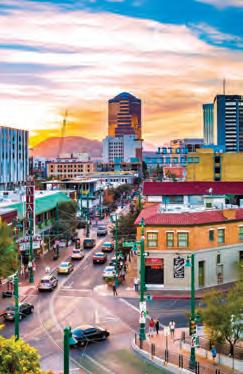
Among many insights, the survey shows Southern Arizona is viewed positively as a place to visit. Its time to convert that visit into a stay, and the region’s economic development engine is all over it.
Talent acquisition has been a key focus for Sun Corridor Inc. since it created a post-pandemic Pivot Playbook in 2021 to advance the region after COVID-19. To that end, the organization first created the theme “Thrive in Tucson”, launching a website to show just how easy, affordable and advantageous this city is for new workers.
“We decided to really develop a robust program...to attract talent from outside Pima County,” said Laura Shaw, senior VP for Sun Corridor Inc. “First, we needed to make sure that we knew what talent actually thought of Tucson and Southern Arizona. I think this is the first study of its kind that’s been done here.”
The study, conducted by New York marketing firm DCI last fall, surveyed 1,500 working-age adults in California, Colorado, Illinois, Texas and Washing-
ton–300 from each state. Through the lens of lifestyle factors such as quality schools, cost of living, safety, amenities and many others, the study zeroed in on perceptions of Tucson and Southern Arizona.
Its key findings included:
• Tucson and Southern Arizona are viewed positively as a place to visit, with few overall negative perceptions among those surveyed.
• Talent is reprioritizing the importance of lifestyle-related factors but overall, job opportunities, safety and security, and cost of living will help sell the region.
• Tucson has a significant opportunity to appeal to visitors who are there to experience the outdoors and cultural assets.

• Potential talent values messages about our location, lifestyle/climate, key industries/job opportunities and marketing Tucson as more than a college town or retirement community.
• Respondents labeled the region adventurous, relaxed, welcoming, historic and fun.
Overall, 64% of those surveyed were familiar with Southern Arizona. Talent most interested in relocating here were established in career and family life, and were also more likely to be influenced by stories in the media and rankings. Still, some respondents weren’t familiar with Tucson or the region’s growing economy. So, the work begins to market aggressively.
“We have a lot of opportunity to really make sure people think of Tucson as a place to live and work, after their visit,” Shaw said.
Talent turns to media, rankings and social media to find out about regions to move to.
Sun Corridor Inc. is now partnering with Visit Tucson and Pima County to showcase the region’s best qualities. In addition to ThriveinTucson.com, new “Thrive In Tucson”-themed social media channels are now live on Instagram, Facebook, and LinkedIn. Some new influencers have been vetted who will serve as chief ambassadors. A new digital ad campaign will cap off the program.
“Talent finds out about communities through either Googling or social media,” Shaw said. “So, those campaigns are now live, with new content and increasing numbers of followers. We are very excited.”
120 BizTucson < < < Spring 2023 www.BizTucson.com
BizTALENT Biz What can you do to support this campaign? Forward these links and social media to your own professional networks, friends, colleagues, clients and partners to share why Tucson and Pima County are great places to live and work. Be an ambassador for Southern Arizona. 350+ DAYS OF SUNSHINE 10,000+ NEW JOBS IG Stories treatment 350+ DAYS OF SUNSHINE TOP 100 Cities to live 10,000+ NEW JOBS IG Stories Logos Image treatment IG Stories Logos Image treatment
METROPOLITAN PIMA ALLIANCE










CONNECTING


FOR 25 YEARS

SPECIAL REPORT 2023 THE REGION’S BUSINESS MAGAZINE
TUCSON

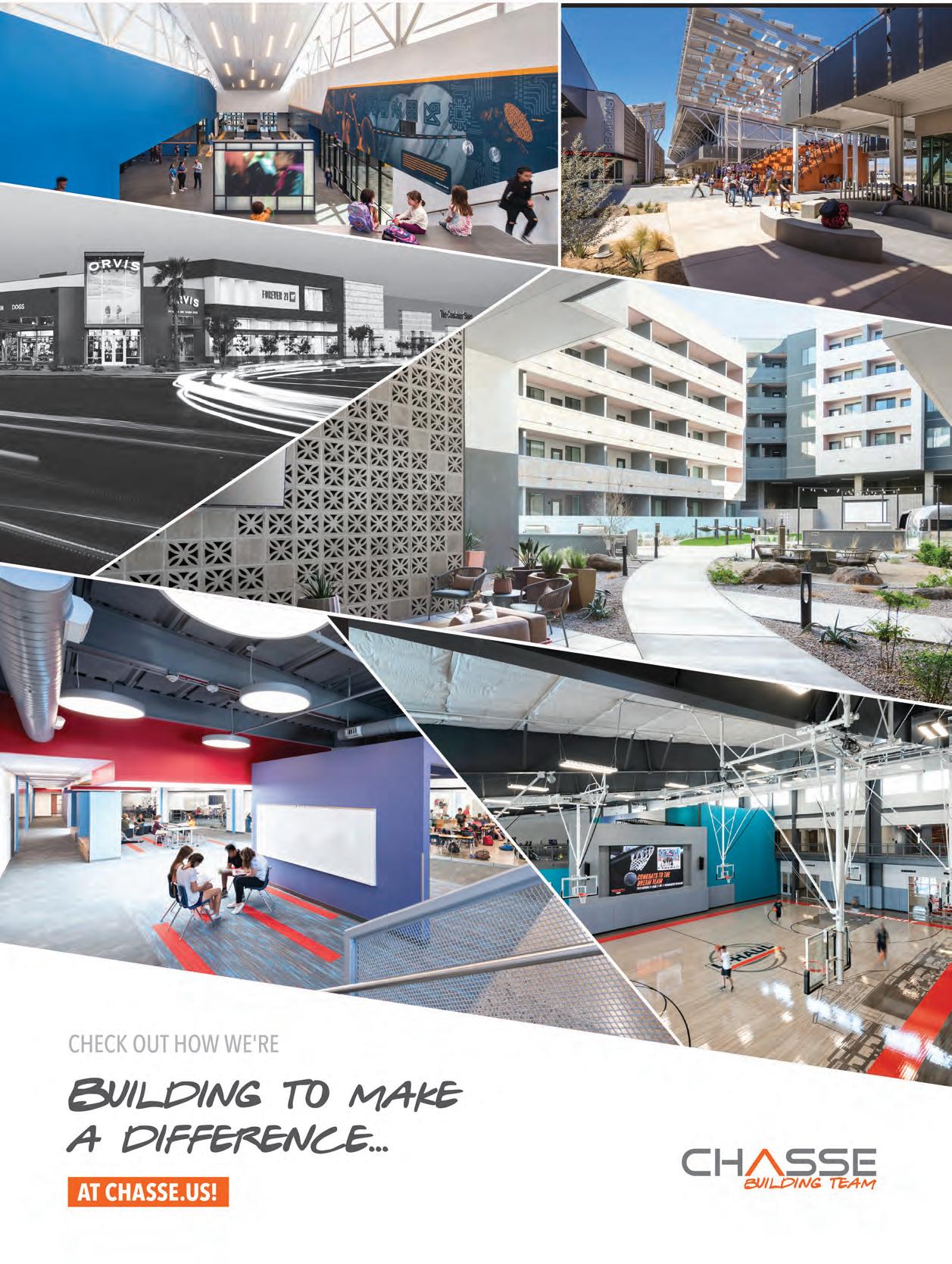







TIMELINE MPA Common Ground Projects 2006 – 2021 Oro Valley Marketplace Rita Tech Park, Target Distribution Center 2006 2008 124 BizTucson < < < Spring 2023 www.BizTucson.com 25
Connecting for Success
MPA’s 25 Years as Facilitator and Connector for Southern Arizona
 By Romi Carrell Wittman
By Romi Carrell Wittman
“Rising tides raise all ships. Many hands make light work. A problem shared is a problem halved.”
Those three passages – the first one used frequently by President John F. Kennedy − have come to express that people and organizations can accomplish more and do things better when they work together. It’s been the focus of the non-profit Metropolitan Pima Alliance for the past 25 years.
MPA has served as a driving force for responsible growth and development throughout Southern Arizona by connecting key stakeholders and fostering collaborative discussions. Doing that leads to comprehensive solutions that consider the impact on the environment, the local economy and the quality of life of people in the region.



Since its inception, MPA has grown to become a respected, influential organization and now has more than 150 members, including real estate developers, architects, planners, utilities and community leaders.
Together, the stakeholders work to positively and sustainably promote the region through education, advocacy and collaboration. MPA’s impact can be seen in a number of significant projects. The organization played a crucial role in the creation of the Rio Nuevo Multipurpose Facilities District, which has been instrumental in the revitalization of Downtown Tucson. Additionally, MPA has been involved in the creation of the Chuck Huckleberry Loop, a 131-mile trail system that connects the region’s parks and communities. Most recently, it played a role in the redevelopment proposal for the Oro Valley Marketplace by connecting town officials, community members and developers. “Organizations like MPA bring forward an education piece for the community that demonstrates best practices and what sustainable living looks like in other communities and what it could look like here. That helps move projects forward,” said Keri Silvyn, partner at Lazarus & Silvyn, a land-use

continued on page 127 >>>

TIMELINE
Civano North Ridge, Sustainable Community Twin Peaks Area Development
UniSource Energy Corporate Headquarters
2009 2010 2011 2012 Spring 2023 > > > BizTucson 125 www.BizTucson.com BizMILESTONE
Arizona Baseball moves to Hi Corbett


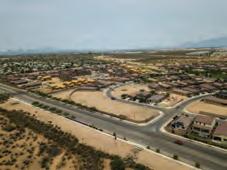

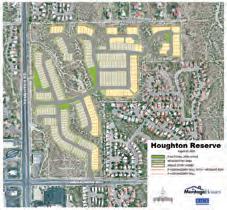

TIMELINE 2016 2013 2015
La Estancia Masterplanned Community
Plaza Centro and The Cadence Development
RTA, Houghton Road Corridor Improvements
126 BizTucson < < < Spring 2023 www.BizTucson.com BizMILESTONE PHOTO: BRENT G. MATHIS MPA Common Ground Projects 2006 – 2021 continued
From left – Terry Klipp, Terramar Properties; Allyson Solomon, MPA Executive Director ; Linda Morales, Owner & CEO, The Planning Center, MPA Board Member; Ryan Stucki, SVP at Engineering & Environment Consultants, MPA Board Chair; Alice Templeton, Communit y Relations, Special Projects, Stantec.
The Oro Valley Village Oasis Park will be a place where visitors young and old can enjoy a variety of activities including dining, exercise, recreation, relaxation, playgrounds, walking paths, art and music venues.
– Leigh-Anne Harrison Executive Director CHASSE MPA Board Member
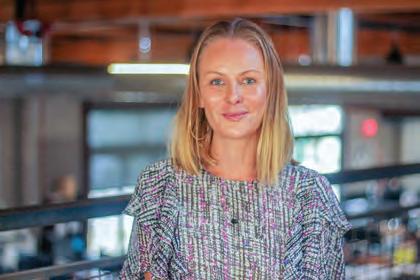
continued from page 125
law firm involved with the Oro Valley Marketplace revitalization project.

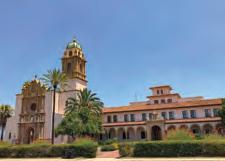



r the direction of new owner TownWest, Oro Valley Marketplace will be redeveloped to include residential, el, retail and recreational spaces. Silvyn said MPA has been a key part of the project’s success by connecting and



Founded by a small group of businessmen in 1997, MPA was created in response to a growing need for a collaborative, community-driven approach to real estate development and land-use planning. At the time, there was rowing public concern that development in the region was happening without adequate input from the community or consideration for the impact on the environment. aking inspiration from the Phoenix-based Valley Partnership, MPA’s founders saw an opportunity to create a platform where businesses, government officials and community members could work together.
Michael Grassinger, principal consultant with The Planning Center and past MPA Board Chair, was at the proverbial – and in this case literal – table when MPA was continued on page 128 >>>
TIMELINE 2017 2018 2019 2021
Tucson City of Gastronomy, UNESCO Designation
Westside Redevelopment, MSA Annex, Monier, Caterpillar
The Benedictine Monastery Adaptive re-use
Pima County Historic Courthouse Renovation
TANGERINE HOTEL
ORO VALLEY VILLAGE CENTER
Spring 2023 > > > BizTucson 127 www.BizTucson.com
Working together for the common good. This is what MPA’s Common Ground Awards celebrate and why we were so excited to celebrate 25 years of collaboration and growth.”
continued from page 127
formed. While having dinner at The Iron Mask − today Kingfisher occupies the space − Grassinger, Allen Lurie and Frank Thompson sketched out their concept for what would become MPA.
“Our goal was to create an organization that was educational and a place for all parties to communicate what their concerns were and try to work things out,” Grassinger said.
Terry Klipp of Terramar Properties also was a key player in MPA’s early days. “Land use was a very divisive topic,” he said. “Tucson has been a growth/no-growth town for 50 years or more.”
As a result, there was growth without robust planning and there were many unhappy community members and businesspeople.
The MPA founders knew that involving both public and private sectors was critical to the organization’s long-term success, so they sought out a diverse group of members to represent virtually all aspects of the community. Early advocates of MPA included the Tucson

Association of Realtors and the Southern Arizona Home Builders Association – two groups that are still strong supporters. Today, Pima Association of Governments, Tucson Electric Power and the University of Arizona are also
represented on MPA’s board and its membership reflects the region’s diversity and uniqueness.
Ryan Stucki, SVP at Engineering & Environment Consultants and current MPA board chair, said, “Conversations began happening that didn’t used to happen. We can show that there has been success in providing that connectivity. Most of the government agencies proactively come to MPA now to get input.”
But there is still work to be done.
MPA board member Linda Morales of the Planning Center said communication and collaboration will always be a work in progress and MPA has positioned itself to address it head-on.

“MPA frames issues around the goal of making Tucson a better place,” she said. “MPA brings the community together to have intelligent conversations around promoting sustainable development and healthy communities. We’ve made strides, but we still have a ways to go.”
MPA hosts monthly policy meetings, quarterly educational events and work-
128 BizTucson < < < Spring 2023 www.BizTucson.com
“Working together, MPA’s Common Ground Award and event concept was developed.”
– Priscilla Storm VP
Diamond Ventures MPA Board Member
shops to provide the latest information on market trends and policy issues. In 2020, MPA created a new educational program known as “Immersion” with the goal of providing attendees indepth knowledge regarding each component of the construction, real estate and development sectors in Southern Arizona. These programs and events also serve to help stakeholders who share the common goal of uplifting the region to network.
Robin Shambach said these events along with her time on the MPA board and serving as board chair were invaluable. “MPA is fact- and content-driven and they host high-quality events that provide really good data,” she said. “The connections and trust these events – and MPA – foster make healthy collaboration possible.”
MPA also believes in celebrating the community’s wins. With that in mind, it created the annual Common Ground Awards. The event honors and celebrates collaborative efforts in real estate development and land-use planning in the region. Awards are given to
outstanding projects that demonstrate how diverse stakeholders have worked together to achieve common goals and create a positive impact on the community.
Priscilla Storm was the Diamond Ventures representative on the MPA board when she came up with the idea to “recognize land development projects that worked with stakeholders” and shared the idea with the board and staff.
“Working together, MPA’s Common Ground Award and event concept was developed,” Storm said. “The first Common Ground event established a series of major project categories and solicited applications that included extensive public, private and non-profit collaboration and showed how compromise and innovation could produce shared success.”
Hector Jimenez, owner of Central Barrio Development, won a Common Ground award for The Flash project. Built in 1965, Flash TV served Tucsonans for decades before falling into disuse. Jimenez re-envisioned the historic property as an affordable housing op-

tion combining residential with workspaces. Working with a very tight budget, Jimenez successfully saw the project through. The City of Tucson has cited the project as a model for others, one that has set the stage for future projects.
“Winning a Common Ground award was a validation of the hard work that we spent years putting in,” Jimenez said.
This year’s awards take place May 18 at the Fox Theater Tucson. CHASSE Building Team is the presenting sponsor.
“As a company, when we began establishing roots and a home office in Tucson over 10 years ago, it was clear to us this community was not like others in Arizona,” said Leigh-Anne Harrison, executive director at CHASSE. “We attribute this difference, this desire to solve, rather than create problems, to the notion of Working together for the common good. This is what MPA’s Common Ground Awards celebrate and why we were so excited to celebrate 25 years of collaboration and growth.”
Spring 2023 > > > BizTucson 129 www.BizTucson.com
Biz
BizMILESTONE

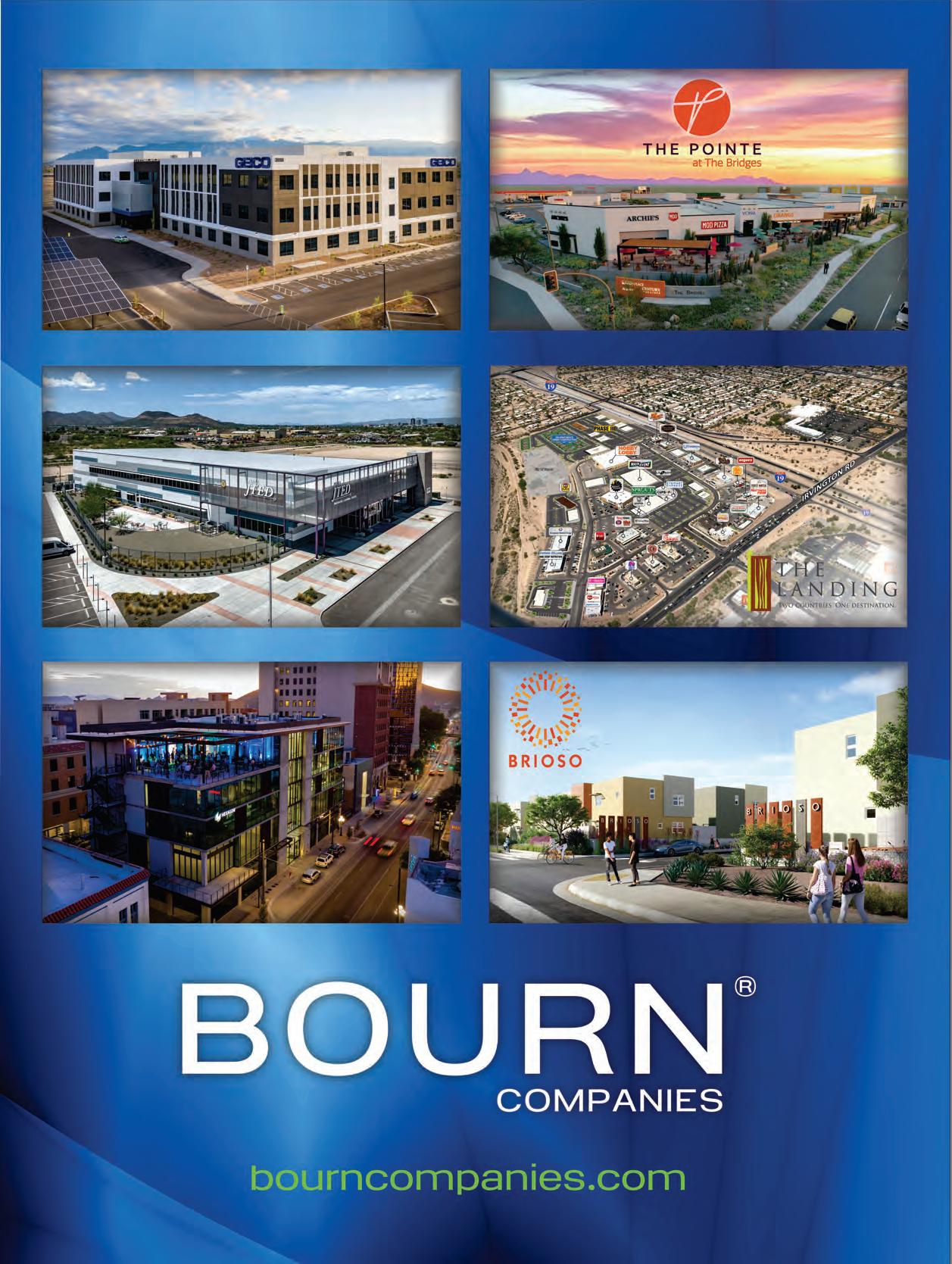


Empowering the Future
MPA’s ‘Immersion’ Program Connects, Educates
By Romi Carrell Wittman
MPA’s Immersion program trains the next generation of community leaders to better address the region’s growth and development by furthering knowledge, collaborating and working toward common goals.
Designed for early- to mid-career professionals working in the areas of land use, construction, planning, development and real estate, the threemonth program accepts a new cohort of 10 to 15 students each fall.
“These are complicated issues,” said Robin Shambach, principal at BWS Architects and a former MPA board chair. “People coming up in our com munity who are involved in land use need to understand all factors that play into that. Immersion gives robust infor mation about how things happen in our community and how to build relation ships.”
Immersion hosted its first class in 2020. Each cohort includes industry professionals carefully selected to en sure a variety of disciplines and expe riences are represented. The program hosts a single cohort each year, which takes place in the fall and covers 10 topics. Led by industry professionals and community leaders, each session is two hours long.
Linda Morales, current MPA board member and owner of The Planning Center, has sent students through the program. “Immersion gives a broad view of the development industry, which is not something my employees are necessarily exposed to,” she said. “It’s good for them to understand the
pieces that come before and after what we do (at The Planning Center). That perspective makes for a better consultant.”
MPA Executive Director Allyson Solomon added, “In the Immersion program, you’re going to work with people who are on your same trajectory – people who, while they might not be within your segment of the industry, are still working in land use and development as a whole. And later you have
the chance to be a mentor to the next generation.”
Alumni highly recommend the program and attest to the significant benefits they have received from it, such as the connections they forged throughout the program and a deeper understanding of the development industry.
Immersion alumnus Hector Jimenez said his time in the program was a great experience. Jimenez’s company, Central Barrio Development, recently received accolades for The Flash, a redevelopment project just south of downtown along Sixth Avenue and 19th Street. Formerly the Flash TV & Appliance Store, the property will feature commercial areas as well as residential living spaces. Jimenez won an A Common Ground award for the
“I tend to put my head down and work and don’t network as I should,” he said. “We tend to work in silos and don’t understand what each of the players do in their respective fields.”
Jimenez said Immersion helped to connect him with people with similar goals as well as those with different perspectives. “Going into it, you know the other people are on a similar path. It creates more fruitful relationships, which, in turn, will yield better projects for the region in general.”
Robin
Principal BWS Architects Former MPA Board Chair
Jimenez was so impressed with his experience that he’s sent others through the program. “Graduates better understand the process,” he said. “They see it from all sides. Industry in general is fragmented and we tend to work within

132 BizTucson < < < Spring 2023 www.BizTucson.com
BizMILESTONE
how things happen in our community and how to build relationships.”
–
Shambach
our own capabilities and strengths. That means we don’t always know what other professions are doing or the ways a decision made at one point can affect the whole process.”
Teresa Vasquez of HSL Properties is an Immersion student. “The Immersion program is a unique opportunity to interact with the community’s future leaders in small group settings,” she said. “These types of interactions tend to produce genuine bonds that ultimately pay dividends down the road.”
Vasquez added that the program has helped her to see her work in a broader context and from different perspectives, which ultimately refreshes her view.
“In my opinion, the industry and community benefit in two ways,” she said. “First, it helps create deeper bonds between future community and industry leaders that lead to real progress. Second, it helps break down professional silos that inhibit personal and community growth.”
Tucson Electric Power has also sent students through the Immersion program. MPA board member and TEP staffer Camila Martins-Bekat said that TEP benefits greatly from the knowledge employees gain in the program.
“It’s an opportunity for TEP to provide value to employees for their professional development,” she said, “and it’s an opportunity to get close to our customers and learn about their customer experience. We hope to send one person through in each class.”

Spring 2023 > > > BizTucson 133 www.BizTucson.com Biz
left
From
Teresa Vasquez, Camila Martins-Bekat and Hector Jimenez
PHOTO: BRENT G. MATHIS




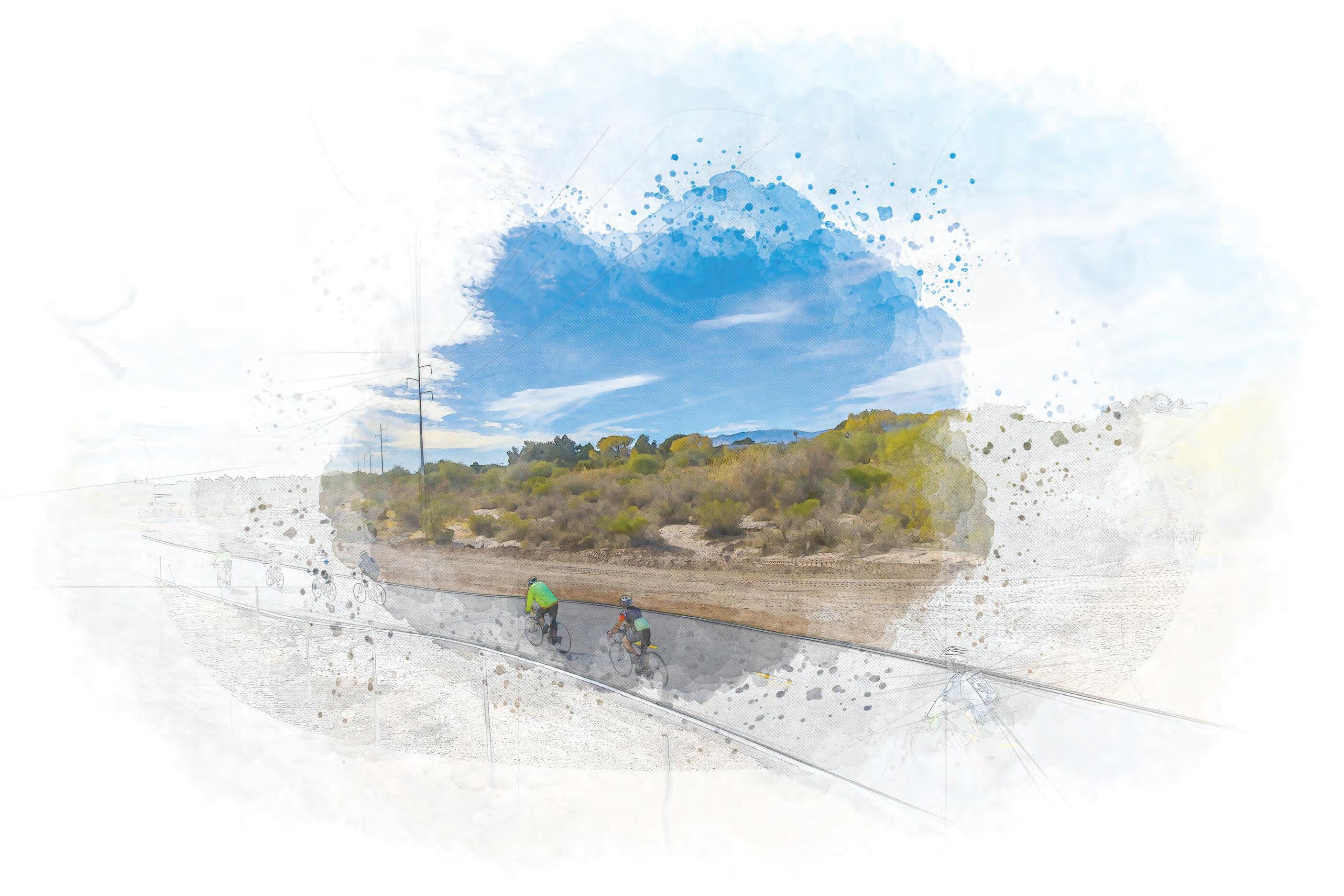
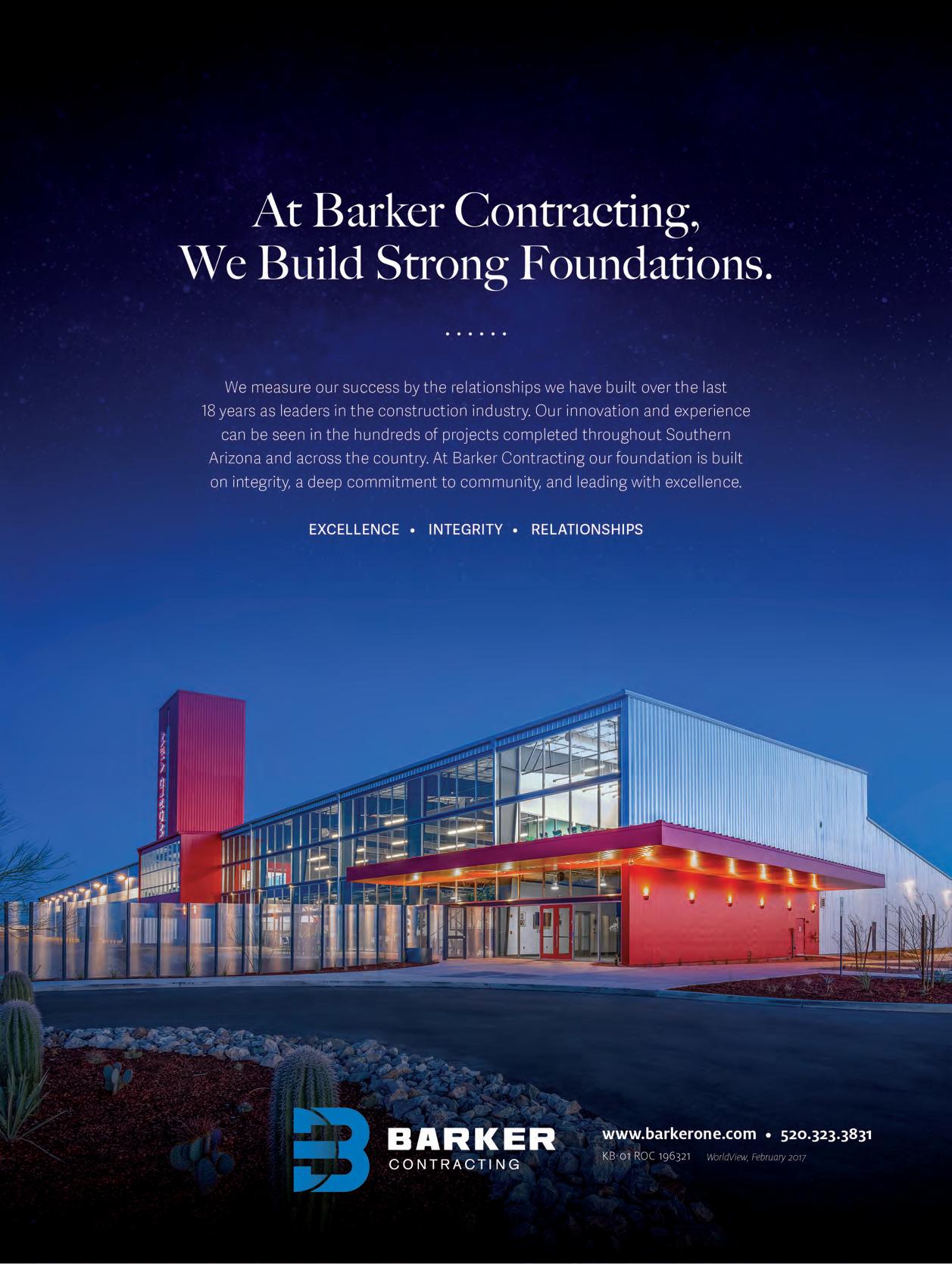
1
10 Projects Making a Difference

Public, Private & Community Coming Together with Common Ground
The Metropolitan Pima Alliance exists to help pull multiple interests together and promote collaboration for the region to be able to use its business and public resources for the overall good of the community.
Chuck Huckelberry Loop
Virtually every local government jurisdiction participated in the development of the 137-mile Chuck Huckelberry Loop, Tucson’s multiuse, off-street path that has garnered numerous national and local awards, including an MPA Common Ground Award.

The Loop winds throughout the Tucson metro area touching Pima County, Marana, Oro Valley, Tucson, South Tucson, the Tohono O’odham Nation and the Pascua Yaqui Tribe. It is the longest off-street path of its type in the country.
The Loop runs along and over all the major river systems or waterways in the area: the Rillito River, the Santa Cruz River, the Pantano Wash, the Julian Wash Greenway and the Harrison Greenway. It also links a number of feeder washes including the Tanque Verde Wash, the Cañada del Oro Wash, and north and south of the Santa Cruz River.
Voted the Best Recreational Trail by USA Today in 2021, the Loop has become a major economic driver for the region and enhances its reputation as a bicycle-friendly area that boasts the El Tour de Tucson annual cycling

event and other events throughout the year.
“The Loop is fast becoming a key economic driver, offering expanded recreational opportunities throughout the region; attracting biking enthusiasts, bird watchers, and other tourists; an alternate transportation mode; im proving air quality; providing a safe, accessible exercise option for the com munity,” Pima County said in its nom ination of the project for the Com mon Ground Award in 2012. “More than one-third of the metropolitan population lives within a half mile of the Loop or Loop Links.”
The Loop has also received privatesector support with funding. Busi nesses now locating along the path are creating additional economic devel opment opportunities.
The Loop was named for former Pima County Administrator Chuck Huckelberry in 2018. Huckelberry, an avid cyclist, was instrumental in the development of the Loop. He was honored at an Oct. 22 event at the Loop as he recovered from injuries he suffered in an accident while on his bicycle in Downtown Tucson in Oc tober 2021.
Since 2007, MPA has awarded proects that are examples of what collaboration can accomplish. The following projects are 10 that are the prime examples of how MPA’s role has helped pave the way for projects that involve multiple jurisdictions and multiple interests.
“ These 10 Common Ground Award Winners have had a large impact not only on the real estate and development community, but all of Tucson,”

www.BizTucson.com Biz
BizMILESTONE
10 PROJECTS MAKING A DIFFERENCE
Allyson Solomon Executive Director Metropolitan Pima Alliance
City of Tucson Sun Link Streetcar
Credited by many as the most important development to jumpstart Downtown Tucson’s revitalization, the $197 million Sun Link Tucson Streetcar was named an MPA Common Ground Project of the Decade in 2014.
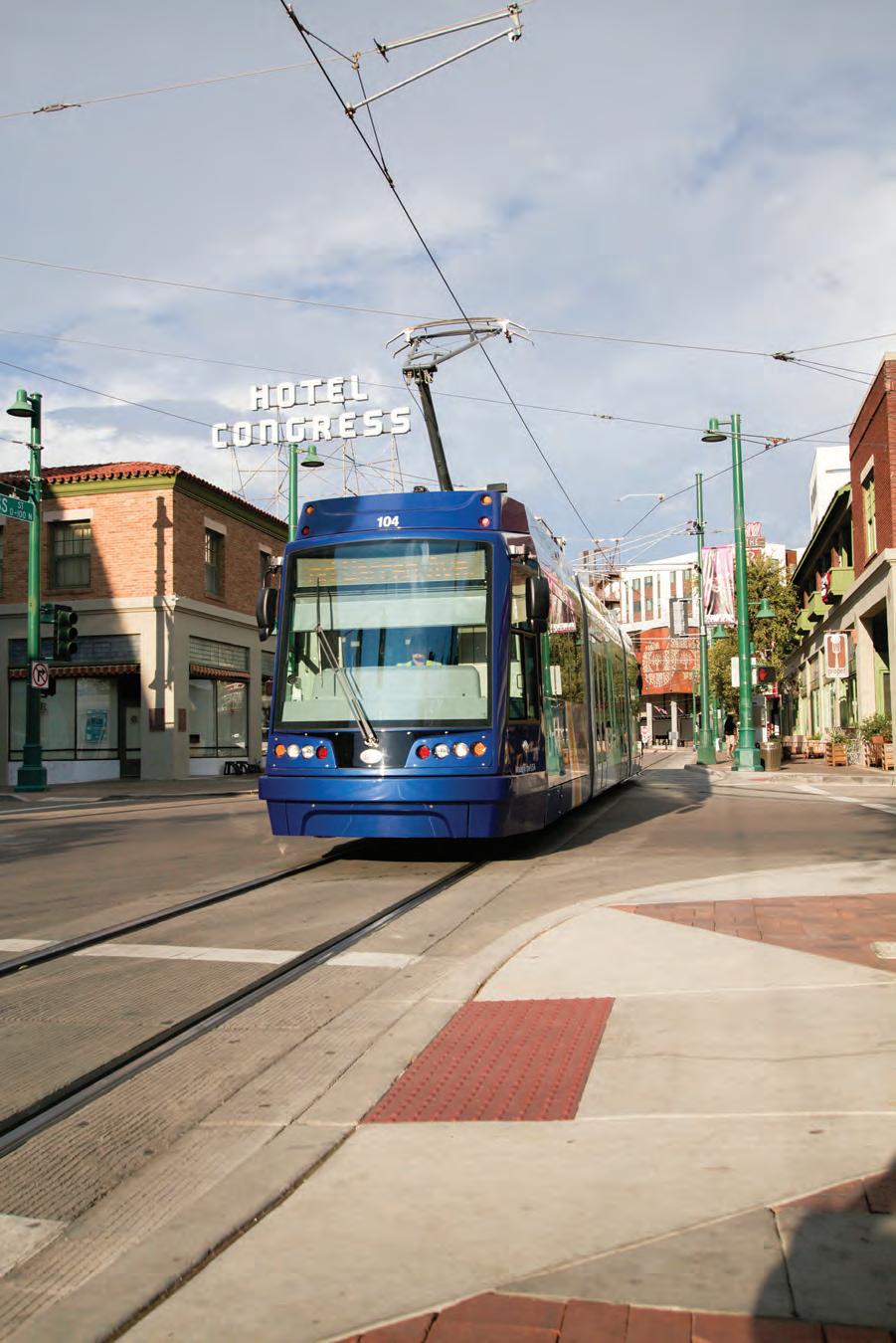
Sun Link, which is operated by the City of Tucson through Sun Tran, is the first fixed-rail transit system in Southern Arizona and is widely considered the largest and most complex construction project in the city’s history.

The four-mile route begins at the Mercado District west of Interstate 10 and passes through Downtown, the Fourth Avenue business district, University Main Gate Square and UArizona on its way to the Arizona Health Sciences Center north of Speedway.

“Sun Link is integral to the creation of a region-wide seamless transit system and provides easy connections to Sun Tran, select Sun Shuttle routes, and UA CatTran,” Sun Link said in its nomination for the Common Ground Award. “More than a historic transit system, Sun Link connects the more than 100,000 people who live, work, study and play within walking distance of the streetcar corridor.”
The Sun Link project is part of the ongoing $2.1 billion Regional Transportation Plan approved by Pima County voters in May 2006. The project is primarily funded by the Regional Transportation Authority – or RTA − and through federal and other regional funds. The City of Tucson and RTA co-managed the project with key partners including UArizona and the Arizona Department of Transportation. The Federal Transit Administration Region 9 monitored the project along with a project management oversight team.
Jim Campbell, a commercial and residential developer who oversaw the Plaza Centro/Cadence project downtown, said at the time of the award that his development would not have occurred without the streetcar.
“Plaza Centro is the first private-sector, ground-up development in Tucson in 30 years and there was a reason for it – the streetcar,” Campbell said. “There is a reason that housing at The Cadence is in such demand, and retail space at Plaza Centro is 100% occupied – the streetcar.”
138 BizTucson < < < Spring 2023 www.BizTucson.com BizMILESTONE Biz
10 PROJECTS MAKING A DIFFERENCE 2

Pima Community College’s Center of Excellence in Applied Technology is the first in a long-term PCC strategy to unite the various interests in business, education and government for the overall good of the region’s economic development.
The Center of Excellence in Applied Technology at the PCC Downtown Campus provides educational opportunities for students while working to meet the demand for a skilled workforce for companies looking to locate in Tucson.
Additional centers of excellence are planned in information technology, health professions, public safety and security, hospitality leadership and the arts. The Applied Technology center focuses on advanced manufacturing, transportation technology and infrastructure.

“Instructors with extensive real-world experience will teach a curriculum that has been developed in handin-hand coordination with business and industry,” PCC Chancellor Lee Lambert said in the project’s Common Ground Award nomination. “Additionally, communityservice providers and industry associations will have access to be strategically located at the (centers of excellence) for better connectivity to our students.”
In developing its long-term strategy for the centers of excellence, PCC cited research in 2018 that middleskilled jobs accounted for 53% of the state’s labor mar-
ket, but only 47% of the state’s workforce was training in those areas.
“Pima Community College recognizes that we as educators must adapt quickly to meet employers’ needs,” said Greg Wilson, dean of applied technology at PCC. “Our vision for the center of excellence is that in partnership with our community, we will provide high-quality, in-demand programs that cultivate an agile workforce.”
Don Theriault, president of Tucson-based Industrial Tool, Die & Engineering Inc., said the Advanced Manufacturing building will make PCC the top school in Arizona for state-of-the-art facilities and training.
“PCC is leading the state of Arizona and this will to be a cutting-edge place for learning advanced manufacturing and robotics,” said Theriault, a leader of the local industry group Southern Arizona Manufacturing Partners.
“Our Center of Excellence in Applied Technology will address the region’s need for skilled workers who will form the foundation of a stable, prosperous community,” Lambert said. “By providing a work-ready talent pool for employers, the CoE will enhance metro Tucson’s attractiveness to companies seeking to establish or expand operations at a fast-growing crossroads of national and international commerce.”

140 BizTucson < < < Spring 2023 www.BizTucson.com BizMILESTONE Biz
10 PROJECTS MAKING A DIFFERENCE 3
Pima Community College Center of Excellence in Applied Technology


Spring 2023 > > > BizTucson 141 www.BizTucson.com
Pima
Association of Governments, Regional Transportation Authority and 20-year Transportation Plan
When voters approved a half-cent sales tax in 2006 to fund transportation projects in the region, it was estimated the 20-year plan would pour about $2 billion into roadway projects with the Regional Transportation Authority managing the funds. The RTA is tasked with collecting the tax revenues throughout Pima County and making sure the funds are spent on allowable expenses, mostly new construction.
Multiple projects that have had RTA involvement have won MPA Common Ground Awards.
Nearly all roadway projects involve collaboration among at least three entities, the RTA said. There also is private sector involvement in some projects.
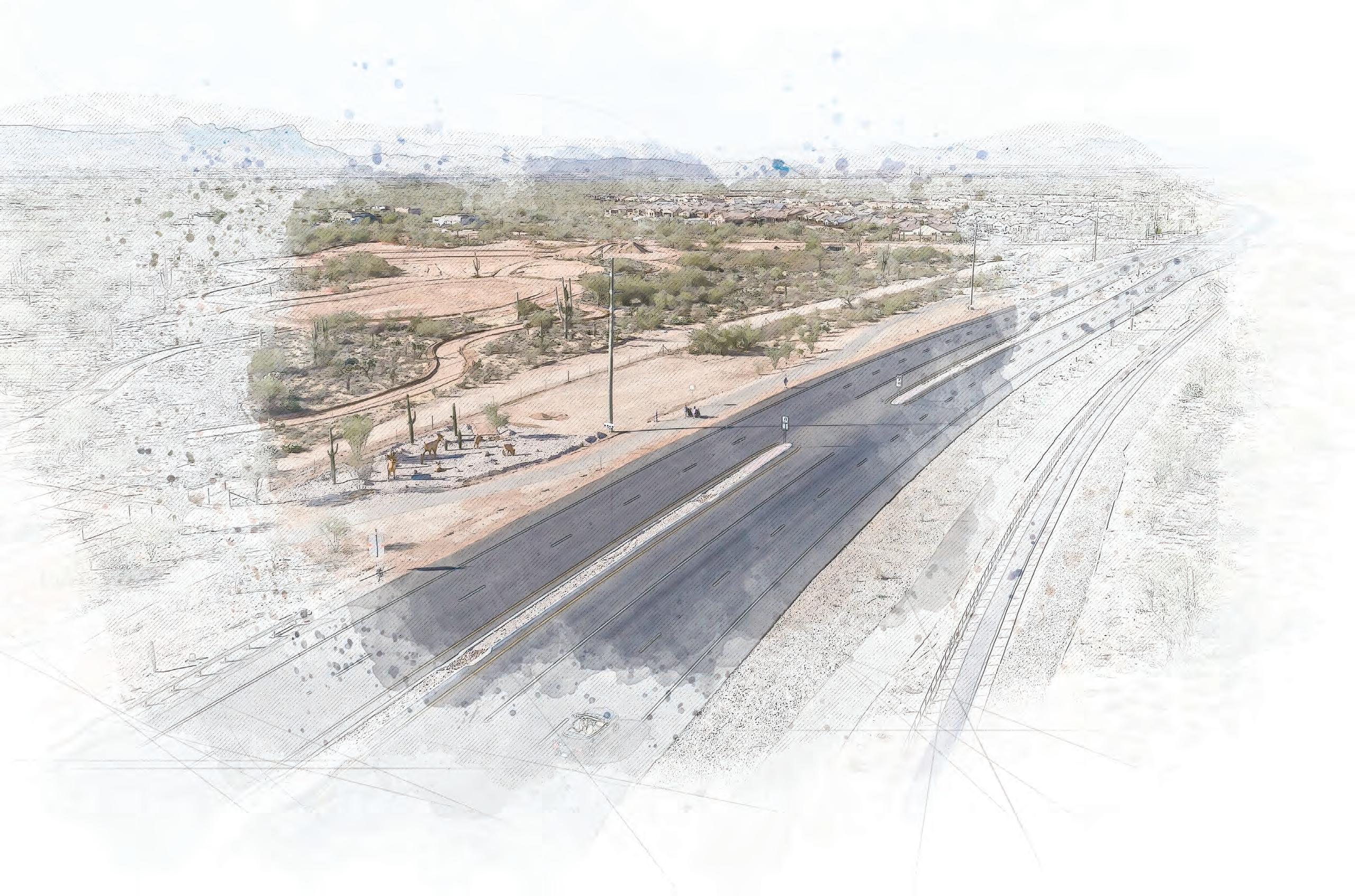
“Typically, in large road construction work, the physical labor and visible construction is completed by a private construction company that has bid on the project and won the contract with the local jurisdiction that manages it,” the RTA says on its website. “This is why you’ll often see construction trucks with the logo of a private company alongside construction work, perhaps even more often than you see trucks with the logo of the city, town or county during the construction project.
The private company builds the road to meet the jurisdiction and state standards, using RTA funds.”
An example cited by the RTA is the Tangerine Road project from Interstate 10 to La Cañada Road. It was a 10-mile-long project that crossed the boundaries of the Town of Marana, Pima County and the Town of Oro Valley. The Town of Marana was the lead agency on the project and was supported by the other two agencies.
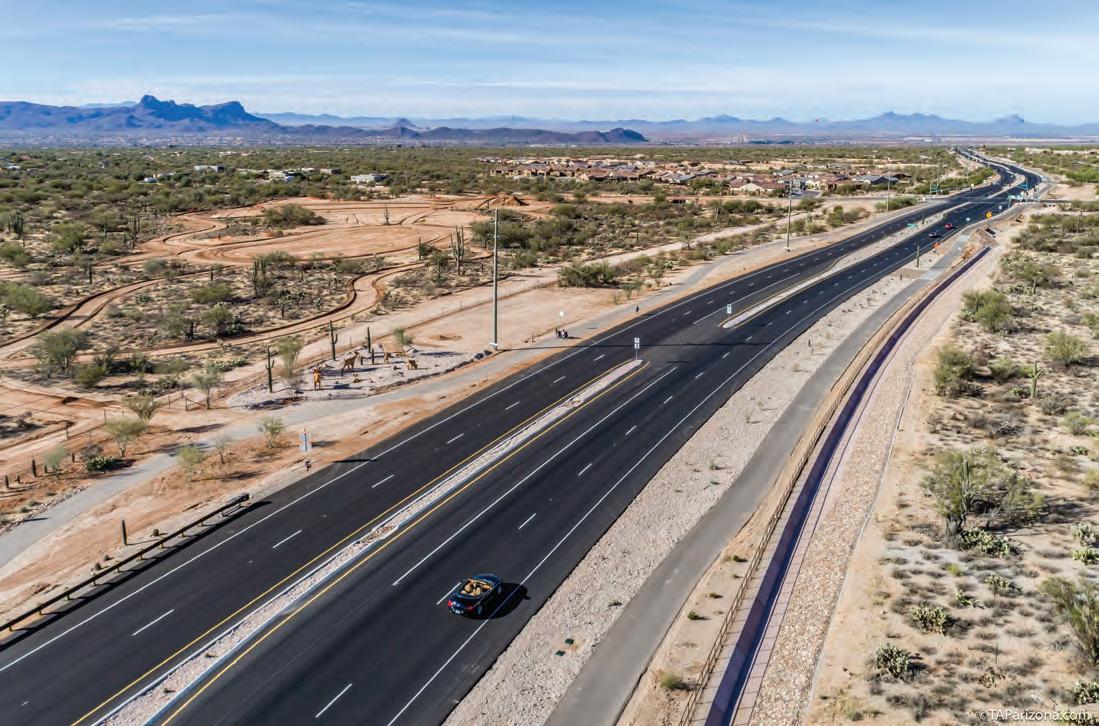
Two signature projects of the RTA were the 3.9-mile Sun Link streetcar which used RTA, federal and local funds, and the Chuck Huckelberry Loop. The Loop is 137 miles of the 300 miles of new bike and pedestrian paths that have been funded through the RTA. There are plans for 250 more miles.
Two of the more visible and recently completed projects that used RTA funds were the widening of Broadway, the so-called “Sunshine Mile,” and the downtown bypass – the Maclovio Barraza Parkway – that opened on Feb. 17 with a new roadway and bridge north of downtown.
142 BizTucson < < < Spring 2023 www.BizTucson.com BizMILESTONE Biz
10 PROJECTS MAKING A DIFFERENCE 4


Spring 2023 > > > BizTucson 143 www.BizTucson.com
Pima County Joint Technical Education District
The Pima County Joint Technical Education District, known as Pima JTED, has been a collaboration of business, community, government and education that took years from the time a 2007 ballot measure passed to create it, to 2020 when the Pima JTED Innovative Learning Campus was opened. It was a 2019 winner of the MPA Common Ground Award.
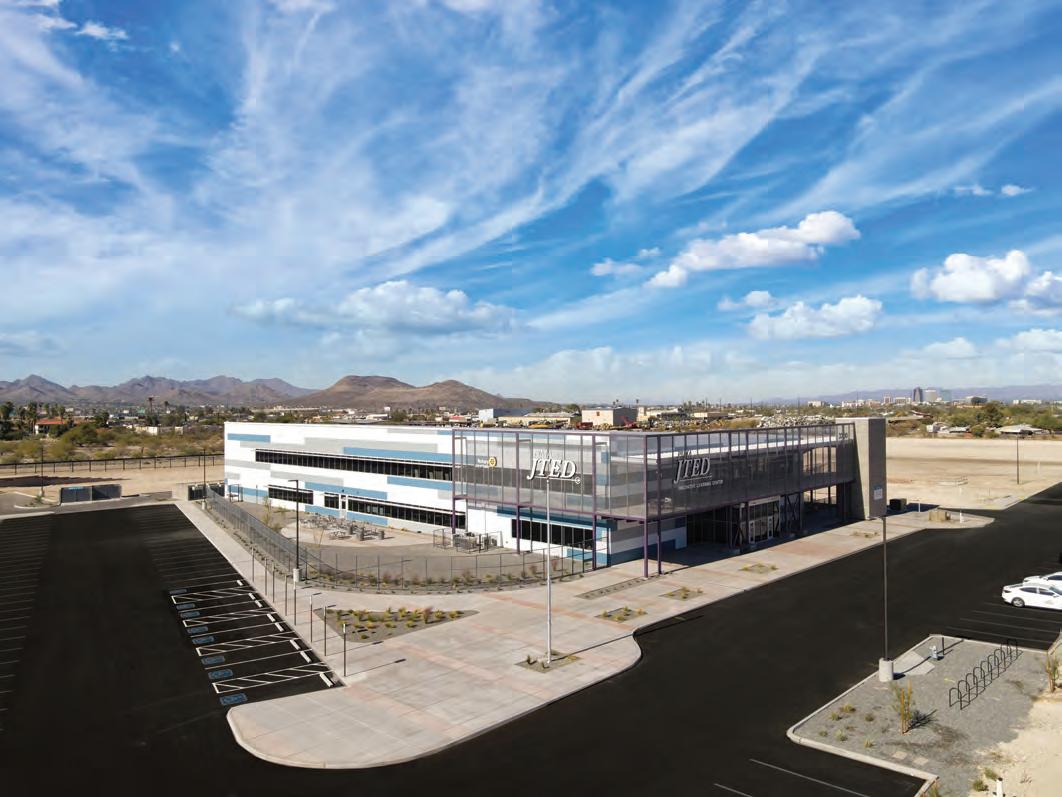
On its website, Pima JTED describes itself as a “public career and technical education district which works with business and industry and 14 member public school districts to provide premier CTE programs to approximately 22,000 sophomore-, junior- and seniorlevel high school students each year. Our award-winning programs are proven to increase student success, significantly contribute to our local economy, and afford students the chance to jumpstart their careers and do what they love in high school.”
“We change lives,” Pima JTED Superintendent and CEO Kathy Prather said in a 2021 BizTucson special report on JTED. “We open up a new world of possibility and at the same time, we are able to serve the economic development needs of our community. Our
young people leave us with leadership skills in addition to the technical skills to be leaders of the future.”
The mission of JTED is two-fold, to provide skills for the thousands of students who pass through the program, and to provide a workforce for the businesses who need those skills.
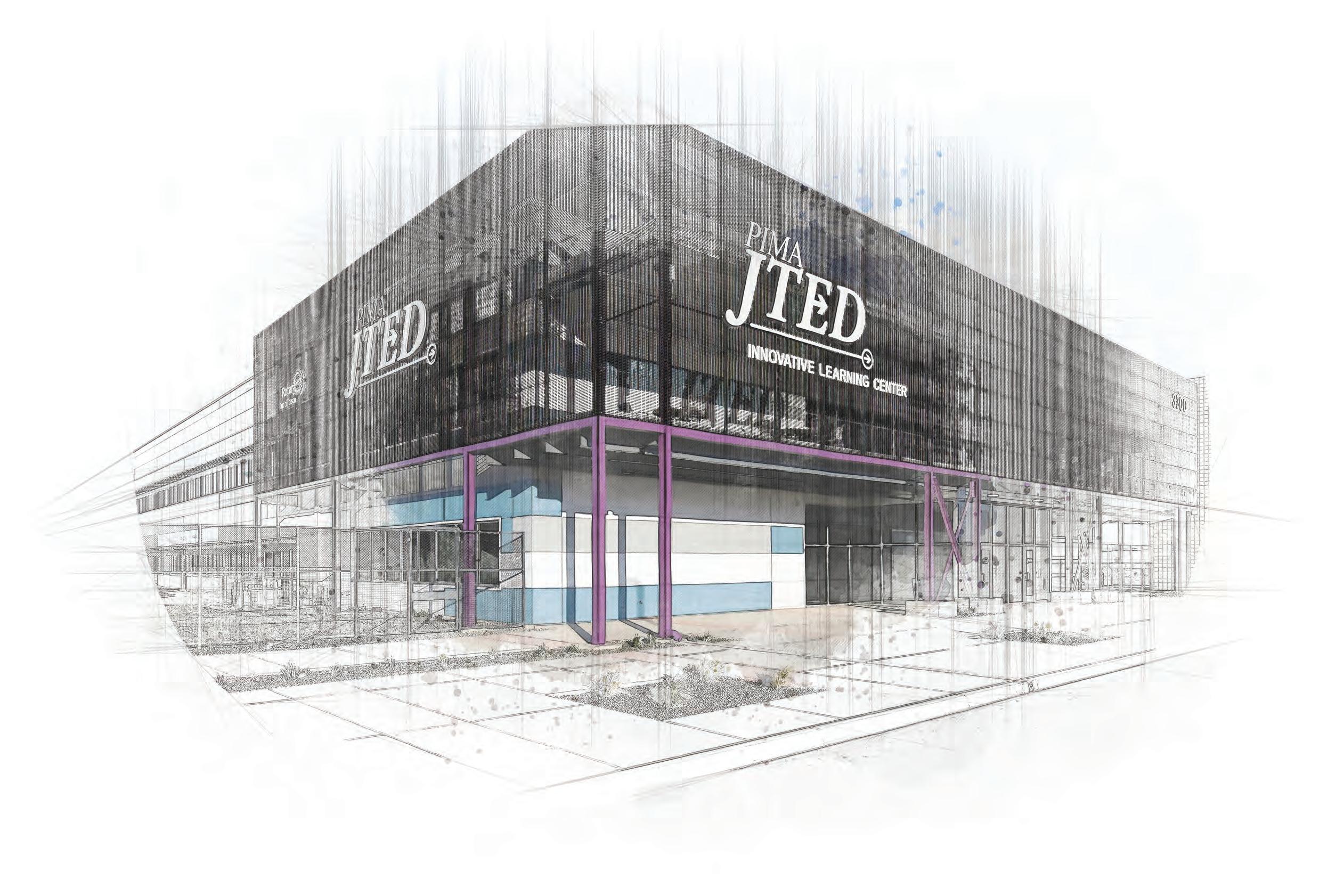
Free programs are available to high school students who can enroll online or contact counselors at designated high schools. Pima JTED also serves students who have not earned a diploma or GED and are under the age of 22.
There are more than 60 programs available in business arts and design; computers and media; health science; hospitality and human services; industrial technologies; public service; and science and engineering.
“Pima JTED is very blessed and benefits greatly from our many volunteers in the community, especially our governing board members,” Prather said. “Each of them in their own way engages and provides guidance, advocating and helping us to connect to others in the community as well as sharing their vast knowledge and expertise from their respective fields.”
144 BizTucson < < < Spring 2023 www.BizTucson.com BizMILESTONE Biz
10 PROJECTS MAKING A DIFFERENCE 5
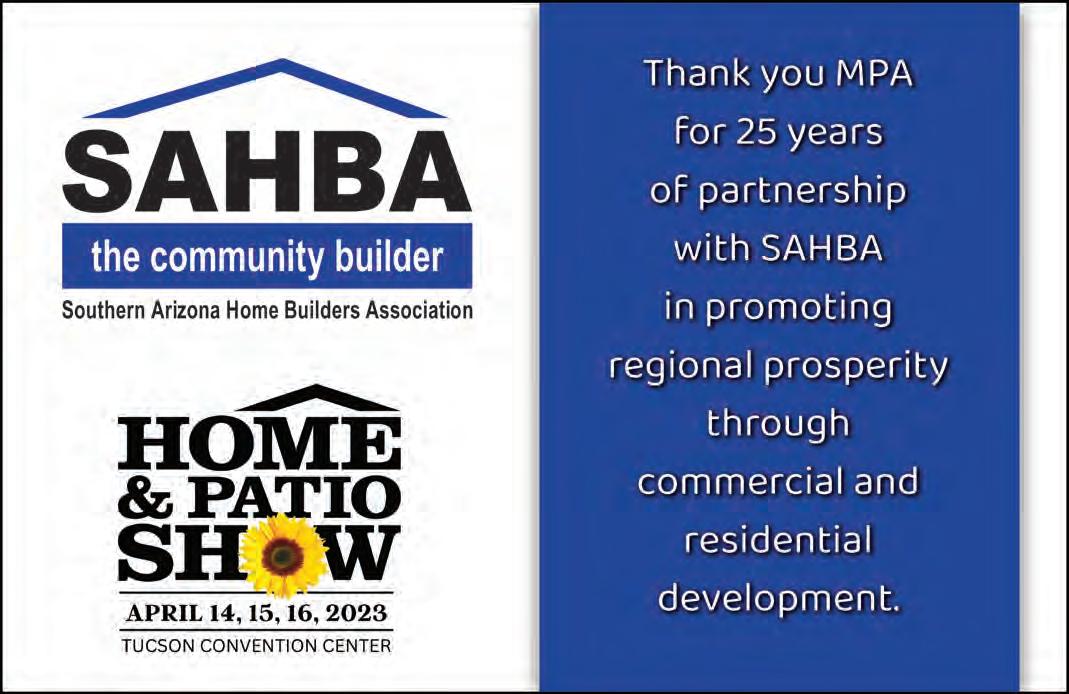
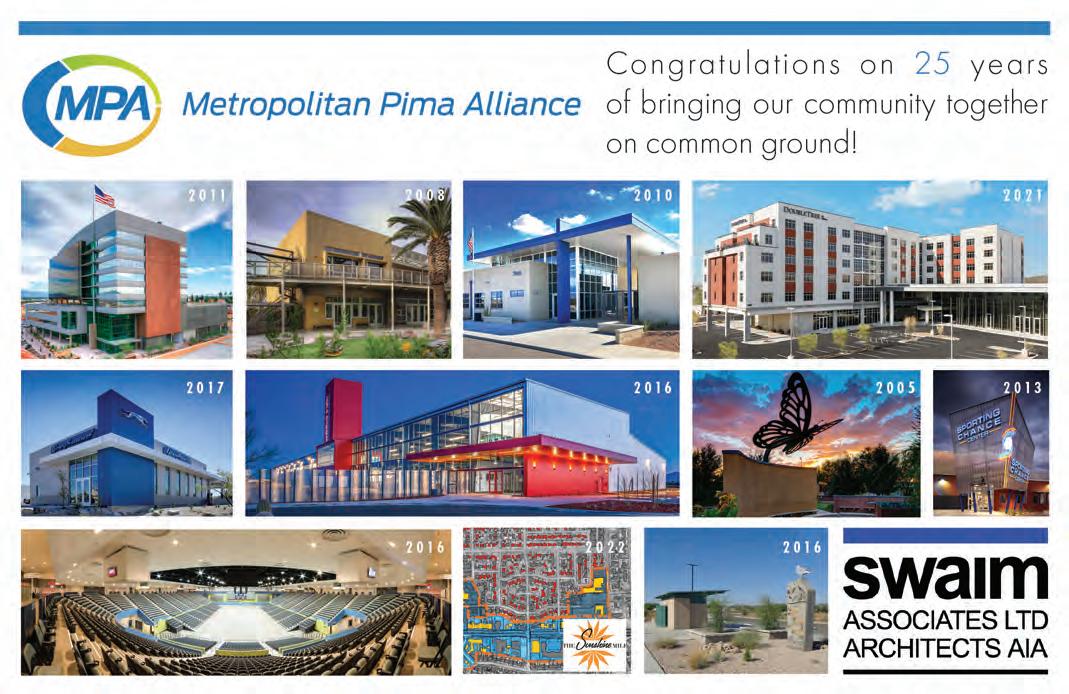
Spring 2023 > > > BizTucson 145 www.BizTucson.com
Rio Nuevo Tax Increment Financing District
When the mission is to revitalize a community’s listless downtown, a spirit of collaboration has to be ingrained into every project that comes along.
Rio Nuevo, Tucson’s tax increment financing district – or TIF – was established by the Arizona Legislature to direct state tax dollars into a fund to support downtown revitalization. In addition to the dollars, Rio Nuevo has served as a collaborator and helped bring together the various interests needed to complete the projects that have turned downtown into a vibrant and attractive place to visit and live.
Multiple downtown projects have won MPA Common Ground Awards with the AC Tucson Marriott at East Broadway and Fifth Avenue being one of the first and most visible projects that injected life into the downtown area.
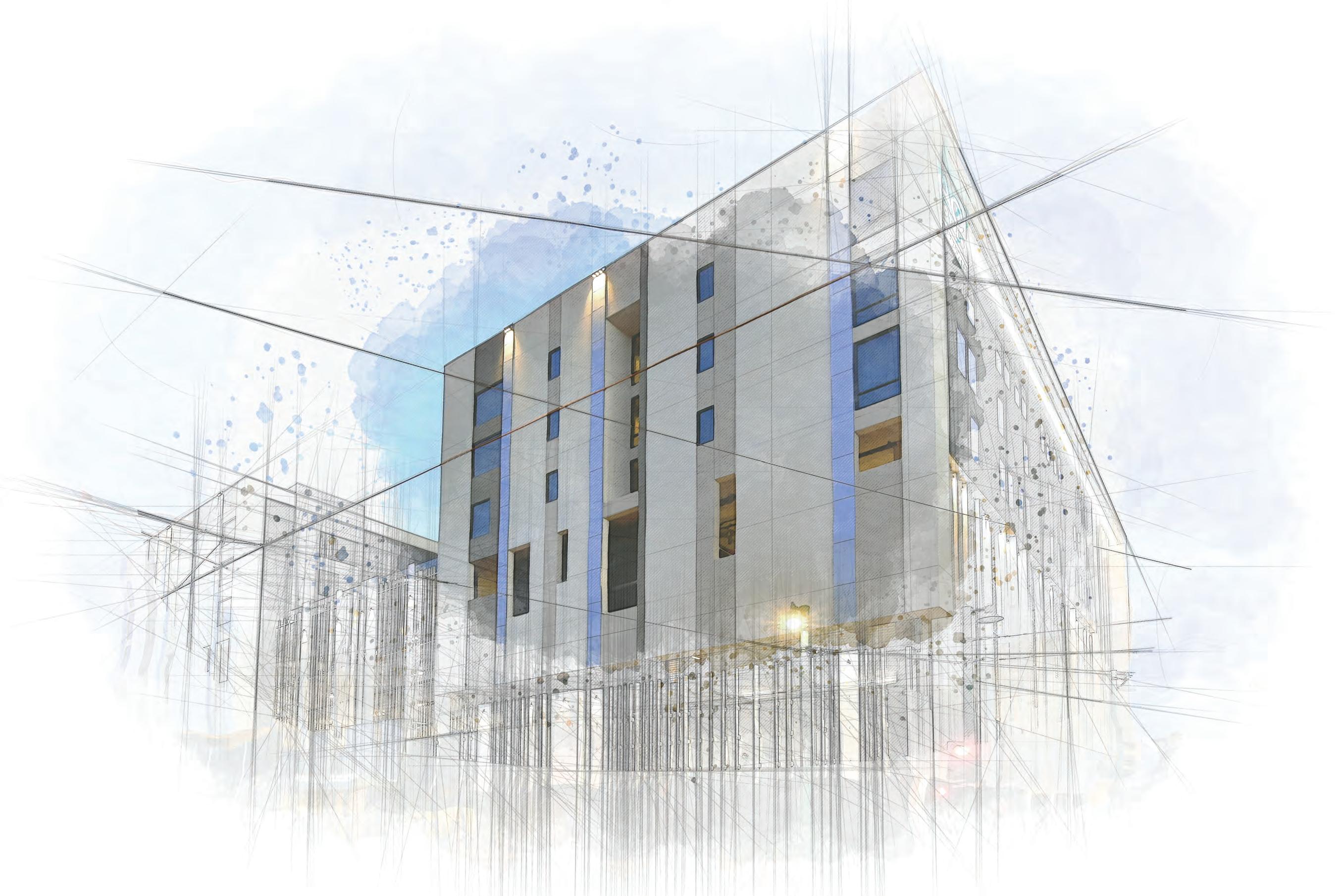
The Marriott was the first brand-name hotel to be built downtown in 40 years when it was completed in 2017. It was a winner of a 2015 Common Ground Award which listed the City of Tucson, U.S. Department of Housing and Urban Development, 5 North Fifth Hotels, Swaim Associates Architects, Cypress Civ-
il Development, FORS Architecture & Interiors, Lloyd Construction Company and Visit Tucson as collaborators.
The Tucson Convention Center Arena renovation was another award winner in which Rio Nuevo was listed as a collaborator with the City of Tucson, Concord General Contracting and Swaim Associates Architects.
The ongoing TCC Improvement Project was a Common Ground Award finalist in 2021. That project included remodeling the Music Hall, adding meeting rooms at the Exhibition Hall and renovating the Eckbodesigned plaza.
Those projects, among others, have continued to drive business to downtown with retail and residential projects.
“There’s more interest in Tucson’s urban core. There are more developers talking to us about public/private partnerships. We’re seeing multifamily developers. We’re seeing restauranteurs,” Fletcher McCusker, longtime Rio Nuevo Chair, said in a recent BizTucson report on downtown.”

146 BizTucson < < < Spring 2023 www.BizTucson.com BizMILESTONE Biz
10 PROJECTS MAKING A DIFFERENCE 6
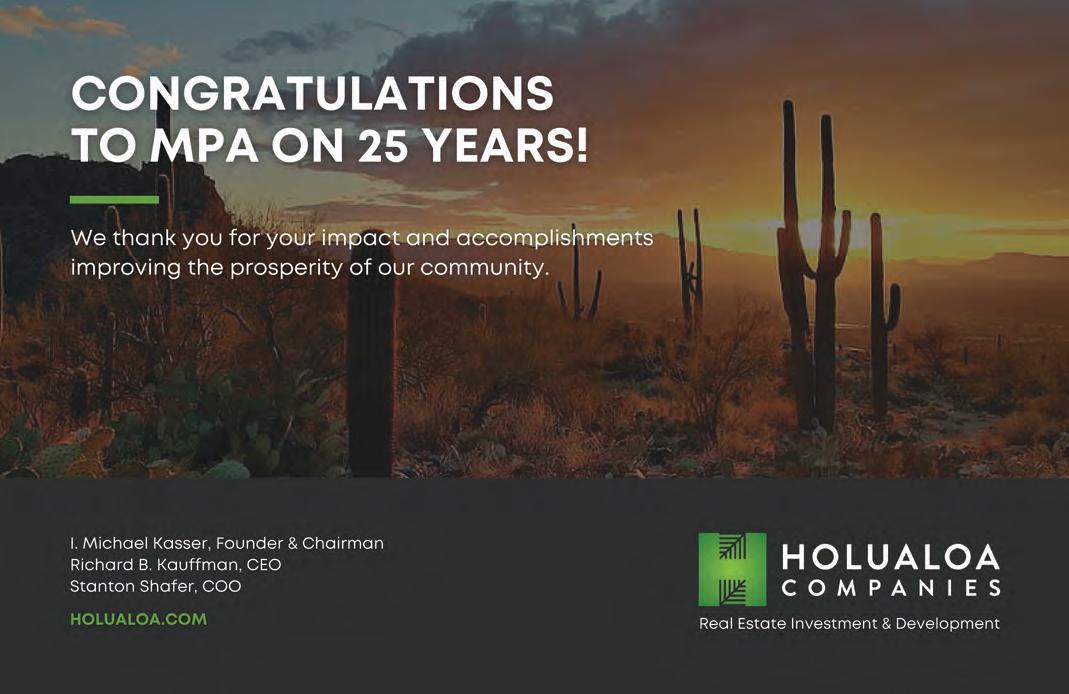

Spring 2023 > > > BizTucson 147 www.BizTucson.com
Town of Marana
Marana Heritage River Park
The Marana Heritage River Park was a carefully planned, publicly funded project to be a centerpiece of the town’s parks and recreation offerings.


Completed in 2015, the park was developed with input from public- and private-sector interests including the Marana Chamber of Commerce, Marana Heritage Conservancy, MHC Health Centers, Town of Marana Western Heritage Committee, Forest City Southwest, Gladden Farms Community Association and The Aspen Group. The Drachman Institute at the University of Arizona College of Architecture was involved in developing the design concepts.
Input also came in from an online community survey which indicated that hiking and biking trails were the most desired options. The public wanted a splash pad for kids. There also was input that the park would be ideal for farmers markets, possibly some restaurants as well as performance venues and a fitness facility.
The goals for the park as stated in the Master Concept Site Plan were: To establish the park as a showcase of Marana’s culture, heritage, and history; To establish the park as a financially viable operation within the
town; To promote the park as an economic development activity center within the town.
“The Marana Heritage River Park was developed to present Marana’s rich pre-historic and agricultural history,” the Town of Marana said in its nomination form for its Common Ground Award. “This location allows the Town of Marana to offer a variety of programs and events in a unique, outdoor setting.”
A number of existing structures and facilities on the site at 12375 N. Heritage River Park Drive, were adapted as part of the park. The park has easy access to the Santa Cruz River Shared Use Path and access to the Juan Bautista De Anza National Historic Trail.
The park now hosts the Town of Marana’s Fall Festival the second weekend of October which draws more than 7,000 people and features carnival rides, live entertainment, games, food trucks, a mutton busting competition for kids, and the Sunflower Garden. It also has been a venue for large and small events and has hosted numerous weddings for residents of Marana and surrounding areas.
148 BizTucson < < < Spring 2023 www.BizTucson.com BizMILESTONE Biz
10 PROJECTS MAKING A DIFFERENCE 7


Spring 2023 > > > BizTucson 149 www.BizTucson.com
Town of Oro Valley Innovation Park

Innovation Park in Oro Valley is a collaboration of government, real estate development and the biomedical industry to establish a base for the highly valued industry known for high salaries and a professional workforce.
Innovation Park was a 2011 winner of a Common Ground Award.
The original major employers at the park were Ventana Medical Systems, now known as Roche Tissue Diagnostics, Sanofi-Aventis, now known as Icagen, and the Oro Valley Hospital operated by Northwest Healthcare. Venture West is the developer.
“These companies have created a distinct environment as a leading center for big pharma,” said the project’s Common Ground Award nomination. “The park is a unique project with outstanding views of the Catalina Mountains and serves as a premier location for R&D companies looking for the highest in corporate image and presence.”
The development was 200 acres when it was awarded by MPA in 2011 and is now 535 acres with additional tenants including an aerospace industry tenant, Meggitt/Securaplane, and the UArizona Center for Innovation.
“There is strong collaboration … to help insure a physically and economically attractive environment for a world class location and promoting why these business giants are already there,” the nomination said.
“The increased visibility afforded though opening our R&D center in Innovation Park Oro Valley contributes to Sanofi’s transformation from a largely unknown local entity to community leader,” said Richard Austin, senior planning and resource manager at Sanofi-Aventis at the time, now the CEO of the startup Reglagene.
“Sharing an address with Ventana and the Oro Valley Hospital builds critical mass that will encourage other life sciences companies to locate at Innovation Park.

“Our first-class research facilities enable us to build on our record of value creation for our internal and external partners. Achieving LEEDS Gold status for environmentally sound construction and operation is icing on the cake.”
Prospective tenants can purchase land in the development or build to suit for purchase or lease. The Town of Oro Valley has approved a land-use code to allow for retail, healthcare, manufacturing and research and development at the park.
150 BizTucson < < < Spring 2023 www.BizTucson.com BizMILESTONE Biz
10 PROJECTS MAKING A DIFFERENCE 8

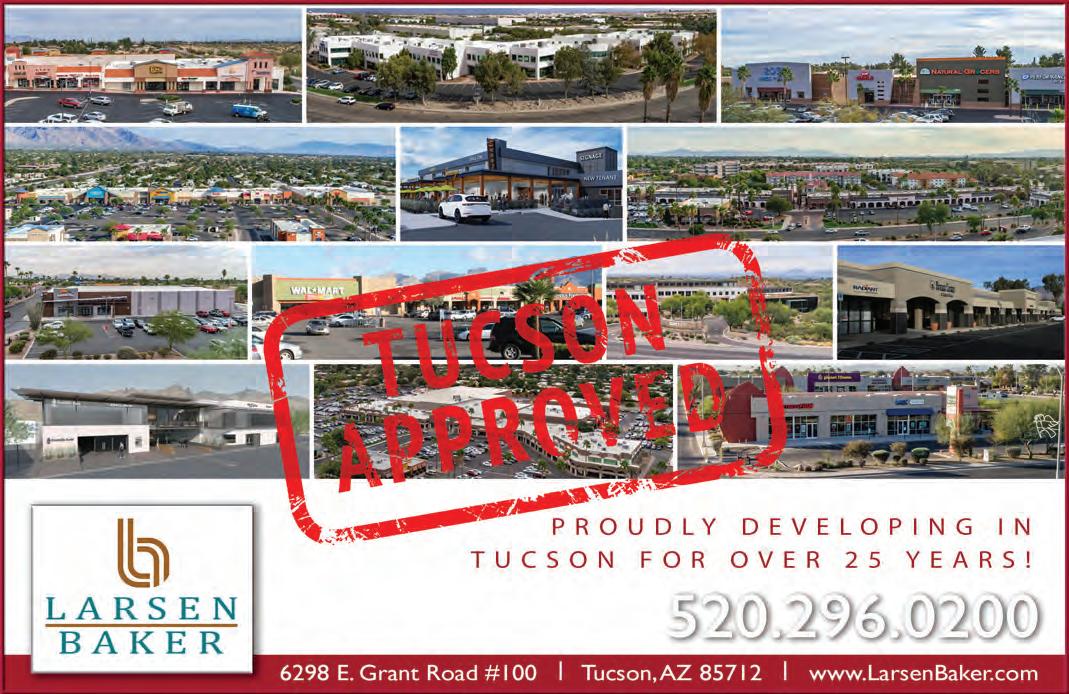
Spring 2023 > > > BizTucson 151 www.BizTucson.com
Town of Sahuarita Rancho Sahuarita
After nearly 23 years since breaking ground, Rancho Sahuarita still stands as an example of what collaboration among multiple private and public entities can do to transform a community.
Rancho Sahuarita was a 2014 Common Ground Awards Project of the Decade for the Town of Sahuarita. More than 18,000 residents live in close to 6,000 homes in the master-planned community that came together with stakeholders from the Town of Sahuarita, Sahuarita Unified School District, Rural Metro Fire, Cox Communications, and construction, engineering, design and builder groups. At the time of the award, about 60% of the town’s population lived in Rancho Sahuarita.
“We envisioned Rancho Sahuarita as a place where residents could have more time to enjoy what’s really important in life – like family, friends and fun,” said the late Bob Sharpe who began development on 3,000 acres of land in 2000 and closed on the first home sale in 2002. “It’s all about offering a lifestyle that makes people’s lives easier and more enjoyable.”


Besides building houses and the accompanying ame-
nities, Rancho Sahuarita has built eight schools in the area.
“Great schools make great communities, and we are proud to be a longtime partner and supporter of the school district,” said Sharpe. At the time of the award, Rancho Sahuarita had donated almost 75 acres of land for SUSD schools. Rancho Sahuarita has also partnered with the school district on a number of programs and initiatives, including the Sahuarita WINS community engagement effort.
The zoning specific to Rancho Sahuarita was approved in 1995 shortly after the Town of Sahuarita was incor porated. The formation of the Sahuarita Water Company and the approval of the Sahuarita Wastewater facility followed several years later.
Retail, commercial, health and wellness, government and non-profit services have expanded in the area through the development of the Rancho Sahuarita Marketplace and the Sahuarita Town Center. Five major national homebuilders remain active at Rancho Sahuarita. Sharpe’s son, Jeremy, is now the president of Sharpe & Associates, the developer.
152 BizTucson < < < Spring 2023 www.BizTucson.com BizMILESTONE Biz
10 PROJECTS MAKING A DIFFERENCE 9


Spring 2023 > > > BizTucson 153 www.BizTucson.com
University of Arizona, Tech Parks Arizona, UA Tech Park & UA Tech Park at The Bridges
Tech Parks Arizona, a unit of The University of Arizona, is a multi-year winner of the Common Ground Awards for both the UA Tech Park and UA Tech Park at The Bridges, which brings together industry, government and academia to advance business.


Tech Parks Arizona has brought together various stakeholders to develop purpose-built environments to support businesses and facilitate university-industry interactions for nearly three decades. Over the course of 29 years, Tech Parks Arizona has worked across campus with different UArizona Colleges and departments, and also with businesses, utility providers, federal agencies, contractors, vendors, commercial brokers and land developers. Tech Parks Arizona has reimagined the traditional workspace through the perspective of the user and designed it to be very flexible with the ability to rapidly evolve based on insight gained from the parks’ extensive collaborators network.
Tech Parks Arizona creates environments that support and promote research and development, technology innovation and advancement, and business development and attraction. The UA Tech Park is an economic powerhouse contributing $2 billion annually to the local economy. It is a major employment with over 100 companies and nearly 6,000 knowledge workers. Covering 1,267 acres, the UA Tech Park at Rita Road is a destination for technology companies from startups to tech giants which significantly contribute to Tucson’s regional economy.
UA Tech Park at The Bridges is a 65-acre development in central Tucson with a long-term plan for 1.2 million square feet of office and laboratory space and room for about 5,000 employees. It is part of the 350acre, mixed-use development just north of Interstate 10 west of Kino Parkway known as “The Bridges”.
The first building on the site, The Refinery, opened in 2022 with 50% of the building committed to UArizona departments including Tech Launch Arizona, UArizona Applied Research Corporation, and UA Online, Distance and Continuing Education. Earlier this year, the first corporate tenant was attracted, Raytheon Missiles & Defense, which is leasing 14,000 square feet of office space at the four-story building. The Refinery is a 120,000-square-foot building whose name emphasizes its proximity to the talent and sharp minds that can be mined from the University of Arizona. This unique opportunity allows leading-edge technology companies to recruit the best and brightest, which in turn provides graduates with engaging employment and students with hands-on internships.
“We are excited to partner with the University of Arizona and the Tech Parks team on what we expect will be the first of many buildings within The Bridges,” said Matt Jensen, a partner and project manager with The Boyer Company, which built The Refinery. “This project has been a long time in the making and is the direct result of strong leadership within the university.”
154 BizTucson < < < Spring 2023 www.BizTucson.com BizMILESTONE Biz
10 PROJECTS MAKING A DIFFERENCE 10


Spring 2023 > > > BizTucson 155 www.BizTucson.com

NEW TO MARKET
BizCONSTRUCTION
Project: Sun City Oro Valley Activity Center Renovation


Location: 1495 E. Rancho Vistoso Blvd.
Owner: Sun City Oro Valley Community Association
Contractor: W.E. O’Neil Construction
Architect: Highton Company
Completion Date: January 2023
Construction Cost: N/A
Project Description: Additions and renovations were made to the activity center, including new entry and dining space, meeting room, auditorium and community space improvements.
Project: Omni Tucson National Resort Main Building Renovations

Location: 2727 W. Club Dr.
Owner: TNR&S Acquisitions
Contractor: Concord General Contracting
Architect: WATG
Completion Date: December 2022
Construction Cost: $4.2 million
Project Description: Renovations have been completed on 14,593 square feet of interior space including the lobby, a bar, restaurant, spa and a grab-and-go.
Project: La Posada at Pusch Ridge
Location: 10930 N. First Ave., Oro Valley
Owner: La Posada at Pusch Ridge
Contractor: Sundt Construction
Architect: Gensler
Completion Date: April 2025
Construction Cost: $138 million
Project Description: Description: Phase one of the CCRC senior living community will be comprised of 169 independent living units on an 80-acre site.
Spring 2023 > > > BizTucson 157 www.BizTucson.com
NEW TO MARKET
Project: The Eddy Hotel Tucson
Location: 4626 N. Campbell Ave.
Owner: Capri Hotel Management
Contractor: W.E. O’Neil Construction
Architect: JRA Architecture and Planning
Completion Date: February 2023
Construction Cost: N/A
Project Description: The boutique hotel features 106 rooms and an in-house restaurant/bar and is part of the exclusive Tapestry Collection by Hilton.

Project: Jim Click Hyundai Auto Mall
Location: 700 W. Auto Mall Dr.
Owner: Tuttle Click Automotive Group
Contractor: Concord General Contracting
Architect: John Mahoney Architect
Completion Date: February 2024
Construction Cost: $7.2 million
Project Description: The existing dealership will be completely demolished and replaced with a new standard Hyundai dealership.

Project: Residences
Location: Tucson
Owner: Emerge Center Against Domestic Abuse
Contractor: Tofel Dent Construction
Architect: Poster Mirto McDonald
Completion Date: April 2024
Construction Cost: $7.5 million
Project Description: This project will be a 25-unit, non-congregate emergency shelter for people fleeing domestic violence.

158 BizTucson < < < Spring 2023 www.BizTucson.com


Spring 2023 > > > BizTucson 159 www.BizTucson.com


160 BizTucson < < < Spring 2023 www.BizTucson.com
2023 Lifetime Achievement Award
2023 GOOD SCOUT AWARDS
The Boy Scouts of America Catalina Council will honor three community leaders this spring for their contributions to Scouting.
The recipients of the annual Good Scout Awards are Christie Lee, who will receive the Distinguished Citizen Award; Fred Knapp, who will be given the Lifetime Achievement Award; and Barbi Reuter, who is honored with the Good Scout Award.
Lee is president and CEO of TMM Family Services Inc., Knapp is VP of CORE Construction and Reuter is CEO of PICOR |Cushman & Wakefield and was one of BizTucson’s inaugural Women Leading the Region.
Honoring Fred Knapp
By Tom Leyde
Fred Knapp, VP of CORE Construction Services of Arizona, has always valued Scouting.
“I think it’s a great organization,” said Knapp, a former Boy Scout. “It teaches kids to collaborate with other individuals. ... It’s important to have true relationships. ... It teaches kids ... how to help other people, how to be a part of the community,” he said.
Knapp is the recipient of the Lifetime Achievement Award, presented by the Boy Scouts of America Catalina Council. He was a Scout when he was in junior high school, but entered the work force early and was unable to continue his membership.
At 14, he began working in construction with his father in the family’s construction company, Knapp Construction Company. He wanted to become a chemical engineer, but he needed money to attend college. He went to night school while working and earned a realtor’s license and a contractor’s license, but did not finish college.
In 1978, Knapp took over the family business and began working in the commercial division of the firm. He became company president in 1979.
The construction business took off at that time. “I had a great list of clients and never really had any problems getting work,” Knapp said.
In 2008, CORE Construction Services approached Knapp to buy his company. He agreed and CORE hired the entire staff, making Knapp the VP of its Tucson operations. He has been with the company for 15 years.
CORE is headquartered in Dallas and has an office in Phoenix and a satellite office in Tucson. Knapp heads marketing and business development in Tucson, as well as client services. He also leads the company’s philanthropic arm.

In that capacity, he and CORE have supported the Santa Catalina Council and its annual fund-raising luncheon.
The awards honor Tucson leaders who have demonstrated the best in Scouting ideals, leadership and service in their field of work. This year marks the 24th anniversary of the awards, sponsored by the Catalina Council in its mission to build the next generation of leadership.
The Catalina Council was founded in 1919 and is led by approximately 1,000 volunteers. More than 2,000 Tucson-area youth participate in Scouting.
24TH ANNUAL GOOD SCOUTS AWARDS LUNCHEON
Thursday, April 20, 2023
Networking and check-in
11:00AM
Lunch & program
12:00PM – 1:30PM
Tucson Convention Center
Copper Ballroom
260 S. Church Ave.
For more info: Tracey Smalling
Tracey.Smalling@scouting.org
www.catalinacouncil.org
Spring 2023 > > > BizTucson 161 www.BizTucson.com
Biz
BizHONORS
2023 Good Scout Award
Honoring Barbi Reuter
By Tom Leyde
Barbi Reuter is the recipient of the Good Scout Award presented by the Boy Scouts of America Santa Catalina Council.
Reuter, CEO of Cushman & Wakefield | PICOR, a Tucson-based global real estate company, said she was “surprised and honored” by the award.
“It was unexpected,” she said. “The company has been a multi-year supporter of the (awards) event. It’s a real privilege to be among them (the honorees).”
Reuter was 12 when she moved to Tucson from Colorado Springs, Colo. with her mother after her parents’ divorce. She attended the University of Arizona but paused her studies to join Cushman & Wakefield | PICOR when it was founded in 1985. Reuter finished her college studies with a bachelor’s degree in business management from the
University of Phoenix.
After helping to grow the company’s property management division, she became founding principal in 1992. Following three years as COO, she was named president in 2017, then CEO in 2020.
Reuter is a past chair of the Tucson Metro Chamber and Greater Tucson Leadership’s Woman of the Year in 2019. In 2021, BizTucson named her among its inaugural list of “Women Leading the Region.” A founding member of Commercial Real Estate Women, she was elected to the association’s global board of directors and served as its president in 2022.
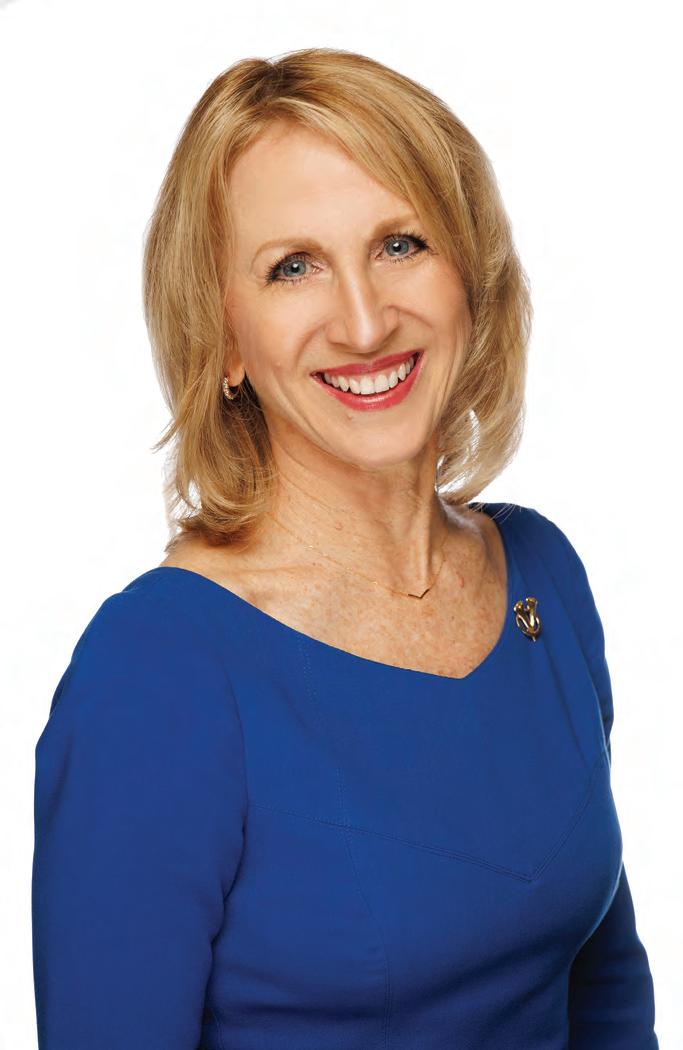
Cushman & Wakefield | PICOR, an employee-owned company, specializes in commercial real estate. It helps businesses and investors with real estate leads and retail offices in Southern
Arizona and Sonora, Mexico. In 2022, it was named among the nation’s 100 highest growth companies, ranking 75th for revenue growth and job creation.
“Our business succeeds when the community succeeds,” Reuter said. “We focus on economic development and involvement in civic projects.” The company’s charitable division, Reuter said, has given $1.4 million to youth charities since 1994.
She is a member of the Tucson Symphony Orchestra Chorus and thrives on making a difference.
She and her husband Dave have a blended family of four children. One lives at home, while the others are spread from Houston to Northern California.
162 BizTucson < < < Spring 2023 www.BizTucson.com
Biz Biz
HONORS
Honoring Christie Lee
By Tom Leyde
In May 2022, Christie Lee took over as president and CEO of Tucson Methodist Ministries Family Services Inc. She feels that each step in her work and family life prepared her for the job.
TMM Family Services Inc. has been serving Southern Arizona’s most vulnerable and at-risk populations for more than 40 years. It provides affordable housing and support services to veterans, seniors and single parent households that meet low-income guidelines and are at risk of becoming homeless.
The organization encourages independence and helps its clients rebuild their lives, providing a path out of poverty.
As a divorced mom of three young children, Lee faced her own life difficulties and overcame them, and she understands what TMM’s clients are going through. “I was in their shoes,”
she said. But more on that later.
Lee has worked for Fidelity National Title, Bank of the West, Commerce Bank of Arizona and the Tucson Metro Chamber. She studied elementary education at the University of Arizona for four years and played the clarinet in the UArizona Marching Band.

From 2012 to 2020, Lee chaired the Boy Scouts of America Catalina Council Good Scouts Awards Luncheon, the council’s annual fundraising event. As a result, she was chosen to receive Distinguished Citizen Award presented by the council.
“I’m very honored that (the council) is appreciative of my work,” Lee said.
Her grandfather was on the original commission to the council. “It’s just been a great way to carry on his legacy and carrying on with something that was near and dear to his heart,”
Lee said.
Lee has three children–all of whom have faced significant traumas and challenges. Her daughter Stacy, now 31, survived a car accident after being declared dead at the scene. Her oldest son, Brian, was born with spina bifida and hydrocephalus. Now 36, he is in private care. Her youngest son, Jason, who is 29, broke many bones growing up and suffered a concussion playing high school football.
“Living in chaos mode as a single mom prepared me for this (her current position),” Lee said.
She is committed to building relationships and living one day at a time. Her life philosophy is summed up as, “All the little moments–those are the ones that count.”
Spring 2023 > > > BizTucson 163 www.BizTucson.com 2023 Distinguished Citizen
Biz BizHONORS
Award
31st Annual CCIM Economic Forecast
Retail, Industrial Sectors Show Promise Amid Turbulent Economy
By Tom Leyde
Economic trends have caused a lot of turbulence this year, but Tucson’s situation has a brighter side than the national outlook, according to speakers at the CCIM 31st Annual Economic Forecast.

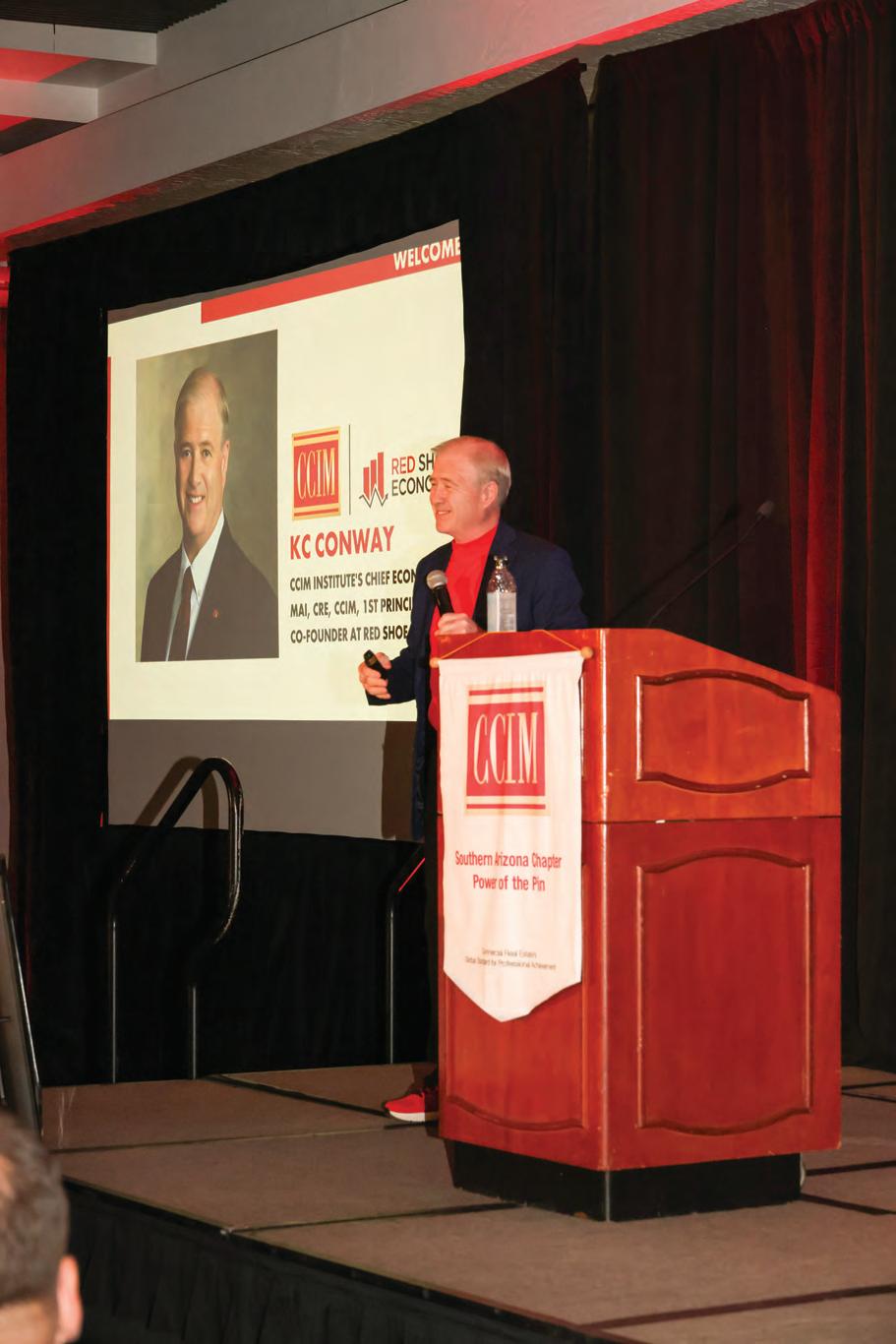
More than 400 people attended the Feb. 16 at the Tucson University Marriott–the largest turnout ever. CCIM, or Certified Commercial Investment Member, a commercial real estate investment group, invited five speakers to the event who focused on industrial real estate, multi-family housing and rentals, the retail sector and commercial real estate.
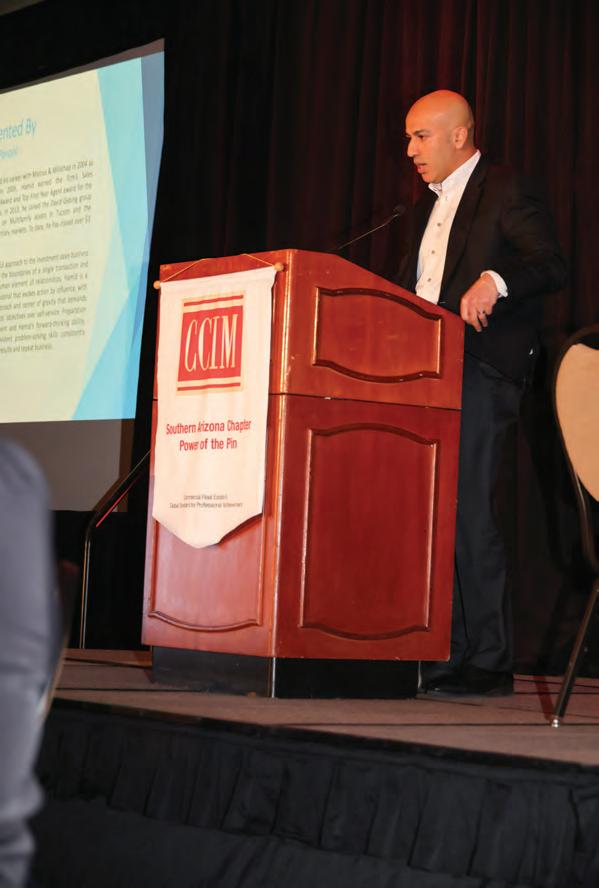


Among the positives: more new businesses opened in Tucson than closed; retail vacancy is at a 10-year low; a large new battery plant is coming; new warehouses are going up; and the current economic state is a moment in time and it will change.
That’s not to say everything is rosy, but Tucson has weathered rough times in the past and is expected to do it again.
Phil Voorhees, CBRE vice chairman, spoke about commercial real estate:
• “ We’re setting up for one of the best periods ever for retail right now,” Voorhees said. “The development pipeline is limited so we’ve got a huge tailwind just from the lack of space available. We’re more productive than ever. As long as the economy is strong and despite the FED’s (Federal Reserve) best effort to slow it down, it’s still chugging along.”
164 BizTucson < < < Spring 2023 www.BizTucson.com
Biz
PHOTOS BY BRENT G. MATHIS
REALESTATE
Jesse Blum
Hamid Panahi
KC Conway
Phil Voorhees
Nancy McClure
• Retail square footage is declining, however, it’s a good time to invest in footage because more tenants are looking for spaces than there are available. Retail didn’t die because of the COVID-19 pandemic–the increase in online sales is proof.
• Retail commercial real estate, Voorhees said, “is the cleanest dirty shirt at this point in time.” He predicted a nice two- to three-year run for retail coming up.

• “ We’re probably closer to the top of (interest) rates going up than we are at the bottom,” he said. “By the second half of the year or by the fourth quarter, you should feel some good momentum coming back into the investment businesses as more lenders come in and that big wave of capital that’s sitting there, decides it’s time to come off of the sidelines and get out there.”
Nancy McClure, First VP of CBRE, said retail would continue to be the most resilient of all real estate sectors:
• Retail absorption has been positive for the past four years. More stores opened than closed.
• High logistics and labor costs have af fected retailers’ bottom line and retail space per capita has diminished. But last year, beauty supplies, fast food and restaurants were the top three in sales.
• E-commerce is important for retailers. High performers are expected to be beverage, home improvement and medical retail goods.
• Retailers without an online presence may fail. Onlineonly retailers are looking for a physical presence other than brick and mortar and are less likely to accept returns because of logistics costs. They’re more likely to tell customers to keep the original item and send them a replacement.
• There are 10 vacant “big boxes” over 30,000 square feet available in Tucson.
• Aldi, a German-based grocery chain like Trader Joe’s, is coming to Tucson this year with multiple stores.
• Tucson added a new Sprouts Farmers Market at Irvington and 19th, a Tesla dealership on River Road and a Main Event was to open in March off I-19.
Jesse Blum, industrial and logistics broker for Cushman & Wakefield | PICOR Real Estate, addressed the industrial real estate outlook:
• “ The growth and production of manufacturing will have a profound effect on the economic development and continued success of Tucson and, certainly, the impact on Tucson’s industrial real estate market,” he said.
• A surge in demand for industrial real estate has led to an all-time low vacancy rate of 2.6%.
continued on page 166 >>>
Spring 2023 > > > BizTucson 165 www.BizTucson.com
continued from page 165

• Tucson is playing catch up in this market, with 1.8 million square feet under construction and another 1 million square feet coming. He said the greatest challenge to the Tucson market is availability.
• Demand for industrial real estate has tapered off but not to the degree expected.
• “ The demand mix is changing, and I couldn’t be happier for Tucson as an overall economy. It continues to shine and we welcome all that it brings.”
• American Bat tery Factory will bring $1.8 billion and 1,000 new jobs over the next five years.
Hamid Panahi, senior VP Investments, Institutional Property Advisors, spoke about rentals, apartments and multi-family units:
• Average rents are low but healthy in Tucson compared to Phoenix.

• The construction pipeline is good, with 3,096 units coming in the next two years.
• Migration to Arizona remains strong (more than 10,000 people are anticipated this year).
• The cost of capital has increased and developers will hold off on projects until uncertainty of construction costs diminishes.
• The multi-family sector is struggling, but Panahi thinks it will continue to do well in the near future. “I’m hoping when I’m standing here in 2024 or 2025, I’ll be yelling, ‘Apartments are back,’” he said.
Main speaker KC Conway, the mind behind research firm Red Shoe Economics, was more critical of the current economic situation:
• Conway expects more interest rate increases when the FED meets in May, June and July.
• Property returns are prime for a reset. Prices are going down. Office real estate has fallen out of the top three, but hotels are doing well, he said.
• Tucson needs to build more roads that will support new development.
• “Space enomics” is the best bet for the future, he said. “That’s an opportunity for us. The real estate of satellites and then the businesses that control all of the activity is huge, and you guys are part of that.”
166 BizTucson < < < Spring 2023 www.BizTucson.com
Biz
Biz
REALESTATE



Spring 2023 > > > BizTucson 167 www.BizTucson.com

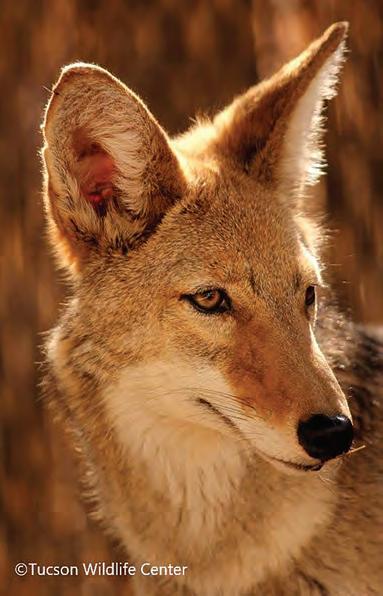
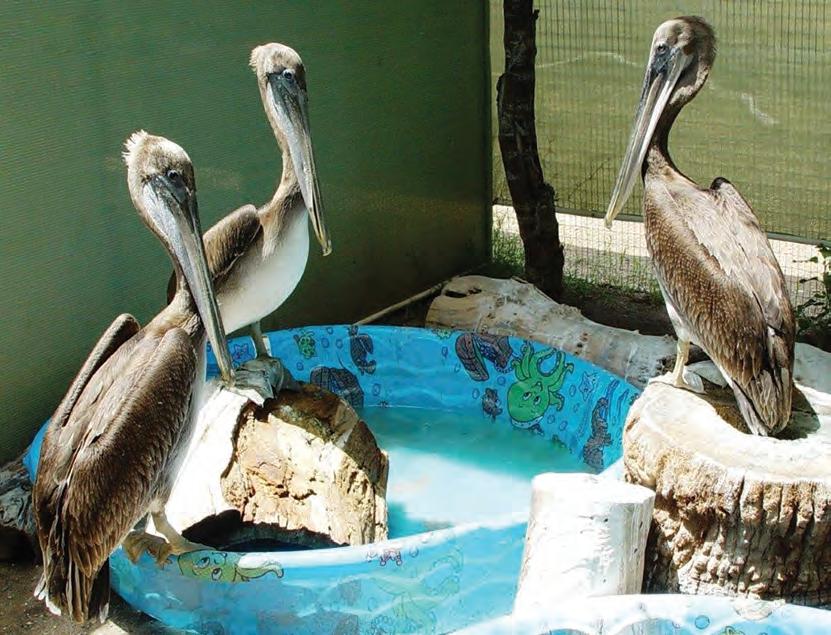


www.BizTucson.com
PHOTO BY BRENT G. MATHIS
From left –Hubert Parker Development Coordinator Tucson Wildlife Center
168 BizTucson < < < Spring 2023
Lisa Bates & Pete Lininger Owners Tucson Wildlife Center
Wildlife Rehab
Tucson Wildlife Center Marks
25 Years of Saving Injured Animals
By Dave Perry
Growing up in a wilder, less-populated Tucson, Lisa Bates rescued large, injured animals. Deer. Bobcats. Raptors.
Then her career called. Bates worked as a plant pathologist at the University of Arizona’s Environmental Research Lab.
“When I was able to retire, I wanted to keep active and do something I was passionate about,” Bates said. “This was the only inkling I had. I knew I wanted to rehabilitate wildlife.”
She and her husband, Pete Lininger, acquired 15 acres of land on far East Speedway, below the Rincons and along Tanque Verde Wash. They built a house and buildings, and started the Tucson Wildlife Center.

Now, 25 years later, Bates, her staff and volunteers have rescued, rehabilitated and returned tens of thousands of animals to the wild. It’s a rich legacy, certainly, but Bates, the executive director and a trained wildlife rehabilitator and nurse who doesn’t take a paycheck, is always in the moment.
Recently, Bates examined the X-ray of a skink on her phone, its tail accidentally fractured by a shovel blade. Could it be saved? One of the center’s seven volunteer, part-time veterinarians would make the call. Surgery would be performed at the center’s state-of-theart Sam Goldman Wildlife Hospital, the only 24/7/365 animal hospital in Southern Arizona dedicated to the care of sick, injured and orphaned wildlife.
“If it can heal, it will be released,” Bates said. If not, it will be gently euthanized.
“We can rehabilitate anything that’s injured,” she added, noting that 80% are returned to their homes. “If they’re hurting and suffering and need help, we’re there.”
This work is “never boring,” Bates said. “Every day is something new.”
Every night, too. On another recent night, center staff rushed to stabilize an abandoned, newborn javelina, its umbilical cord attached. It was a lifeor-death situation: if the newborn did not drink colostrum, that essential first mother’s milk, it would die. A herd was located, and the newborn was placed nearby.
“You don’t know if it really belongs to that herd,” said wildlife care specialist Kathy Carter McLin, who worked the rescue with supervisor Linda Smith and others. “We set it down, and they all came running, nine of them. The next thing, it was suckling. They slowly drifted off, and the baby went with them. Not a lot of people get to see that. We hugged, we high-fived, we were so excited.”
“There’s nothing better than the joy of a good, safe, happy release, back to his territory, back to their family,” Bates said.
From the start of 2022 through Oct. 17, the center rescued nearly 4,000 animals, among them hundreds of quail, doves and cottontails, along with bobcats, owls, javelina, bats, mice, skunks, ravens, raptors and more. There were 4,393 rescues in 2021 and 5,304 in 2020. Over time the center’s numbers have increased, in part because so
many “backyard rehabilitators” are now closed. Nearly 20,000 phone calls a year come from across Southern Arizona.
The non-profit center, Arizona’s only rescue accredited by the Global Federation of Animal Sanctuaries, spends nearly $900,000 a year. It has 17 employees and dozens of volunteers. “We have a very capable staff,” Bates said. All funding comes from donations, grants and fund-raisers, such as the “Born to be Wild” benefit on Mar. 12 at the Westin La Paloma Resort & Spa.
“We know the Tucson community to be so involved and caring for our wildlife,” Bates said. “It’s really heartwarming to see that.” Her friend and artist Diana Madaras has helped greatly to raise awareness, and money. “You get enough of the negative in this life and world. We get to see the positive.”
“We couldn’t do it without” dozens of volunteers, said development coordinator Hubert Parker. More would be welcomed.
“We feel like we’re giving back to the wildlife community,” Parker said. “Without us, the animals would die. We’re not saving kids with cancer, but what we do is a reflection on the heart of this community. We feel like what we do is bigger than us.”
“I’m living out my passion, and having a reason to get up in the morning,” Bates said. Decades ago, “I knew I wanted to rehabilitate wildlife. That was just a kid’s dream. Somehow it played out, many years later.”
Spring 2023 > > > BizTucson 169 www.BizTucson.com
BizWILDLIFE
Biz
PHOTOS COURTESY TUCSON WILDLIFE CENTER
Don Luria Culinary Entrepreneur, Philanthropist and Tucson Original
 By Loni Nannini
By Loni Nannini
Don Luria was a creative, an entrepreneur, a lifelong learner and a philanthropist.
He was also the personification of one of his proudest achievements: A true “Tucson Original,” much like each unique local restaurant that carries the title synonymous with one-of-a-kind culinary standouts.
“Don came to Tucson in 1981 and he just loved it. He immersed himself in everything he could: The food world, the arts, the leadership, the business community, the philanthropy. . .he really adopted Tucson as his hometown,” said Donna Nordin, who met Luria in 1984.
At the time, Luria had traded a 20plus year career in business, government, research and urban development on the East Coast for a new adventure. An avid cook, he purchased the Tasting Spoon, a cooking school, and a gourmet take-out company, Gourmet to Go. He convinced Nordin, one of numerous renowned chefs to visit the Tasting Spoon, to join him in his Tucson endeavors. They became partners in business and life.
In 1986, they opened the storied Café Terra Cotta, which became an icon of Southwestern cuisine for more than 20 years.
Together, they helped pioneer a new era in regional cuisine, said Robert Leopardi, key account manager for Maverick Beverage Arizona. Leopardi, a long-time personal friend of the couple, supplied Café Terra Cotta with wines throughout its years of operation.
“Café Terra Cotta was one of two or three restaurants in Tucson at that time that embraced the whole idea of creative food and wine pairings. I think what really drove Don was the richness that came out of experiences in terms of making people happy with great food and great wine.
After he retired, he kept pursuing that,” said Leopardi.
Don brought the same passion to every aspect of his dealings in the community.
“My dad was an idea – generating super computer. He was always willing to try something new and different. Not only was he filled with thoughts and ideas, but he was able to bring people together for effective collaborations,” said Michael Luria, one of Don’s four children.
That ingenuity was apparent when Don became founding president of Tucson Originals in 1999. A group of more than 30 independently owned and operated restaurants in Pima County, the initiative coalesced the individual strengths of unique eateries into a force.
His talent extended into the arts and philanthropy. In 2003, he helped the Tucson-Pima Arts Council implement Ponies del Pueblo—a public art project featuring life-sized fiberglass ponies that raised money for local nonprofits while showcasing Arizona artists.
As a member of Arizonans for Cultural Development, he advocated tirelessly on behalf of the Arizona Commission on the Arts.
“Dad was passionate about how important it was to support local arts organizations. His belief was that the arts couldn’t—or shouldn’t—exist without support from local businesses and that a successful and vibrant community requires the arts,” said Michael.
Don was also affiliated with more than 25 nonprofit boards over the years, including the Arizona Citizens for the Arts, Arizona State Museum, Community Food Bank of Southern Arizona, Tucson Festival of Books, Tucson Museum of Art, Tucson Symphony Orchestra, Ballet Tucson and many others.
He received the 2001 Father of the Year Award from Father’s Day Council Tucson, the prestigious 2002 Governor’s Award for the Arts in the Individual Category and the first Lifetime Achievement Award from the Scottsdale Center for the Arts.
“He wanted to combat the challenges independent restaurants faced in the marketplace,” said Michael. “Tucson Originals created bulk-buying power by having independent restaurants pool their purchasing power and the same held true with collective advertising power. For the dining public, Tucson Originals highlighted the importance of local restaurants and how they make a community unique and give it a sense of place.”
Don’s vision was prescient: The initiative provided a blueprint for the Council of Independent Restaurants of America (also known as Dine Originals), which Don led from 2000 to 2007 and grew to more than 700 restaurants in more than a dozen cities.
Together with Nordin, the power couple earned the 1999 UAPresents Philanthropist of the Year Award and the 2000 Dynamic Duo award from Compass Health Plan.
A father of four, grandfather of five and great-grandfather of two, Don was also passionate about cancer-related causes such as the Bald Beauties Project, a nonprofit founded by his late granddaughter, Kelsey Taylor Luria, during her battle with Acute Myeloid Leukemia.
“He did as much as he could to better the community and loved being involved with everything that dealt with the arts, culture, and nonprofits that support children and people in need,” Nordin said.
Biz
170 BizTucson < < < Spring 2023 www.BizTucson.com
BizTRIBUTE











































































































 By Loni Nannini
By Loni Nannini





















































 By Jay Gonzales
By Jay Gonzales

























































 Bombardier Tucson Service Centre
Pima Community College
Atlantic Aviation
MHIRJ Aviation Group
Sargent Aerospace & Defense
Universal Avionics
Ascent Aviation Services
Bombardier Tucson Service Centre
Pima Community College
Atlantic Aviation
MHIRJ Aviation Group
Sargent Aerospace & Defense
Universal Avionics
Ascent Aviation Services




























 By Romi Carrell Wittman
By Romi Carrell Wittman



























































































 By Loni Nannini
By Loni Nannini

